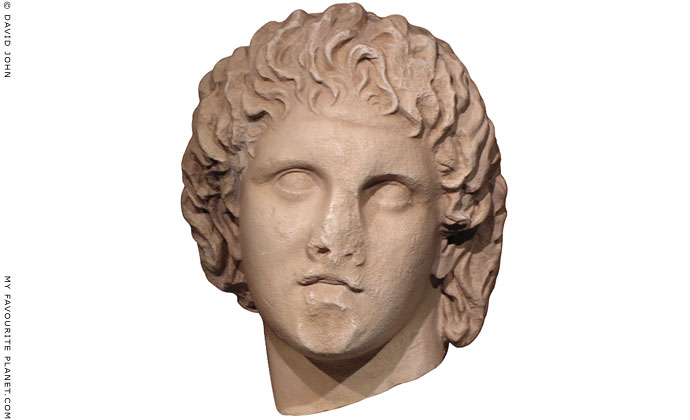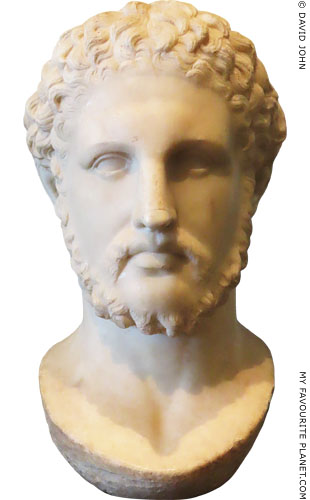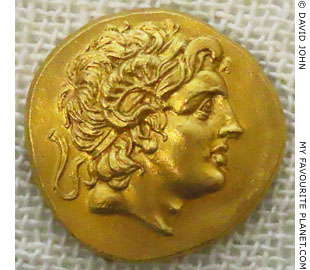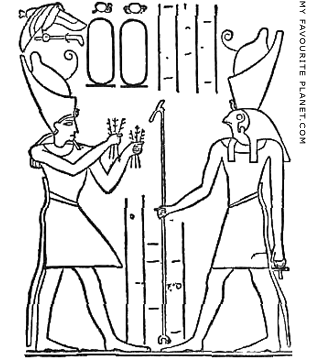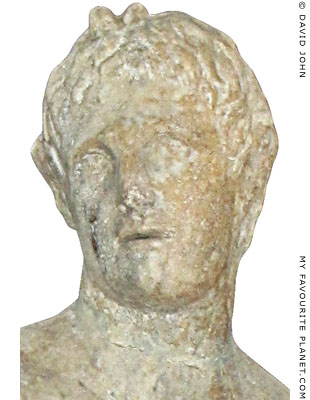Alexander
the Great |
Alexander and coinage |
|
 |
|
| |
 |
|
 |
Two silver tetradrachms minted in Macedonia 336-323 BC,
during the reign of Alexander the Great ("lifetime issues").
Alpha Bank Numsimatic Collection, Athens, Greece.
Both coins and the Celtic coins below shown at the same scale.
|
|
The obverse side (left photo) shows the head of Herakles (Ἡρακλῆς) in profile, facing right, wearing the headdress made from the skin of the Nemean Lion. On some coins of this type the lion's head has more elaborate details and the skin is shown tied around Herakles' throat by its forepaws. On this example the design has been reduced to bold, simple forms.
Herakles was most often depicted with a beard in ancient Greek art and on coins, but heads of a beardless Herakles wearing the lionskin appear on some of the oldest known coins, including electrum hekte (= 1/6 stater) coins of Erythrai (Ἐρυθραί), Ionia, issued around 550-500 BC. Beardless Herakles also appears on Sicilian coins of the 5th century BC, and silver tetradrachms of around 425-405 BC from Kamarina (Καμάρινα), on the south coast of Sicily, have a head of beardless Herakles wearing the lionskin, similar to that on the coins of Alexander. [4] Similar heads also featured on coins of previous Macedonian kings Amyntas III (ruled 393 BC and again 392-370 BC) and his son Perdiccas III (ruled 368-359 BC).
According to theories developed by a number of scholars, the face of Herakles on the coins issued during Alexander's lifetime in Macedonia and other regions he conquered gradually came to resemble portraits of the king himself as he became associated with the invincible hero-god, claimed by Macedonian rulers as an ancestor and founding father. While debate on the matter continues, it seems certain that coins issued by Alexander's successors (the Diadochi) bear portraits of the great king in the guise of Herakles (see photos below).
On the reverse side (right photo) Zeus Aetophoros (Ζευς αετοφόρος, Zeus holding an eagle) is seated on a stool, facing left, holding a sceptre vertically with his left hand, which his held behind him (to the right). On his right hand, stretched out in front of him (to the left), stands an eagle. He is naked to the hips, below which his lower torso and legs are wrapped in a himation (cloak). The lower right leg is drawn back to the right, so that the foot rests behind (to the right of) the left foot. Inscribed vertically to the right: AΛΕΞANΔΡΟΥ (Alexandrou, of Alexander).
In the left field, below the eagle are the marks Λ above a torch (often referred to as a race torch), and below the stool is a cross or star monogram. Coins with these marks are usually said to be from the Macedonian royal mint at Amphipolis, where the majority of Alexander's Macedonian silver tetradrachms are believed to have been minted, made with silver from mines on nearby Mount Pangaion. However, it remains uncertain - yet another subject of debate - where many coins of this type were minted, and it is also thought that at least some of them may be from other Macedonian mints such as the capital Pella and Philippi (on the other side of Pangaion from Amphipolis). [5]
An enormous number of coins of this type have survived and are now in several public and private collections. The Münzkabinett (Numismatic Collection) of the State Museums Berlin (SMB) owns over 1400 from different mints and eras, varying enormously in quality and condition (from excellent to totally corroded). The SMB website has a searchable online catalogue, Münzkabinett - Online Catalogue, with images and details of items in its numismatic collection, including coins displayed in the Bode Museum, Altes Museum and Neues Museum. A search for "Alexandros III tetradrachme" returned 1480 results, the vast majority of which are coins of this type and classified as Macedonian.
It is evident that the die-cutters copying the designs at various locations over many generations varied in artistic and technical skills, as well as the ability to identify and imitate details such as the face and the complex forms of the lionskin headdress. Thus it is not so surprising that non-Greeks who copied such coins (see below) had difficulty imitating the iconography and inscriptions. |
|
| |
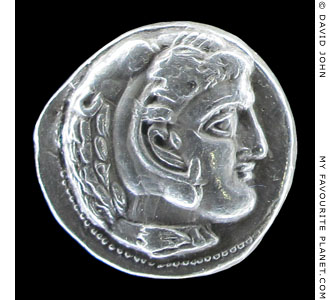 |
|
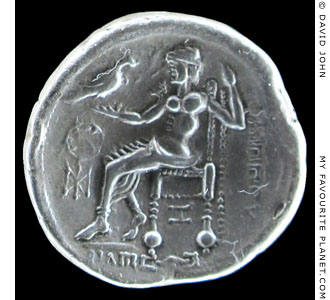 |
Two silver tetradrachms minted by the Eastern Celts in the Danube region,
2nd century BC, imitating designs on Macedonian coins such as those above.
Alpha Bank Numsimatic Collection, Athens, Greece.
|
|
| Greek coins were copied by various peoples beyond Hellenized areas, particularly by Celts and Thracians, often for centuries after they were first circulated. The originals were acquired through trade, by mercenaries who had worked for Greeks (both Philip II and Alexander hired Celtic mercenaries), or as war booty. In some cases, as copies were successively made of copies, the motifs gradually became indistinct or stylized to the point of abstraction, and the original iconography, religious significance and political propaganda messages dissolved. Since many were produced by people who could not read Greek, the inscriptions were often reduced to letter-like forms (i.e. nonsense) or simple shapes such as rows of dots. |
|
| |
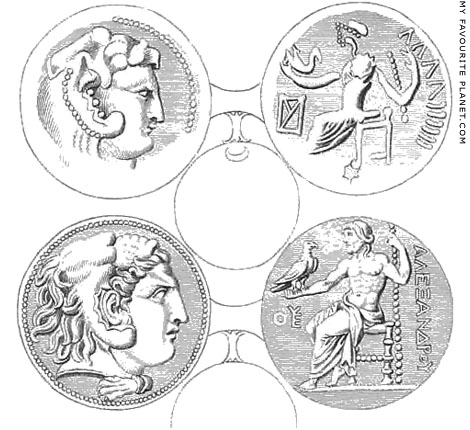
"Two Macedonian medals of the same device; one barberous, the other elegant work."
An engraving after drawings by Nicholas Revett (1720-1804), showing a Macedonian
coin with the head of Alexander/Herakles and Zeus Aetophoros below an ancient imitation.
Source: James Stuart and Nicholas Revett, The antiquities of Athens, measured and delineated,
Volume 3, chapter IX, plate V. John Nichols, London, 1794. At the Internet Archive. |
| |
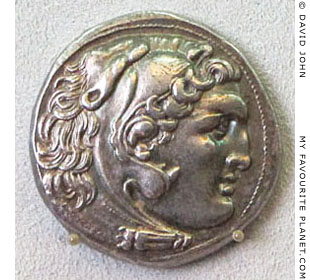
Macedonian silver tetradrachm with a portrait
of Alexander in the guise of Herakles wearing
the skin of the Nemean Lion's head, facing
right. One of the lion's forepaws is shown
below his jaw. The reverse side shows Zeus
Aetophoros and is inscribed AΛΕΞANΔΡΟΥ,
as in the coin above.
Circa 310-275 BC. Minted in Macedonia
or Greece, perhaps during the reign of
Philip III of Macedon (Philip Arrhidaios,
Φίλιππος Γ΄ ὁ Ἀρριδαῖος; reigned
323-317 BC), Alexander's half brother
and successor as king of Macedonia.
Diameter 28 mm, weight 17.11 g.
Münzkabinett (Numismatic Collection),
State Museums Berlin (SMB).
Bode Museum. Inv. No. 18202512.
Purchased in 1875 with the coin collection
of Graf Anton Prokesch von Osten.
See Big Money at The Cheshire Cat Blog. |
| |

Silver tetradrachm of Ptolemy I Soter of Egypt
(reigned circa 305-283 BC), showing the head
of the deified Alexander wearing an elephant
hide, over which is the Uraeus, the serpent
symbol of Egyptian pharoahs, and below
it the aegis of Zeus.
Numismatic Museum, Athens. |
|
|

Head of Alexander the Great wearing
a lion-skin headdress. Pentelic marble,
circa 300 BC. Found in February 1873
at the Dipylon Gates, Kerameikos,
Athens. Height 28 cm.
The Greek letters are thought to be magical
symbols scratched on the head later.
National Archaeological Museum, Athens.
Inv. No. 366.
For decades after its discovery the head
was believed to depict a woman, perhaps
the mythical Lydian queen Omphale.
See: Valerios Stais, Marbres et bronzes
de Musée National, Volume 1, No. 366,
page 71. P. D. Sakellarios, Athens, 1910
(2nd edition). At the Internet Archive. |
| |

Marble statuette of Herakles wearing
the skin of the Nemean lion.
Pentelic marble, 350-325 BC. Height 54 cm.
Found 1885 near Agia Irene church, Athens.
National Archaeological Museum, Athens.
Inv. No. NAM 253.
(Photo taken when the statuette was on loan
to the Numismatic Museum, Athens in 2011.) |
| |
| |
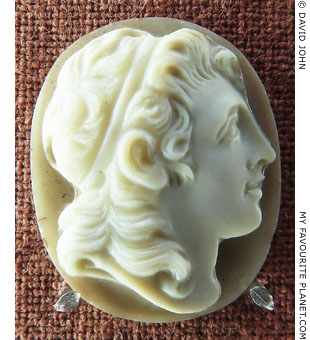
Sardonyx cameo gem with a portrait bust
of Alexander the Great, facing right.
Late Hellenistic period.
Numismatic Museum, Athens.
Collection of K. Karpanos. |
|
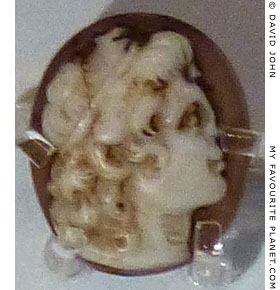
Onyx and chalcedony cameo gem with
a portrait of Alexander the Great.
125-75 BC.
Ashmolean Museum, Oxford.
Inv. No. AN1941.403.
Sir Arthur Evans bequest. |
|
| |
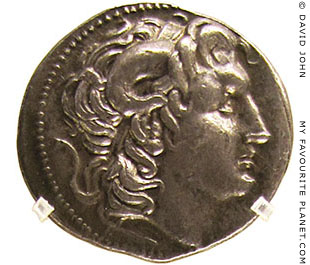
A portrait of Alexander the Great, in profile,
facing right, wearing a diadem (headband)
and the ram's horns of Zeus Ammon, on
a silver tetradrachm of Lysimachus
(Λυσίμαχος, circa 360-281 BC), king of
Thrace 305-281 BC.
Thought to be the earliest depiction of
Alexander the Great wearing ram's horns,
the symbol of the syncretic Egyptian-Greek
god Zeus Ammon. Alexander visited the
sanctuary of Ammon (Amun) at Siwa, in the
Western Desert of Egypt, in 332/331 BC.
This coin type and imitations of it (referred
to as Lysimachi or pseudo-Lysimachi)
continued to be produced at several
Hellenistic mints long after the death
of Lysimachus and into the Roman
period (see below).
Numismatic Museum, Athens.
See also a portrait of Alexander as Zeus
Ammon on an Aboukir medallion below. |
|
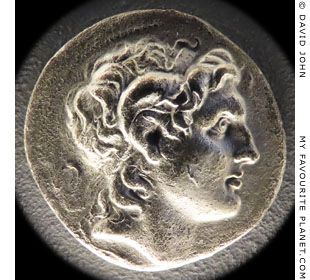
A similar silver tetradrachm of Lysimachus,
minted in Lampaskos, Mysia, 297-281 BC.
New Archaeological Museum
"Arethousa", Chalkis, Euboea. |
|
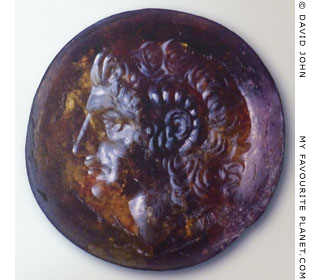
"The Alexander Gem", an elbaite (a rare
variety of tourmaline) sealstone with a
portrait of Alexander the Great wearing
the ram's horns of Zeus Ammon.
325-300 BC. Purchased in Beirut. The tiny
inscription below the neck is carved in
Indian Kharoshti script, suggesting that
the gem was cut in the east of his empire,
perhaps near India. Width 2.4 cm.
Ashmolean Museum, Oxford.
Inv. No. AN1892.1499.
Reverend G. J. Chester bequest. |
|
|
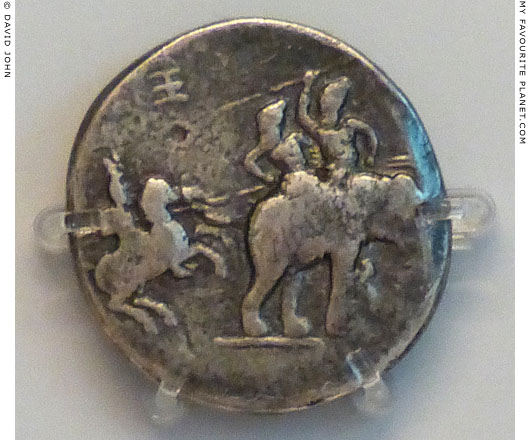
Replica of a silver decadrachm coin showing Alexander fighting King Poros
of Paurava (in present day Pakistan) on an elephant, at the Battle of the
Hydaspes River (today the Jhelum) in May 326 BC. Alexander may have
issued the coins in Babylon, 325-323 BC, to commemorate his victory.
Ashmolean Museum, Oxford. Inv. No. HCR6280.
|
|

Alexander the Great driving a chariot
drawn by four elephants, on a gold stater
of Ptolemy I of Egypt. Minted in Alexandria,
circa 305-298 BC.
Bode Museum, Berlin. |
This type of coin is known as a "Poros medallion" or "Franks medallion", after the historian, museum administrator and collector Sir Augustus Wollaston Franks (1826-1897), who donated the first known example to the British Museum in 1887. It has been suggested that the coin may have been part of a hoard of ancient precious objects known as the "Oxus Treasure", discovered near the Oxus River (the Amu Darya, Afghanistan).
Franks' coin was first published in an illustrated article in The Numismatic Chronicle in 1887, where it was stated that it was "... found two or three years ago at Khullum, in Bokhara, and presented to the British Museum by Mr. A. W. Franks."
The Numismatic Chronicle and Journal of the Numismatic Society, Third Series, Volume VII, "VI. New Greek coins of Bactria and India", pages 177-181. Bernard Quaritch, London, 1887. At the Internet Archive.
The reverse side of the coin shows a standing helmeted figure, believed to be Alexander, holding a spear or sceptre in his left hand and the thunderbolt of Zeus in his left, being crowned by a winged Nike (Victory). The coin type is considered historically important for several reasons, particularly because it may have been minted during Alexander's lifetime, and is thought to depict him fighting in a significant battle on one side, and in the guise of Zeus on the other.
Following Alexander's victory at the Hydaspes, he made Poros (Πῶρος, the name given him by the Greeks; his real name is unknown; Latin, Porus) his satrap in the area, abandoned his military expedition through India and returned westwards to Babylon, where he died three years later.
See: Frank L. Holt, Alexander the Great and the mystery of the elephant medallions. Hellenistic culture and society No. 44. University of California Press, Berkeley and Los Angeles, 2003.
Holt examines numismatic and iconographic aspects of the medallions, their historical and political significance, the circumstances of finds of the coins, including the Oxus hoard and another large hoard found near Babylon in 1972-1973, as well as arguments concerning when, where and for whom they may have been minted. One suggestion is that Alexander authorized them as a special commemorative issue for veterans of his Indian campaign. The inscriptions on the coins (Alexander's name does not appear) and their poor and uneven quality suggest that they were minted "on the road in the East" or at a local rather than royal mint. |
|
|
|
| |
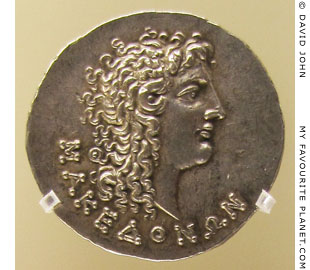
A portrait of Alexander the Great in profile, facing right,
with a ram's horn of Zeus Ammon around his ear. The
obverse side of an "Aesillas coin", a silver tetradrachm
of the Roman province of Macedonia, around 95-75 BC.
Below the head is the Greek inscription ΜΑΚΕΔΟΝΩΝ
(of the Macedonians). Alexander's image was used as
a symbol to encourage the Macedonians in the wars
against King Mithridates VI of Pontus.
Numismatic Museum, Athens. |
| |
Many coins of the "Aesillas" type have been found, individually or in hoards. On the reverse side they are usually inscribed in the Latin alphabet with the name "AESILLAS" and the letter "Q", an abbreviation for Quastor (investigator), a Roman official who, under the governor of the province of Macedonia, supervised the state treasury. It was one of the lowest ranks of public officials and a first career step for young men aged around 27-30 on the cursus honorum (course of offices, see for example the career of Aulus Claudius Charax of Pergamon). A smaller number of surviving coins are inscribed instead with the name of a certain Sura: "SVVRA LEG PRO Q" (Sura Leg[atus] Pro Q[uaestore]; Sura Legate [acting] in the capacity of Quaestor). Nothing is known for certain about either Aesillas or Sura, although there are theories concerning their identities.
Below the inscription, depicted in relief is the club of Herakles standing vertically, flanked by symbols of Roman authority: to the left by a basket with a lid (cista) representing a money chest, or a cista mystica, a religious symbol (see Demeter and Persephone); and to the right by a quaestor's chair (sella). These and the inscription are surrounded by a laurel wreath.
Coins of the Aesillas type are thought to have been minted in Thessaloniki (θεσσαλονίκη, Thessalonike), the capital of the Roman Province of Macedonia (Latin, Provincia Macedonia; Greek, Ἐπαρχία Μακεδονίας, Eparchia Makedonias). They have been traditionally dated to around 94-88 BC, the time of the First Mithridatic War (circa 89-85 BC), although since 1962 these dates have been challenged, and it has been suggested that some may have been minted as late as the 70s or even the 60s BC, presumably long after Aesillas' period as quaestor. New issues may have been struck during the Second and Third Mithridatic Wars (83-81 BC and 75-63 BC).
On the obverse side (shown in the photo above) Alexander the Great has long, wavy hair and a ram's horn of Zeus Ammon around his ear. The style of portrait is very different from those shown on coins since Alexander's lifetime. The artistic quality of the head is not so fine, and the face seems soft and feminine, not at all the regal warrior of earlier coins. As we have seen in examples above, his successors had exploited the strong, youthful features of the king to broadcast their own propaganda messages of power, strength, invincibility, stability and continuity. Coins of the types first minted by Lysimachus of Thrace (see above) continued to be minted at several locations long after his death (e.g. Byzantium, Lysimachia, Parium, Cius and Mytilene), and were still in circulation at the start of the first century BC.
During the First Mithridatic War (89-85 BC) against the Roman Republic and its client states in Anatolia, King Mithradates VI Eupator of Pontus (Μιθραδάτης Στ' Ευπάτωρ; 135-63 BC, reigned 121-63 BC) struck high value gold staters imitating those of Lysimachus and inscribed with his name, BAΣIΛEΩΣ ΛYΣIMAXOY (Basileos Lysimachou, of King Lysimachos).
However, from at least 95 BC Mithradates also issued coins bearing his own portrait which imtitated that of Alexander (see image, above right). The head of the Pontic king, shown in profile, facing right, is depicted as a young man with long, wind-swept hair, wearing a diadem (headband). There appears to be a hint of the ram's horns of Zeus Ammon among his locks.
It is thought that the Aesillas coins may have been designed as a response to these, perhaps imitating them, although it is not certain which were minted first. As is often the case with depictions on coins, it has also been suggested that the Alexander head on the Aesillas coins may have been based on a statue of him, although there appears to be no direct evidence of this. [6] However, statues of Alexander continued to be set up in cities throughout the Roman Empire, including Thessaloniki (see below). |
|
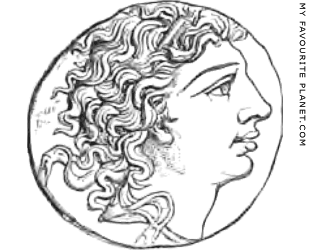
A portrait of King Mithradates VI Eupator
of Pontus in profile, facing right, on a silver
tetradrachm minted in Pergamon, which he
captured during the First Mithridatic War,
89-85 BC. See History of Pergamon.
Image source: woodcut in Henry G. Liddell,
A History of Rome, from the earliest
times to the establishment of the Empire,
page 593. Harper & Brothers, New York, 1859. |
|
| |
Alexander
the Great |
The Aboukir and Tarsus medallions |
|
 |
|
| |

Portrait of Alexander the Great in profile, facing left, wearing a band diadem
and the ram's horns of Zeus Ammon (see above) on a gold Aboukir medallion.
See the reverse side of this medallion and the other
Aboukir medallions in the Bode Museum below.
211-235 AD. Diameter 54 mm, weight 112.66 grams.
Bode Museum, Berlin (Room 242, BM-035/01). Inv. No. 1903/837.
Object No. 18200006. Dressel 1906, A. Purchased in 1902. |
| |
One of twenty large gold medallions discovered in February or March 1902 among a hoard of ancient gold coins in Aboukir (or Abukir), east of Alexandria on the Mediterranean coast of Egypt. They were sold soon after on the art market and are now in four museums: the Walters Art Museum, Baltimore (3 medallions); Bode Museum, Berlin (5); the Calouste Gulbenkian Museum, Lisbon (11); and Thessaloniki Archaeological Museum (1, see below). The Aboukir hoard also included 600 gold Aurei coins from around 222–306 AD, and 18 or 20 bars of gold.
A comparable hoard was found in 1863 (or 1867) in Tarsus (ancient Tarsos, Ταρσός), Cilicia, southern Anatolia (today Turkey), consisting of three similar large gold medallions, two with portraits of Alexander the Great and the third showing Philip II of Macedon, Alexander's father (see below), as well as a large gold medallion of Roman emperor Alexander Severus, issued for his Decennalia of 230 AD, 23 gold Aurei coins minted 72-243 AD, two gold bells (tintinnabula) and jewellery made of gold and lapis lazuli. The four large gold medallions were purchased for 50,000 gold francs in 1868 by agents of Napoleon III and donated by him to the Cabinet des Médailles of the Bibliothèque Imperiale (now the Bibliothèque Nationale de France) in Paris.
The obverse side of each of the twenty three medallions shows one of the following portrait heads: Alexander the Great, Philip II, Alexander's mother Olympias, Apollo, or Emperor Caracalla (reigned 198-217 AD, see below). As is often the case with ancient coins and medals, it is thought that the portraits may have been based on statues. On the reverse sides are depictions of various scenes, some involving Alexander, others featuring Deities (Nike, Athena, Ares, Thetis) and/or fabulous sea creatures.
Although the Tarsus hoard had been quickly accepted as genuine, the exact location and circumstances of the Aboukir hoard's discovery are unknown, and many scholars suspected the medallions were modern forgeries. Following the announcement of the find in March 1902, they were offered to the Bibliothèque Nationale de France and the British Museum, but both institutions turned them down.
However, their authenticity was argued by Heinrich Dressel (1845-1920) director of the Münzkabinett (Coin Cabinet) of the State Museums in Berlin (then still the Royal Museums). In his 1906 publication, Fünf Goldmedaillons aus dem Funde von Abukir (Five gold medallions from the finds from Aboukir), Dressel described all twenty medallions, assigning each a letter from A to U (for some reason there is no medallion J), which became the de facto standard for identifying individual medallions in later publications. The Münzkabinett purchased four (medallions A-D) from the Paris-based Armenian art dealer Mirhan Sivadjian in July 1902, and the fifth (medallion E) in 1903. The others were bought by private collectors, mostly in the United States, and were later acquired by museums. [7]
Due to their varying sizes, weights and gold purity (around 88-96 %), it seems unlikely that the medallions were issued as coins, but are thought to have been minted during the reigns of Roman emperors Elagabalus (218-222 AD) and Severus Alexander (222-235 BC) as gifts for high-ranking guests, officers and officials at the Alexandrian Olympic games, held in honour of the deified Alexander the Great in Macedonian cities such as Veria (225-250 AD). According to another theory, they were awarded in 242-243 AD for victories in the Olympic festival at Veria, attended by Emperor Gordian III (reigned 238-244 AD). They have been referred to as niketeria (νικητήρια, victory medals). |
|
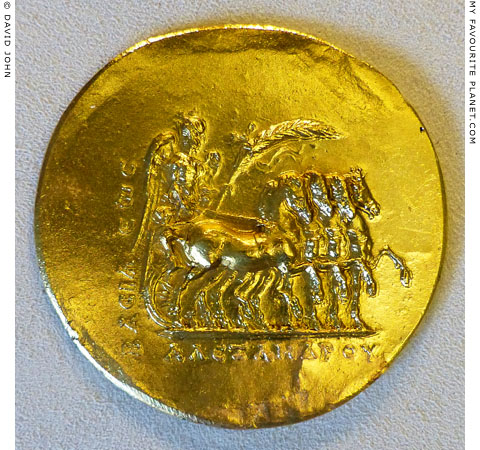
The reverse side of Berlin Aboukir medallion No. 1
(BM-035/01, see above).
Winged Nike, the Greek goddess of victory, driving a quadriga
(four-horse chariot) to the right. She carries a palm branch and
a taenia in her left hand, and holds the reins in the right.
Inscribed to the left and below the quadriga:
ΒΑCΙΛΕωC ΑΛΕΞΑΝΔΡΟΥ
Basileos Alexandrou, King Alexander.
Bode Museum, Berlin.
NOTE: This and the reverse sides of the other Berlin Aboukir
medallions in the photos below are museum copies, exhibited
so that both sides can be viewed by visitors. The copies are
smaller than the originals. |
|
| |
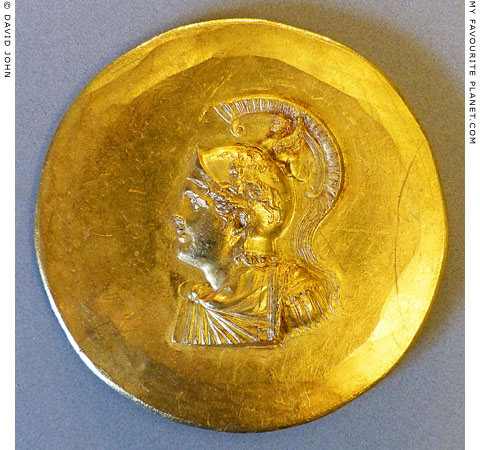 |
|
 |
Berlin Aboukir medallion No. 2.
Obverse side (left): A bust of Alexander the Great in profile, facing left with raised
head, wearing a cuirass covered by a cloak, and a high-crested Attic helmet decorated
with a relief of Artemis riding a bull on the side. The crest is supported by a sphinx.
Reverse side (right): On the left winged Nike, her left foot resting on a helmet, and winged
Eros hold a shield decorated with a relief of two figures (perhaps Alexander and a lover)
clasping hands. On the right, a set of trophy armour (tropaion) with two seated captives.
Inscribed to the left, above and right of the image:
ΒΑCΙ-ΛΕ-ΩC - ΑΛΕ-ΞΑΝΔΡΟΥ (Basileos Alexandrou, King Alexander).
Diameter 60 mm, weight 105.06 grams.
Bode Museum, Berlin (Room 242, BM-035/02). Inv. No. 1905/01.
Object No. 18200012. Dressel 1906, B. Purchased in 1902. |
|
| |
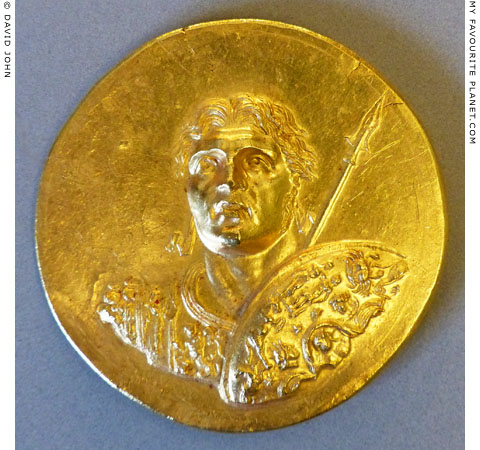 |
|
 |
Berlin Aboukir medallion No. 3.
Obverse side (left): A bust of Alexander the Great, shown frontally with his bare head raised.
He wears a band diadem and a cuirass decorated with reliefs: on the shoulder flap Athena
Promachos, and on the breast a Triton. He holds a spear and a round shield, also decorated
with reliefs. In the central medallion is a bust of Gaia (Earth), above which are the heads of
Helios and Selene (Sun and Moon). Around these are five signs of the zodiac: Aries, Taurus,
Gemini, Cancer and Leo (the period 21st March - 23rd August). The head (and particularly
the hairstyle) has been compared to the marble statue head from Pergamon (see below).
It is thought that the symbolism of the relief figures indicates that this is a depiction of
Alexander as Cosmocrator (see below).
Reverse side: The same as on medallion No. 2 above.
Diameter 56 mm, weight 84.30 grams.
Bode Museum, Berlin (Room 242, BM-035/03). Inv. No. 1907/230.
Object No. 18200016. Dressel 1906, C. Purchased in 1902. |
|
| |
 |
|
 |
Berlin Aboukir medallion No. 4.
Obverse side (left): A bust of Olympias (Ὀλυμπιάς, circa 375-316 BC), mother of Alexander the Great,
in profile facing left, veiled (the back of her head covered with part of her cloak), wearing a diadem
and a bracelet in the form of a snake coiled around the wrist of her raised right forearm. In her hand
she holds a sceptre with a small sphere at the top. This type of portrait of Olympias is known from
other Roman period coins, including late Roman contorniates, (bronze medallions, some now in the
Berlin Münzkabinett, e.g. Inv. No. 1912/306; Object No. 18200661).
Reverse side (right): A naked Nereid (sea Nymph), sitting on her garment and facing left,
rides a fabulous sea monster, the front (left) part of which is a bull, and with the tail of a fish.
Her hair is bound, she wears an armband on the upper left arm, and in her raised right hand
she holds a garland which she is placing around the creature's neck. Among the waves are
two shellfish and two dolphins. The image is similar to several in ancient art, including coins
and mosaics, showing the Nereid Thetis riding a sea creature and carrying the arms made
by Hephaistos to her son Achilles at Troy (see Homer part 2). As Alexander has been
compared to Achilles (and Hephaistion to Patroklos), so Olympias is likened to Thetis.
Diameter 58 mm, weight 81.86 grams.
Bode Museum, Berlin (Room 242, BM-035/04). Inv. No. 1907/229.
Object No. 18200020. Dressel 1906, D. Purchased in 1902. |
|
| |
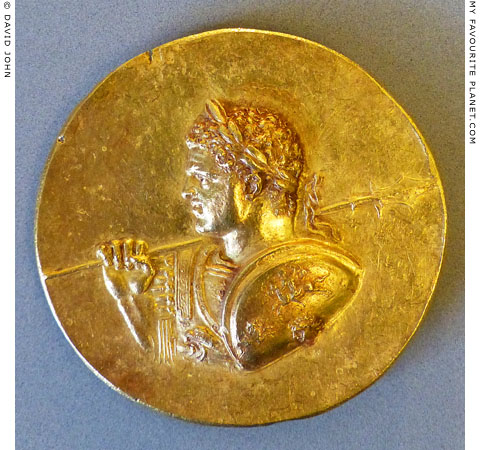 |
|
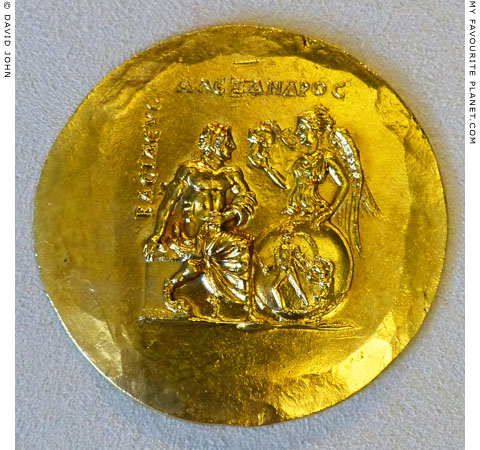 |
Berlin Aboukir medallion No. 5.
Obverse side (left): A bust of Emperor Caracalla (reigned 198-217 AD; see also below),
facing left, wearing a laurel wreath and a cuirass. In his raised right hand he holds
a spear which rests on his right shoulder. He carries a round shield, in the centre of
which is the head of Alexander wearing a diadem facing left, and above it Alexander
with a spear on horseback, hunting a lion. Appearing from behind the left side of
the shield is the head of eagle at the end of a sword hilt.
Reverse side (right): On the left, Alexander the Great seated, wearing a diadem and a
cloak over his lower torso and legs, facing right towards winged Nike, who presents
him with a crested Attic helmet she holds up with her right hand. Her left hand supports
an upright round shield on which is a relief depicting Achilles killing the Amazon queen
Penthesileia (see Homer part 2). This scene is known from other Graeco-Roman artworks,
particularly on sarcophagi. On the left stands the Greek hero, naked, holding a sword in his
right hand. With his left hand he grasps the hair of the Amazon who has fallen to her knees.
Inscribed to the left and above the figures:
ΒΑCΙΛΕVC - ΑΛΕΞΑΝΔΡΟC (Basileos Alexandros, King Alexander).
Diameter 48 mm, weight 65.12 grams.
Bode Museum, Berlin (Room 242, BM-035/05). Inv. No. 1908/3.
Object No. 18200021. Dressel 1906, E. Purchased in 1903. |
|
| |
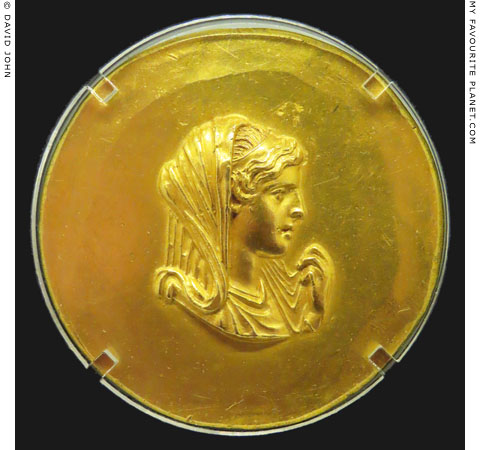
The obverse side of an Aboukir medallion in Thessaloniki, with a depiction
of a veiled bust of Olympias, in profile facing right. She wears a band
diadem, and with her left hand she pulls at the fabric of her veil. The
same die was used to make the obverse of one of the three Aboukir
medallions now in the Walters Art Museum, Baltimore.
On the reverse side is the Nereid Thetis riding a sea monster, made with
the same die as the reverse of Berlin Aboukir medallion No. 4 above.
211-235 AD. Diameter 58 mm, thickness 8 mm, weight 120.06 grams.
Thessaloniki Archaeological Museum. Inv. No. ΜΘ 4304. Dressel 1906, Q.
Purchased at an auction in Basel on 17th November 1962 at the request
of Greek prime minister Konstantinos Karamanlis, and given to the
museum which had opened to the public a month earlier [see note 7]. |
| |
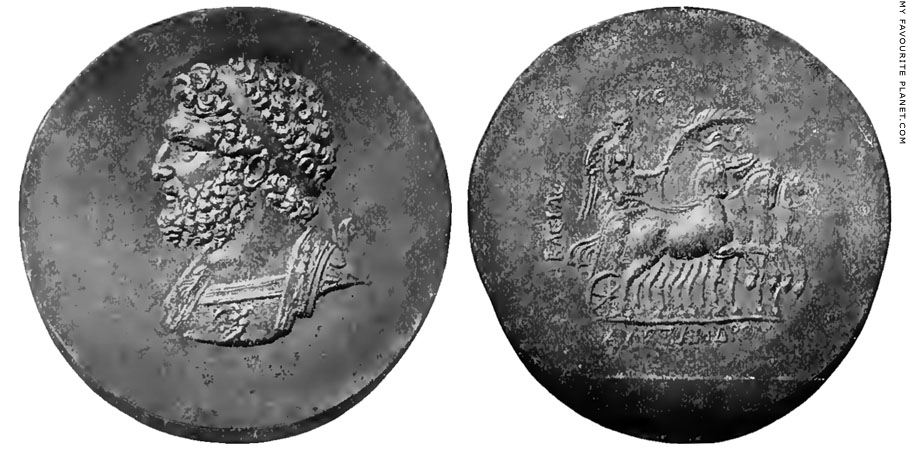
One of the three gold medallions found in 1863 (or 1867) in Tarsus (ancient Tarsos, Ταρσός),
Cilicia, (today southern Turkey), and purchased in 1868 by agents of Napoleon III. On the
obverse side (left) is a portrait bust of Philip II of Macedon, father of Alexander the Great,
facing left, wearing a band diadem and a cuirass (in three-quarter view). On the breast,
Zeus, as an eagle, abducting Ganymede. On each shoulder flap, Nike carrying a shield,
and below a thunderbolt. On the reverse (right), winged Nike, carrying a palm branch and
a taenia, driving a quadriga to the right (as on Berlin Aboukir medallion No. 1 above).
Inscribed to the left and below the quadriga:
ΒΑCΙΛΕωC ΑΛΕΞΑΝΔΡΟΥ (Basileos Alexandrou, [medallion] of King Alexander).
Diameter 64-67 mm, weight 93.85 grams.
Cabinet des Médailles, Paris. Inv. No. 1673.
Image source: Benjamin Ide Wheeler, Alexander the Great: the merging
of East and West in universal history, page 82. G. P. Putnam's Sons,
London and New York, 1900. At the Internet Archive. |
| |
Alexander
the Great |
Alexander sculptures
Portraits of Alexander and sculptures associated with him |
|
 |
|
| |
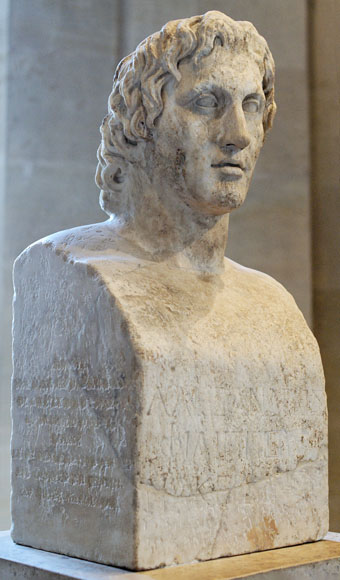
The "Azara Herm", an inscribed marble herm bust
of Alexander the Great.
Roman Imperial period, 1st - 2nd century AD.
Excavated at Tivoli, near Rome in 1779.
Pentelic marble. Height 68.5 cm, width 32.2 cm,
depth 26.5 cm.
Louvre Museum, Paris. Inv. No. Ma 436 (MR 405).
Photo by Marie-Lan Nguyen at Wikipedia Commons. |
|
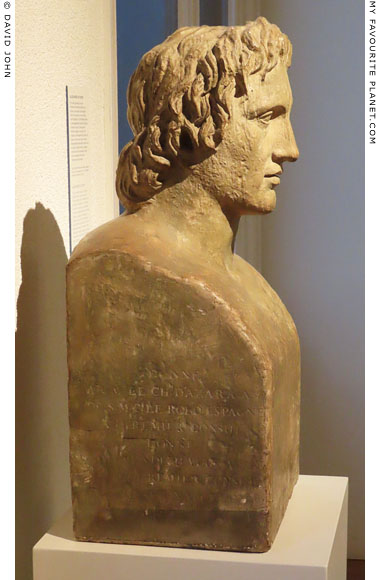
A modern plaster copy of the "Azara Herm",
viewed from the left side on which is an inscription
in French recording Azara's gift of the sculpture to
Napoleon, and the latter's donation to the Louvre.
Part of the University of Amsterdam's extensive
collection of plaster casts of ancient sculptures.
Allard Pierson Museum, Amsterdam. Inv. No. 16073. |
|
| |
The herm and the type of similar portraits of Alexander are named after the Spanish diplomat José Nicolás de Azara (1730-1804), who while ambassador in Rome funded the archaeological excavation of a villa at Tivoli. It was found in 1779 among a number of ancient sculpture portraits of famous men. Later, when ambassador to France, Azara gave it as a diplomatic gift to Napoleon who donated it to the Louvre in 1803. The lips, nose, eyebrows and lower part of the herm bust have been restored, but unlike many other sculptures found in Italy, it has not been over-restored or polished.
This was the first sculpture identifiable as a portrait of Alexander the Great discovered in modern times, and was particularly significant because of the inscription on the front of the herm.
AΛEΞANΔPOΣ
ΦIΛIΠΠOY
MAKEΔ
Alexander, son of Philip, Maced[onian]
Many ancient busts unearthed since the Renaissance have such inscriptions, either ancient or added following their discovery, sometimes with an incorrect identification of the subject. However, scholars appear to be confident that this inscription is genuine and that the bust is a portrait of Alexander based on a Hellenistic original. This has led to the identification of several other heads as portraits of Alexander.
A longer modern inscription, written in Latin on the right side (to the viewer) of the herm bust records its discovery and restoration.
ALEX・M | SIGNVM・IN・TIBURTINO | PISONVM・EFFOSSUM | MDCCLXXIX | IOS・N・AZARA・REST・C
(This representation of) Alexander the Great, discovered in the Pisoni (Villa) in 1779, was restored thanks to Joseph Nicholas Azara. |
|
| |
|
An over life-size marble statue of Alexander the Great, wearing a himation (cloak) around his
left shoulder and lower body, and with his left hand holding the handle of his sheathed sword.
Mid 3rd century BC. Height 190 cm. Excavated in 1895 by K. Buresch at the sanctuary
of Meter Sipylene (Kybele), on the slopes of Mount Syplos, Magnesia ad Sipylum, Lydia
(Manisa, western Turkey). Found with a marble base inscribed with a dedication to
Meter Sipylene, the local mother goddess, and the signature of Menas of Pergamon:
Μηνᾶς Αἴαντος Περγαμηνὸς ἐποίησεν
(Menas Aiantos Pergamenos epoisen)
Menas of Pergamon, son of Aias, made [it]
A date of early 2nd century BC has been claimed for the statue,
based mainly on the letter forms of the inscription. (Margarete Bieber,
The portraits of Alexander the Great, page 393. See details below.)
Istanbul Archaeological Museum. Inv. No. 709. Cat. Mendel 536.
Base with the signature of Menas. Inv. No. 744. Cat. Mendel 537. Inscription TAM V,2 1358.
See: Gustave Mendel (1873-1938), Catalogue des sculptures grecques, romaines et byzantines,
Tome Second, pages 249-254. Musée Impérial, Constantinople (Istanbul), 1914. |
|
| |
|
Marble statuette of Alexander the Great as the god Pan.
From Pella, Macedonia. Around 300-270 BC. Height 37.5 cm.
Pella Archaeological Museum. Inv. No. ΓΛ 143.
The figure has two small horns projecting from the top of the head, pointed ears and a goat's tail, in imitation of the rustic half-goat deity Pan, who was popular in Macedonia. It is presumed that the statuette had cloven hooves which are now missing.
Pliny the Elder ( Natural History, Book 35, chapter 36) wrote that the painter Protogenes, who painted a portrait of Aristotle's mother Phaestis, was advised by the philosopher to paint the exploits of Alexander the Great "as being certain to be held in everlasting remembrance". He appears to have ignored this advice but later painted depictions of Alexander as Pan. |
|
| |

Fragment of a marble statuette of Alexander the Great from Priene.
200-150 BC. Discovered in Priene, Ionia (near Güllübahçe, Turkey) in 1895.
Height 31.6 cm (without arm 28 cm), height of head 12 cm.
Altes Museum, Berlin. Inv. No. Sk 1500.
|
Discovered among other sculptures, terracotta figurines and objects associated with religious sacrifice, in the "House of Alexander the Great", during excavations directed by the German archaeologist Theodor Wiegand (1864-1936) from 1895 to 1899. The house is in a residential area near the western gate of Priene, east of the temple of Kybele (see photo and map below). It is thought that Alexander may have resided there during his stay in Priene during the siege of Miletus in 334 BC. It is also believed to have been used as a hieron (shrine for a deified hero) dedicated to Alexander after his visit, with the northern hall of the building, in which the statuette was found, as the cult room. An inscription from the Sacred Stoa in the agora of Priene, dated to before 130 BC, documents the renovation of an Alexandreion by private donations.
The statuette was acquired by the Berlin museums as part of the division of archaeological finds agreed between the Turkish and German authorities. A fragment of a sword hilt with fingers of a left hand (Inv. No. Sk 1500a), thought to belong to the statuette, is now missing.
See an inscription from Priene below, naming Alexander as dedicator of the temple of Athena Polias. |
|
|
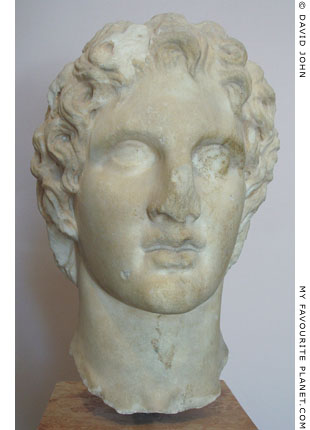
Marble head of Alexander the Great of
the "Acropolis type", found in 1886 near
the Erechtheion of the Athens Acropolis.
Thought to be an original work of the
Athenian sculptor Leochares, made
340-330 BC, perhaps after the Battle
of Chaironeia (338 BC) when Alexander
visited Athens at the age of 18. Either
this or "Erbach type" heads (see right)
represent the earliest surviving portraits
of Alexander. Pentelic marble.
Height 35 cm, width 23 cm.
Acropolis Museum, Athens.
Inv. No. Acr. 1331.
It has been suggested that the statue
of Alexander in the Philippeion at Olympia
(see below) may have been a copy of
this sculpture. |
|
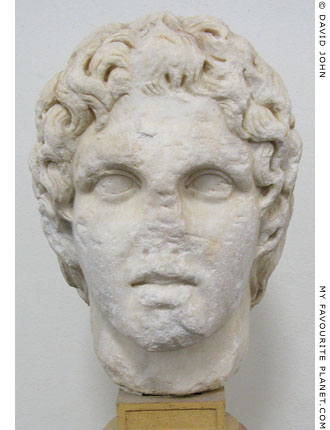
Head of Alexander of the "Erbach type".
Roman period copy of an original from circa
340-330 BC, made perhaps when Alexander
was about 16 years old. Acquired in 1874
in Madytos, Thrace (now Turkey).
The Erbach type is named after the head
found in 1791 at Hadrian's Villa, Tivoli, now
in Schloss Erbach, Germany, Inv. No. 642.
Also known as the "Acropolis-Erbach type"
due to the similarity to the head from the
Athens Acropolis (photo left).
Altes Museum, Berlin. Inv. No. Sk 329. |
|

Marble head of Alexander the Great,
found in 1900 among rubble above the
north hall of the Lower Agora in Pergamon.
The head, along with the rubble, may have
fallen from a building uphill from the agora, perhaps the gymnasium.
1st half of the 2nd century BC. Height 42 cm.
According to one theory, this may be the
head of a giant from the Gigantomachy
frieze of the Great Altar of Zeus.
Istanbul Archaeological Museum.
Inv. No. 1138 T. Cat. Mendel 538.
See Pergamon gallery 2, page 2. |
|
| |
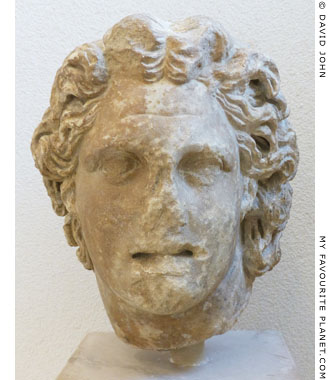
Marble head of Alexander the Great found
at Volantza, near Olympia, Elis, Greece.
Hellenistic, circa 200 BC. Perhaps a copy
of a portrait by Lysippos. Height 37 cm.
The village of Volantza (Βολάντζα) was
renamed Alfeiousa (Αλφειούσα) in 1927,
and may be the location of ancient Bolax
(Βώλαχ), a town of Triphylia in Elis. It is
located south of the river Alpheios (Αλφειός)
and the road between Pyrgos and Olympia,
around halfway between the two places.
Olympia Archaeological Museum.
Inv. No. Λ 246.
Currently exhibited in the Museum of the
History of the Olympic Games of Antiquity,
Olympia. No. 399. |
|
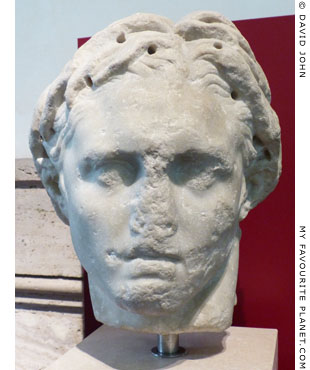
Marble head of Alexander the Great.
Parian marble. 1st century BC.
Found in the portico of the temple
of Hercules, Tivoli, near Rome.
The holes around the top of the head
indicate the attachement of a metal
crown. The find spot suggests that
Alexander was assimilated to
the worship of the god Hercules.
Palazzo Massimo alle Terme,
National Museum of Rome.
Inv. No. 124507. |
|
| |
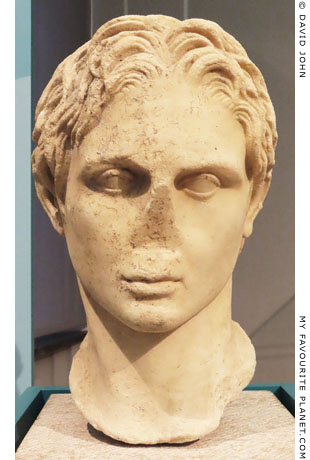
Marble head of Alexander the Great, known
as the "Schwarzenberg Alexander" after
the previous owner, Austrian archaeologist
and collector Erkinger von Schwarzenberg,
who purchased it at Christie’s in 1962. Said
to have been found in Tivoli, near Rome.
In 1967 he wrote the first account of the
head, arguing that it is from a copy of a
portrait staue of Alexander with a lance by
Lysippos, mentioned by Plutarch (Moralia,
335F; 360D). This claim has been generally
accepted, [8] although other identifications
have since been suggested, including
Mithridates VI Eupator of Pontos.
Roman period, early 2nd century AD.
Height 35.5 cm. Slightly larger than lifesize.
Staatliche Antikensammlungen und
Glyptothek, Munich. Inv. No. GL 559. |
|
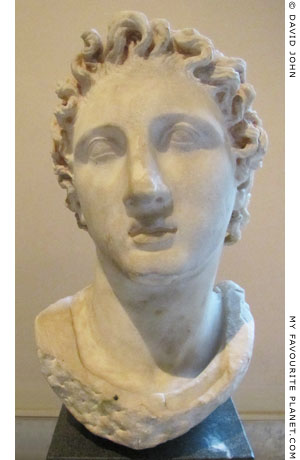
Marble head of Alexander the Great
from Kyme (Namurt, Turkey). Found
during excavations by Demosthenes
Baltazzi in 1887 [9]. Height 43.5 cm.
At first thought to depict Apollo. The
holes drilled around the top of the
head have led to its identification
as Helios or Alexander-Helios.
Hellenistic, late 3rd century BC or,
according to other theories, circa
125-75 BC. also tentatively linked to
Mithridates VI Eupator of Pontos, in
the context of his war against Rome,
the First Mithridatic War 89–85 BC.
Istanbul Archaeological Museum.
Inv. No. 388 T. Cat. Mendel 597. |
|
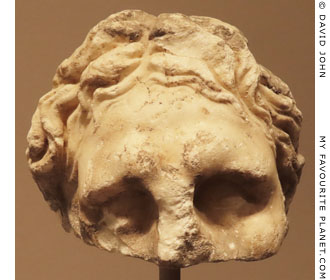
Part of a larger than lifesize marble head from
a statue, possibly of Alexander the Great.
Late 4th century BC.
Kos Archaeological Museum. |
|
| |
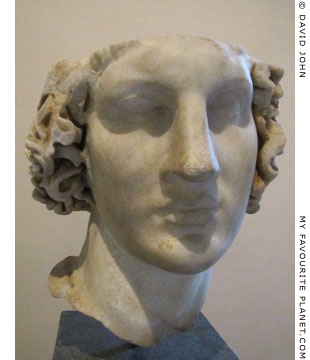
A marble head of Alexander the Great
found in 1904 in the Asklepieion of Kos.
Hellenistic, circa 150 BC. Height 31.5 cm.
Istanbul Archaeological Museum.
Inv. No. 1524 T. Cat. Mendel 539. |
| |
The larger than lifesize head was found on 19th September 1904 during excavations by the German archaeologist Rudolf Herzog (1871-1953) in the Asklepieion of the Dodecanese island Kos (see Asklepios). It was uncovered on the upper terrace of the sanctuary, at the east side of Temple A, near its southeast corner. Directly after its discovery, the head was taken to Istanbul. Three days later, on 22nd September parts of a marble statue of a draped male figure were found at the south side of the temple. It is not known whether the fragments belonged with the head since, although they were given the inventory numbers Nr. 251-3 and 257-260 of the Kos museum, they were not studied, and disappeared some time after.
The top of the head is broken off around the level of mid-forehead. He originally wore a helmet, part of which can still be seen at the back of the head (see photo, right). A reconstruction model made in Berlin (see photo, below right) showed him with an anachronistic Corinthian helmet perched on his head in the manner of Classical portraits of Greek generals such as Pericles (see Kresilas). This was defended by the German-American archaeologist Magarete Bieber (1879-1976), who cited the marble nude statuette of Alexander from Gabii, Latium (Flavian period, 69-96 AD), now in the Louvre, showing him wearing a Corinthian helmet. A number of scholars were sure that the head - and presumably the helmet - belonged to the statue.
See:
Magarete Bieber, Ein idealisiertes Porträt Alexanders des Großen. In: Jahrbuch des Deutschen Archäologischen Instituts, Band 40 (1925), pages 167-182. Walter de Gruyter, Berlin und Leipzig, 1926. At Heidelberg University Digital Library. Photos of the head and the reconstruction, right, Figs. 3 and 5.
Margarete Bieber, The portraits of Alexander the Great. In: Proceedings of the American Philosophical Society, Volume 93, No. 5 (November 30, 1949), pages 373-421 + 423-427, particularly pages 391-392, figs. 49-50 and 51-52. At jstor.org.
Magarete Bieber commented that the head "seems to represent Alexander as saviour" (Σωτειρα, Soteira), and in the former article (Jahrbuch, 1925) rejected suggestions that it may be a portrait of one of Alexander's successors (the Diadochi), such as Mithradates VI (see above), or even the mythical doctor Machaon, son of Asklepios. She also speculated that it may have belonged to a statue mentioned in a lost work of the second century BC Greek poet and physician Nikander of Colophon (Νίκανδρος ὁ Κολοφώνιος):
"Another idealized portrait of Alexander from the island of Cos, now in Constantinople (Istanbul), about one-third more than life-size, seems to represent Alexander as saviour. This head was found on a terrace dedicated first to Apollo and later to Asklepios. With it were found fragments of a statue to which it belonged, now lost. It was probably the one beheld in the second century by Nikander, as reported by Karystios of Pergamon (in Athenaeus XV, p. 684 E), who saw the ambrosia plant, a symbol of immortality, growing on the head of the figure. Such a plant might well have taken root in the eye opening of the now lost helmet." (page 391)
The lost passage of Nikander was quoted by the late second century BC Greek grammarian Karystios of Pergamon (Καρύστιος) in his Historical Commentaries (or Historical Notes, Ἱστορικα ὑπομνήματα), also now lost, but passed on to us by Athenaeus of Naucratis (Ἀθήναιος ὁ Nαυκρατίτης), writing in the second - third century AD.
"There is also a flower spoken of under the name of ambrosia by Carystius, in his Historical Commentaries, where he says: 'Nicander says that the plant named ambrosia grows at Cos, on the head of the statue of Alexander.' But I have already spoken of it, and mentioned that some people give this name to the lily."
Athenaeus, The Deipnosophists, Book 15, pages 680-692, chapter 32. At attalus.org.
In 1888, nearly two decades before the Asklepieion and the marble head were discovered on Kos, William Roger Paton (1857-1921) was on the island "hunting for inscriptions". In his The inscriptions of Cos, he referred to the passage by Athenaeus (including the quotation only in Greek as a footnote), and speculated on the statue's appearance:
"That there was a statue of Alexander at Cos, we happen to know, because of a curious story which was told of it. It was doubtless a bronze figure, in the manner of Lysippus, the hair having a certain dishevelled wildness: in one of its furrows, it seems, a seedling lily had found soil enough to grow in."
William Roger Paton and Edward Lee Hicks, The inscriptions of Cos, Introduction, page xxx. Clarendon Press, Oxford, 1891. At the Internet Archive. |
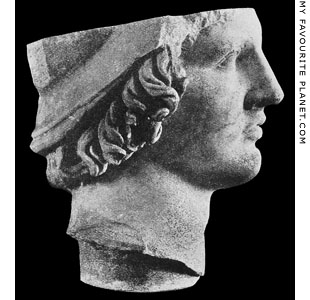
The right side of the Alexander head
from Kos, showing the remains of the
helmet at the back. |
| |
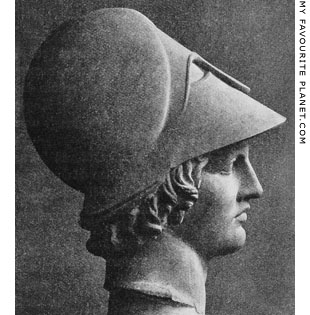
A reconstruction of the head from Kos,
with an added Corinthian helmet. Made
at the state museums, Berlin, under the
supervision of Professor Bruno Schröder. |
| |
| |
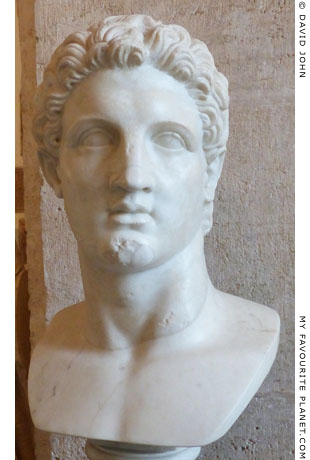
Colossal marble head of Alexander the Great.
Greek marble. Found in Piperno Vecchio
(ancient Privernum, Latium; today Priverno),
Lazio, central Italy in April 1831. Given to
the Capitoline Museum in 1839. Perhaps
a Hellenistic original. Greek marble.
Height 64 cm, with foot 81.5 cm. [10]
Galleria, Palazzo Nuovo,
Capitoline Museums, Rome.
Inv. No. MC532. |
|

"Male head after a Greek original
of the 4th century BC."
Sala del Fauno, Palazzo Nuovo,
Capitoline Museums, Rome.
Inv. No. MC701.
From the Albani Collection. |
|
| |
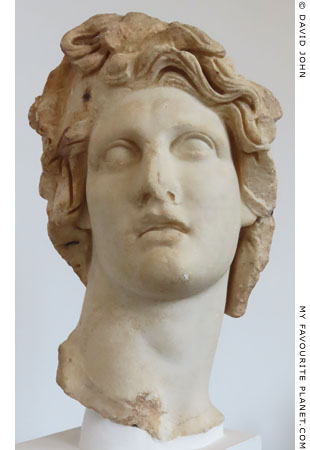
Marble head of Helios from Rhodes, in the
style of portraits of Alexander the Great.
Perhaps from the pediment of the sun god's
temple in the ancient city. Thought to have
been modelled on a work by Lysippos.
Holes were drilled around the hairline for
attaching metal rays of his solar crown.
Hellenistic period, 3rd century BC. Found
behind the "Inn of Provence" of the citadel
of the crusading Knights of the Order of
Saint John in Rhodes Old Town, perhaps
the location of the temple. Height 55 cm.
Rhodes Archaeological Museum.
Inv. No. E 49. |
|

Marble head of Alexander the Great
as the Greek sun god Helios (Ἥλιος).
1st century AD, "after a Hellenistic original of
the 3rd-2nd century BC" [11]. Height 58.3 cm.
The lower part of the front of the nose and
the bust have been restored. The identification
of the head as Alexander-Helios is based on
seven holes drilled around the top, thought
to have supported metal solar rays. Probably
one of the antiquities ceded by Pope Pius V
to the municipality of Rome in 1566. Taken to
the Louvre, Paris by Napoleon, following the
Treaty of Tolentino in 1791, and returned to
the Capitoline in 1816. In 1817 it was moved
from Stanza del Fauno (Hall of the Faun)
to the Sala del Galata (Hall of the Gaul,
then known as the Stanza del Gladiatore,
Hall of the Gladiator).
Sala del Galata, Palazzo Nuovo,
Capitoline Museums, Rome.
Inv. No. MC732. From the Vatican. |
|
| |
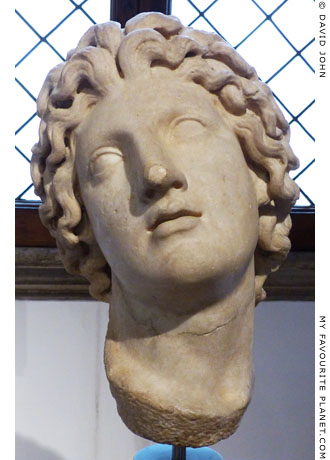
Head of Alexander the Great.
2nd or 3rd century AD, "copy after a
Greek original of the late 4th century BC"
attributed to Euphranor [12]. Pentelic
marble. Height 45 cm.
Barracco Museum, Rome. Inv. No. MB 157.
See also the "Alexander Rondanini"
statue below. |
|
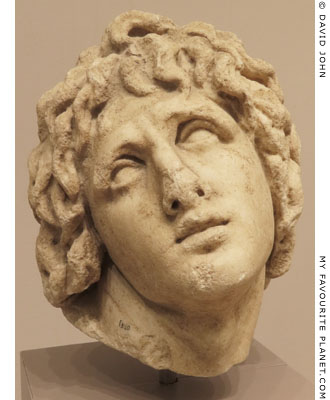
Marble head, described by Kos museum
labelling as a "wounded warrior".
Hellenistic period, 2nd century BC. Found
near the temple of Herakles Kallinikos,
in the ancient Agora of Kos.
Kos Archaeological Museum. Inv. No. Γ 3160. |
|
| |

Marble head of a statue of Alexander the
Great from the Court of the Passage of
the Theoroi, at the northeast edge of
the agora of Thasos, Greece.
2nd century AD. Thasian marble. Height 41 cm,
width 30 cm, depth 29 cm.
The findspot is above the foundations of a late
4th century BC temple, which may have been
an Alexandreion. Thasos was one of the first
cities to worship Alexander as a god. An
annual Alexandreia festival (Ἀλεξάνδρεια)
was held there on his birthday. [13] This
head features one of the most obvious
examples of the "anastole" hairstyle
characteristic of several portraits of Alexander.
Thasos Archaeological Museum. Inv. No. Λ3719. |
|
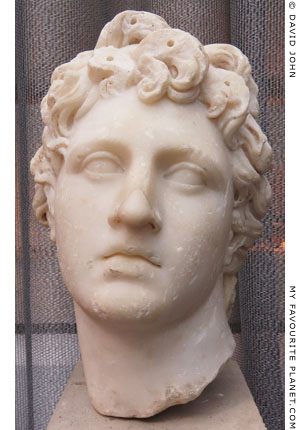
Marble head of a young man of
the type of Alexander the Great.
Mid 2nd century AD. Provenance unknown.
Thessaloniki Archaeological Museum.
Inv. No. MΘ 22117.
Purchased at an auction at Christie's,
London in 1996 by the Greek Ministry
of Culture, and donated to the museum. |
|

"Head of a man with characteristics
of Alexander the Great."
Marble. Smaller than life-size. Roman
period? Found on the Mon Repos estate,
Corfu, in the area now known as
Palaiopolis (Παλαιόπολης, Old City), site
of the ancient city Korkyra (Κόρκυρα).
Mon Repos Museum, Corfu. |
|
| |
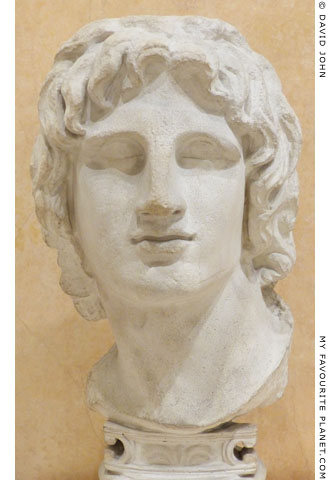
Plaster cast of the marble head of Alexander
the Great in the British Museum.
University of Leipzig Museum of Antiquities.
Inv. No. G 30.
The original is from Alexandria, Egypt.
2nd - 1st century BC. Height 37 cm.
British Museum. Inv. No. 1872,0515.1
(Sculpture 1857). Acquired in Alexandria, 1872. |
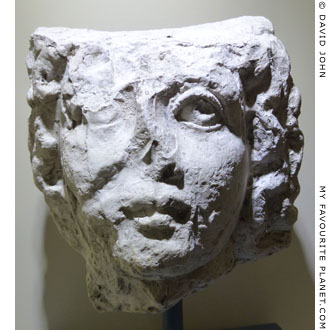
Plaster cast of a "head of the type
of Alexander the Great (?)".
Perhaps 1st century AD. The original was
discovered during excavations at Medinet Madi,
Egypt, 1935-1939 by the papyrologist Achille
Vogliano (1881-1953) of the University of Milan.
Medinet Madi, in the southwestern Fayum
region of Egypt, was known to the Greeks as
Narmouthis (Νάρμουθις). During the Ptolemaic
period a chapel (or cenotaph) for the worship
of Alexander was dedicated there.
CMA Milano. Inv. No. E 0.9.40449.
Temporary exhibition: Milano in Egitto: Gli scavi
di Achille Vogliano nel Fayum (Milan in Egypt:
The excavations of Achille Vogliano in Fayum),
Civic Archaeological Museum, Milan,
17 May - 15 December 2017,
extended until 13 May 2018.
Unfortunately, the museum provides little
information about this head, and no
indication of the location of the original. |

Gilded bronze head of Alexander the Great.
2nd century AD. Height 18.5 cm.
Palazzo Massimo alle Terme,
National Museum of Rome.
Inv. No. 66177.
From the Kircherian Museum. |
|
| |
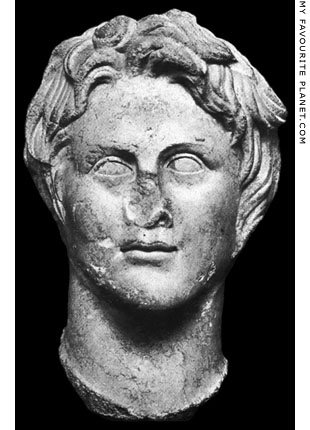 |
|
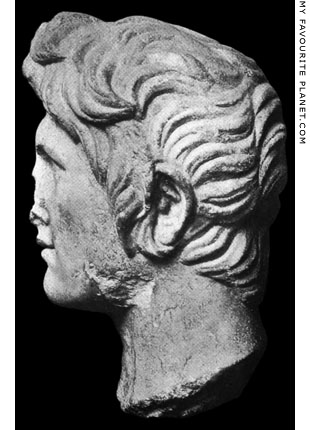 |
A marble head of Alexander the Great in Dresden,
known as the "Dresselscher Kopf" (Dressel Head).
Thought to be a Roman period copy of a Greek original
of around 325-300 BC by Lysippos. it was acquired in
Rome in 1885 from the Dressel Collection. Height 39 cm.
Staatliche Kunstsammlungen, Dresden. Inv. No. Hm 174.
Source: Anton Hekler, Greek and Roman portraits, plate 60.
G. P. Putnam's Sons, New York, 1912. At the Internet Archive.
Until recently, the head had not been on display since 2002.
See below. |
|
| |
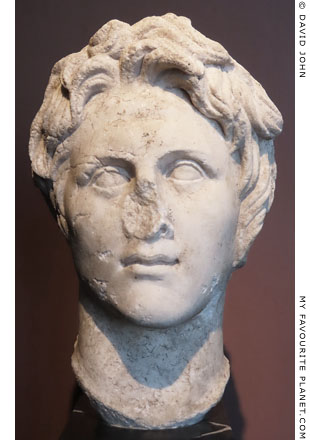 |
|
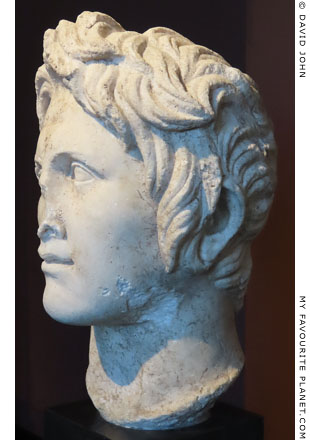 |
A marble head of Alexander the Great in Dresden,
known as the "Dresselscher Kopf" (Dressel Head).
1st or 2nd century AD. Thought to be a Roman period copy of a Greek
original of around 325-300 BC by Lysippos. Acquired in 1885 from the
collection of Heinrich Dressel in Rome. Thasian marble. Height 39 cm.
Staatliche Kunstsammlungen, Dresden. Inv. No. Hm 174.
Now on display again in the recently opened Antikenhalle
(Hall of Antiquities) of the Semperbau, Dresden. |
| |
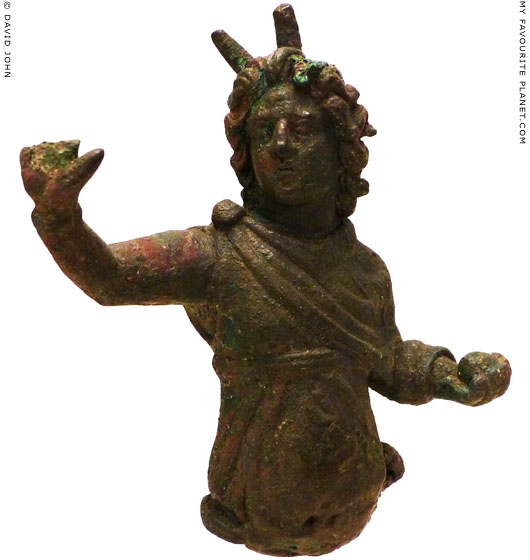
Part of a copper alloy statuette from Egypt depicting
Alexander the Great as Cosmocrator Helios.
Cosmocrator Helios was one of the syncretic deities introduced by Greek rulers
of Egypt as part of the Hellenization of Egyptian religion and the religious-
philosophic system of astrology developed during the Hellenistic period.
The name Cosmocrator (Κοσμοκράτωρ, Kosmokrator) has been interpreted as
ruler of the known world (kosmos) or master of the universe. Roman emperors
were also depicted as Cosmocrator Helios, the incarnation of imperial power.
National Archaeological Museum, Athens. Egyptian Collection, Inv. No. X198. |
| |
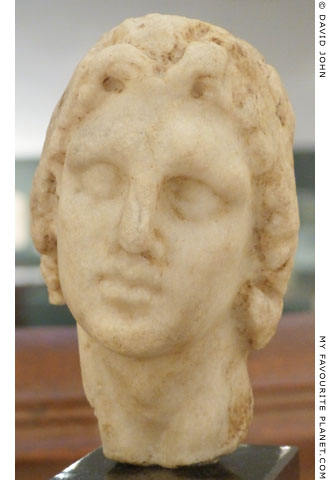 |
|
 |
A small marble head of a statuette of Alexander the Great.
From Alexandria, Egypt. 200-175 BC. Height 13 cm, width 8.2 cm, depth 9 cm.
A hole in the top of the head is thought to have been for the attachment
of a crown or emblem of an Egyptian deity. On the right is a plaster cast
of the head with a reconstruction of a divine emblem.
University of Leipzig Museum of Antiquities. Inv. No. 99.037.
Donated by E. P. Warren and J. S. Marshall, 1908.
A similar small head of Alexander head with a star symbol attachment,
referred to as "Alexander as Kosmokrator", is in the National Museum
of Denmark, Copenhagen. See the photo at livius.org. |
|
|
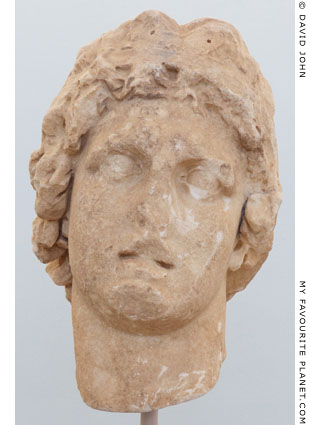
Marble head of a colossal statue of
Demetrios Poliorketes (Δημήτριος
Πολιορκητής, Demetrios the Besieger, 337
-283 BC), king of Macedonia (294-288 BC),
in the style of portraits of Alexander the
Great. He originally wore an attached
diadem and goat's horns on the forehead.
3rd century BC. From the Dodekatheon,
(Δωδεκάθεον, Temple of the Twelve
Olympian Gods), Delos. Height 54 cm.
Delos Archaeological Museum.
Inv. No. A 4184 + A 197. |
|
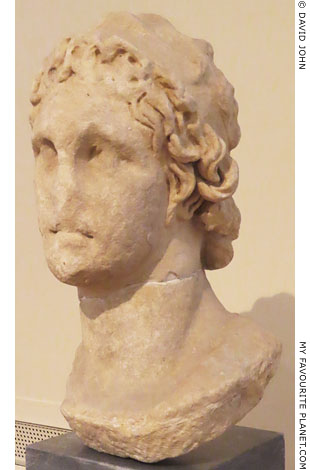
Marble portrait head from a statue of a
ruler wearing a diadem. Perhaps Alexander
the Great or Mithridates, king of Pontos.
125-100 BC. Pentelic marble. From
the Sanctuary of Apollo, Delos.
National Archaeological Museum,
Athens. Inv. No. 429. |
|
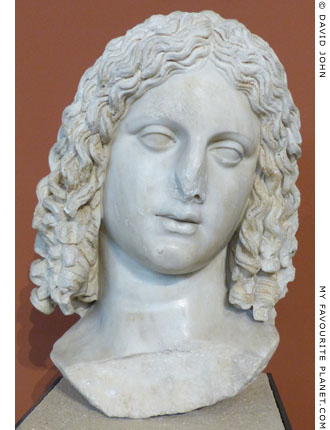
Marble head thought to be a portrait
of Alexander the Great.
175-200 AD. Found in the area of the ancient
agora of Thessaloniki. Perhaps part of a group
of cult statues of the family of Alexander in
the city. The work was previously described
as "head of a woman".
The style of representation, with almost
feminine features and long wavy hair, parted
in the centre, are reminiscent of the depiction
of Alexander on the earlier Macedonian coins
of the Roman Republican period (see above),
and of Medieval or Renaissance sculptures.
Thessaloniki Archaeological Museum. |
|
| |
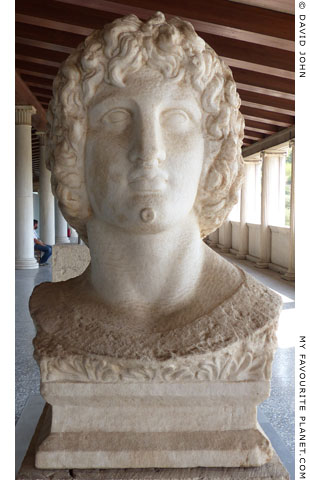
Bust of Alexander or Eubouleus, a god
connected with the Eleusinian Mysteries
(see Demeter and Persephone part 2).
Unfinished 2nd century AD copy of a work
of the 4th century BC. Discovered in 1959
by Dorothy Burr Thompson in the Athens
Agora. Thasian marble. Height 61 cm, height
of base 12 cm, width (at shoulder) 39 cm.
Agora Museum, Athens. Inv. No. S 2089.
A similar marble bust thought to depict
Eubouleus, found in Eleusis and dated
to around 330-320 BC, is in the National
Archaeological Museum, Athens. Inv. No. 181. |
|

Bust of the sun god Helios with drilled holes
for a solar-ray crown. When first discovered
it was thought to be possibly a portrait of
Alexander. It has been described as being
"related to the so-called Eubouleus type".
2nd century AD. Found 31 July 1970 during
excavations by John McK. Camp II in a well
(Deposit P 21:2) in the east colonnade of the
peristyle of a large late Roman complex
known as Roman House H, on the slope of
the Areopagus, south of the Athens Agora.
Pentelic marble. Height 52.3 cm.
Agora Museum, Athens. Inv. No. S 2255.
Among other ancient objects found in
the well was a marble head of Nike. |
|
| |
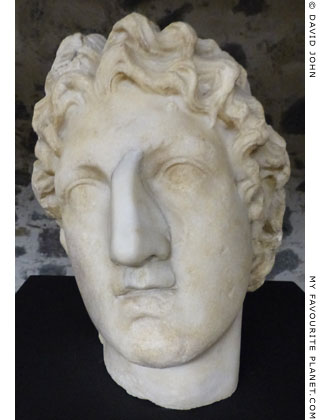
Marble head, with reconstructed nose
and upper lip, thought to be a portrait
of Alexander the Great.
Museo Civico, Castello Ursino, Catania,
Sicily. From the Biscari Collection. |
|

"Fragment of a head in the style of
depictions of Alexander the Great."
Late 3rd century AD.
Skulpturensammlung, Albertinum,
Dresden. Inv. No. ZV 4032.
See also the "Dresselscher Kopf"
of Alexander in Dresden above. |
|
| |
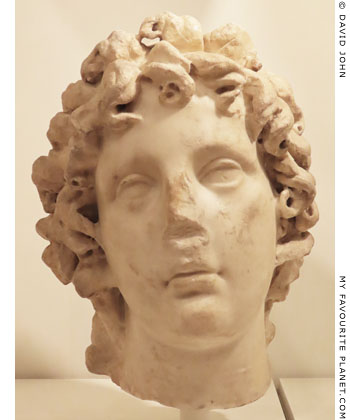
Marble head "of a young god" in the style of
portraits of Alexander the Great. Perhaps Apollo.
Behind the prominent locks the hair around the
crown of the head is tied with a fillet (headband).
Around 150-200 AD. From the vicinity
of Naples, Italy. Height 26.5 cm,
width 20.0 cm, depth 20.0 cm.
Allard Pierson Museum, Amsterdam.
Inv. No. 1792.
Catalogue no. 94, pages 77-78, plate 43, a-c.
According to the Catalogue Inv. No. 1793. [14] |
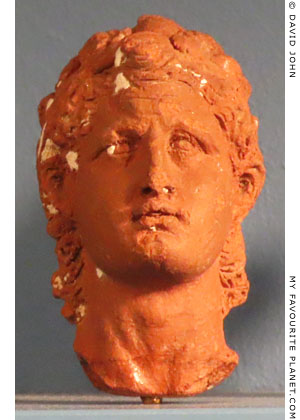
Small ceramic head of Ptolemy I in the
style of portraits of Alexander the Great.
Early 3rd century BC. From Memphis,
Egypt. Height 5.9 cm.
Allard Pierson Museum, Amsterdam.
Inv. No. 7431. |

Terracotta votive head "with
features of Alexander the Great".
Hellenistic period, around 330-250 BC.
From Etruria, Italy. Height 28 cm.
Allard Pierson Museum, Amsterdam.
Inv. No. 3421. |
|
| |
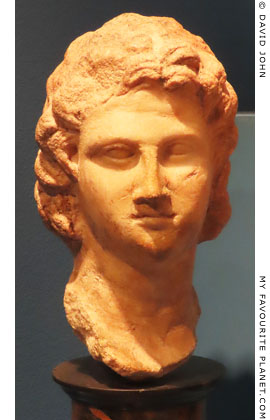
Marble head in the style of portraits
of Alexander the Great, made to be
inserted into a statuette or bust.
3rd century BC. Provenance unknown.
Perhaps made in Greece, possibly
Athens. Half life-size. Height 16.2 cm,
width 8.9 cm, depth 10.5 cm.
Allard Pierson Museum, Amsterdam.
Inv. No. APM 1613.
Catalogue no. 56, pages 51-52,
and plate 25, c-e [see note 14]. |
|
 |
|
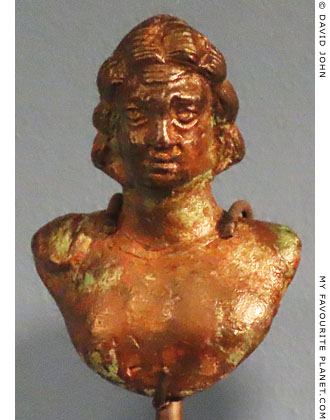 |
| |
Two small marble heads and a bronze (?) bust in the style of portraits of Alexander the Great,
displayed unlabelled in the "Hellenistic Cabinet" of the Allard Pierson Museum, Amsterdam. |
|
| |
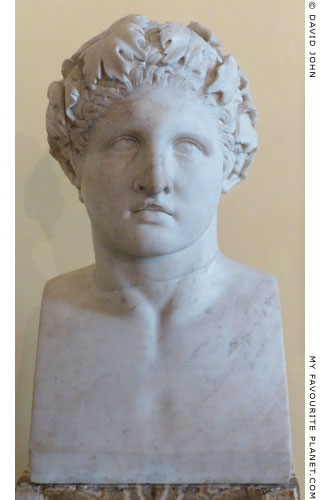
Marble herm bust in the Palazzo dei
Conservatori, Capitoline Museums, Rome. |
|
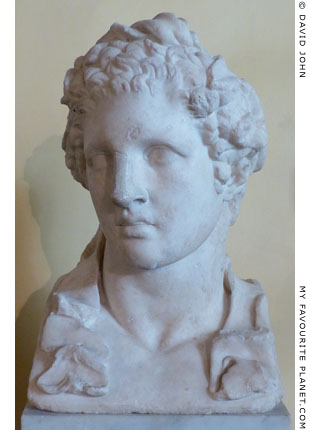
Marble herm bust of a young beardless male
wearing a poplar crown. 1st-2nd century AD.
Perhaps derived from a statue of Herakles
by Skopas, 4th century BC. Found in 1876
on the Quirinal Hill, Rome. Pentelic marble.
Height 45 cm, width of herm (at base)
12.5 cm, length of herm (at base) 29.5 cm.
Palazzo dei Conservatori, Capitoline
Museums, Rome. Inv. No. S1133. |
| |
These two marble herm busts, now in the Sale Castellani of the Capitoline Museums' Palazzo dei Conservatori, have been placed either side of the bronze horse associated with Lysippos (see below). They are not labelled, and so far we have found no reference to them in the museum's online database. Another source identifies the left bust as Alexander without giving further details.
The bust on the right was briefly discussed in an article about the "Herakles of Skopas" written by Botho Graef in Rome in 1889. According to Graef the bust, first mentioned in Bullettino Municipale IV (1876), page 217.9, and another similar bust in the Capitoline Museums were derived from a stone statue of Herakles made by Skopas in the first half of the 4th century BC for the gymnasium in Sikyon, mentioned by Pausanias (Description of Greece, Book 2, chapter 10, section 1). This identification was challenged by, for example, Henry Stuart Jones, who suggested the subject may have been a marble statue of Dionysus by Skopas at Knidos (Κνίδος) in Caria, mentioned by Pliny the Elder (Natural history, Book 36, chapter 4). It should be noted that neither Pausanias nor Pliny described the respective statues, so attempts to identify them remain pure speculation.
See:
Botho Graef, Herakles des Skopas und verwandtes. In: Mitteilungen des Deutschen Archäologischen Instituts, Römische Abteilung, Band 4, 1889, pages 189-226, particularly pages 190-191 and Tafel (plate) IX.
Henry Stuart Jones, A catalogue of the ancient sculptures preserved in the municipal collections of Rome: The sculptures of the Palazzo dei Conservatori (Volume 2 of 2, text; Volume 1 contains the plates), "Youthful male herm, so-called Scopaic Heracles", Sala degli Orti Lamiani No. 7, pages 130-131 and plate 47; similar bust, "Herm of a young Dionysus", Galleria No. 28, pages 90-92, plate 33. Clarendon Press, Oxford, 1926. Both volumes online at Heidelberg University Digital Library. |
|
|
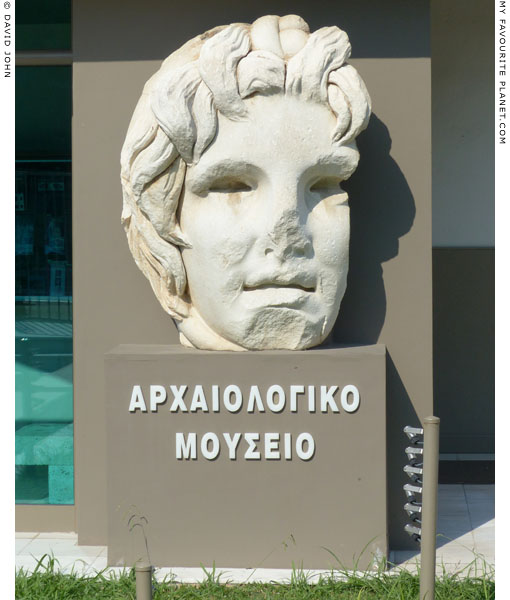
A colossal marble head, thought to be a Gorgoneion,
dated to the first half of the 2nd century BC, at the entrance
to the Veria Archaeological Museum, Macedonia, Greece.
The largest Gorgon head found in Greece, thought to have been attached to the northern
defensive walls of ancient Veria (Βέροια) as an apotropaic symbol to scare off attackers.
The features of the head, particularly the hairstyle, resemble those of Alexander the Great. |
| |
| New portrait of Alexander the Great found in Veria |
| |
A marble head, believed to be a portrait of Alexander the Great and dated to the 2nd century BC, has recently been rediscovered in the storerooms of the Veria Archaeological Museum. The battered head had been stored and forgotten among other finds recovered by archaeologists some decades ago at a nearby village, where it had been built into a wall in the 18th or 19th century. The find was first announced on Facebook on 31 July 2019 by Angeliki Kottaridi (Αγγελική Κοτταρίδη), Director of the 17th Ephorate of Prehistoric and Classical Antiquities (prefectures of Imathia and Pella), the 11th Ephorate of Byzantine Antiquities and four local museums: the archaeological museums of Veria, Pella and Vergina (Aigai), and the Veria Byzantine Museum.
See: facebook.com/angeliki.kottaridi/posts/2578000048901128 (in Greek, with photo)
Now cleaned and restored, the head is due to be exhibited at the end of 2020 in the Museum of the Macedonian Royal Tombs in Vergina. I, for one, hope it will find a permanent home in the excellent Veria Archaeological Museum, which could do with such a "star" exhibit in order to attract more visitors. |
|
|
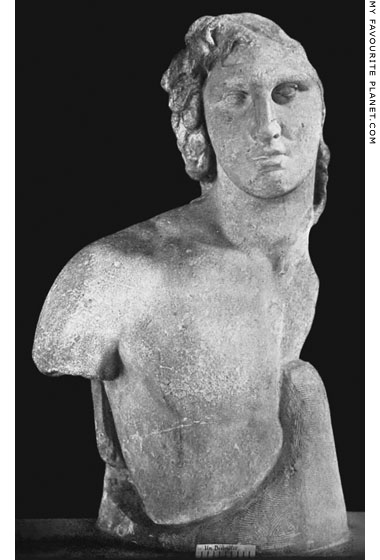
The "Inopos", a fragment of a marble statue
in the style of portraits of Alexander the Great.
Around 100 BC. From Delos. Height 95 cm.
Louvre, Paris. Inv. No. Ma 855 (MR 235).
Donated by the painter E. A. Gibelin, 1801.
|
The fragment, which includes most of the head and right side of the chest, was initially thought to depict the Delian river god Inopos (Ινωπος), but is now considered to be a Hellenistic ruler, either Alexander himself or Mithradates VI (see above).
It has been suggested that the statue may have been made by Alexandros of Antioch (or Agesandros of Antioch), the sculptor of the Venus de Milo.
Image source: Guy Dickens, Hellenistic sculpture, Fig. 20, page 26. Clarendon Press, Oxford, 1920. At the Internet Archive.
See: Bust of Alexander the Great, known as the "Inopos", at the Louvre website. |
|
|
 |
|
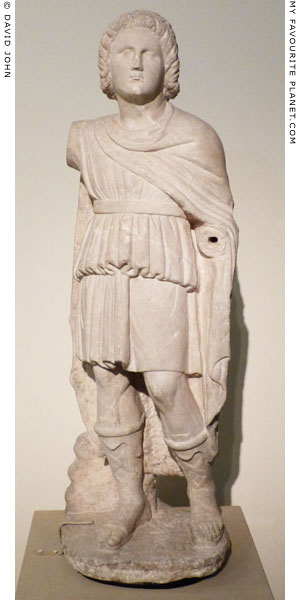 |
Marble statuettes of Hephaistion (left) and Alexander the Great from Egypt. Probably
1st century BC. Perhaps from a statue group erected in Alexandria in Hephaistion's honour.
National Archaeological Museum, Athens. Egyptian Collection. Invoice numbers 45 and 44.
|
|
Formerly in the Demetrios Collection, they are often referred to as the "Demetrio Hephaistion" and "Demetrio Alexander". The figures stand in mirrored contrapposto poses, each with the opposite arm raised. Each wears a chlamys, chiton, zona belt and open-toed, lace-up boots. It is tempting to speculate that the figures were placed next to each other, each holding a horse, in the manner in which the twin divine horsemen heroes Castor and Pollux (the Dioskouri) were represented in sculptures and coins.
See also:
A marble head from Kyme below, thought to be a portrait of Hephaistion.
A Hellenistic double hero relief from Miletus, on Pergamon gallery 2, page 10.
A Hellenistic relief from Pella depicting Hephaistion, on Pella gallery page 17. |
|
| |

Copper alloy statuette from Egypt depicting
Alexander the Great as a Roman general,
wearing the Gorgoneion on his cuirass.
National Archaeological Museum, Athens.
Egyptian Collection, Inv. No. 2577. |
|
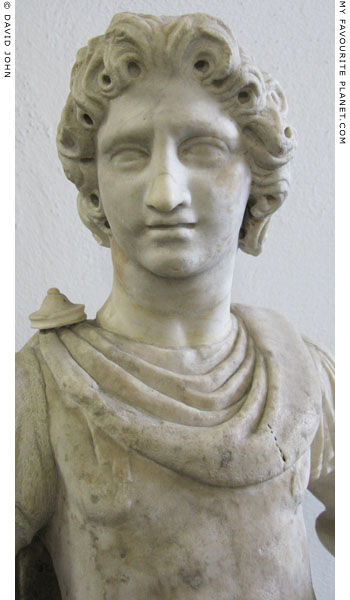 |
|
 |
Marble statuette of Alexander the Great. Around 150 AD.
Height 103 cm, width 32 cm, depth 24 cm. Height of statue 95 cm, head (with neck) 17.8 cm.
Pergamon Museum, Berlin. Inv. No. Sk 304.
|
|
The statuette belonged to the French Cardinal Melchior de Polignac (1661-1742), who lived in Rome 1724-1732, and commissioned the sculptors Lambert-Sigisbert Adam, Edme Bouchardon and Pierre Lestache as restorers for objects in his collection of Roman antiquities. The statuette may have been at first restored as Archangel Michael during this time. It was restored again as a Roman emperor, probably after the cardinal took it with him on his return to Paris.
The entire collection was purchased by King Friedrich II of Prussia (Frederick the Great), and the statuette was first mentioned as Alexander in 1742, when it stood in the oval dining room of Schloss Charlottenberg, Berlin. Later it was placed in the "Saal der Hermen" (Hall of the Herms) in the Altes Museum, as No. 398 (number on the base). |
|
|
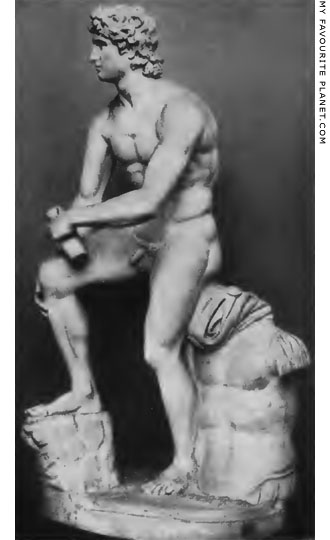 |
|
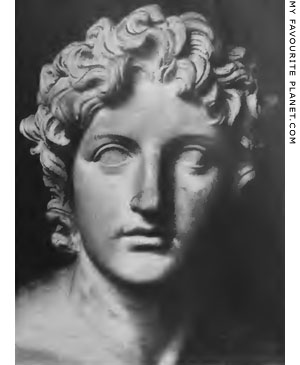 |
The so-called "Alexander Rondanini" marble statue, thought to represent Alexander the Great.
Right: photo of the head of the statue from a plaster cast.
|
|
The life-sized statue was named the "Alexander Rondanini" due to the fact that it was part of the large private collection of antiquities kept by the wealthy Rondanini family at the Palazzo Rondanini (now Palazzo Rondanini-Sanseverino) in the centre of Rome, from where it was purchased for the Glyptothek museum, Munich in 1814.
Glyptothek, Munich. Inv. No. GL 298. Height 1.78 metres.
It was first identified as a portrait of Alexander in 1767 by the German art historian Johann Joachim Winckelmann (1717-1768), but this identification remains a subject of debate. According to one theory it may be part of a Roman period copy of a bronze statue group by Euphranor of Corinth (Ἐυφράνωρ, circa 390-325 BC), mentioned by Pliny the Elder, depicting King Philip II of Macedon and his son Alexander in four-horse chariots.
"He [Euphranor] also executed some brazen chariots with four and two horses, and a Cliduchus of beautiful proportions; as also two colossal statues, one representing Virtue, the other Greece; and a figure of a female lost in wonder and adoration: with statues of Alexander and Philip in chariots with four horses."
Pliny the Elder, Natural History, Book 34, chapter 19. At Perseus Digital Library.
Other scholars believe it may be a Roman copy of a late Hellenistic portrait of Alexander as Achilles, or perhaps of Achilles himself. According to one theory, the marble head of Alexander the Great in the Barracco Museum, Rome (see above) may also be a copy of the statue by Euphranor.
Image source: Ludwig Curtius (1874-1954), Die antike Kunst, Band II, page 363, figs. 546 and 547. Akademische Verlagsgesellschaft Athenaion M.B.H., Wildpark-Potsdam, 1926.
See also:
Ralf von den Hoff, Der "Alexander Rondanini". Mythischer Heros oder heroischer Herrscher?, in Münchner Jahrbuch für bildende Kunst, 48 (1997), pages 7-28.
Olga Palagia, Euphranor. Brill, Leiden, 1980. |
|
|

Sculpted marble metope with a relief of Helios in a quadriga (four horse chariot) rising out of the sea.
The sun god's features, poise of the neck and hairstyle resemble portraits of Alexander.
Hellenistic period, 300-280 BC. The best preserved metope from the temple of Athena Ilias,
Ilion (Troy), northwest Anatolia; today Hisarlik, around 30 km southwest of Çanakkale, Turkey.
Found in 1872 during Heinrich Schliemann's first excavations of 1871-1873 (his second excavations
were in 1878-1879). Height 85.8 cm; width of triglyph block 201.2 cm; width of metope 86.3 cm.
Altes Museum, Berlin. Inv. No. Sch 9582; L 21.1.
On loan from the Museum für Vor- und Frühgeschichte, Berlin. |
| |

Detail of the metope from Troy with the relief of Helios.
|
The metope is from the architrave at the east end of the north side of temple of Athena Ilias, the patron goddess of Ilion (Ancient Greek, Ἴλιον, Ilion, or Ἴλιος, Ilios, and Τροία, Troia; Latin, Troia and Ilium). The Doric temple was built at the beginning of the 3rd century BC by Lysimachus, king of Thrace and Macedonia (see History of Pergamon), allegedly in fulfilment of the wishes of Alexander the Great. It is thought that, as at the Parthenon in Athens, the row of metopes continued with battle scenes, perhaps from the Trojan war, and ended with an image of the moon goddess Selene.
"The present city of Ilium was once, it is said, a village, containing a small and plain temple of Minerva [Athena]; that Alexander, after his victory at the Granicus, came up, and decorated the temple with offerings, gave it the title of city, and ordered those who had the management of such things to improve it with new buildings; he declared it free and exempt from tribute. Afterwards, when he had destroyed the Persian empire, he sent a letter, expressed in kind terms, in which he promised the Ilienses to make theirs a great city, to build a temple of great magnificence, and to institute sacred games.
After the death of Alexander, it was Lysimachus who took the greatest interest in the welfare of the place; built a temple, and surrounded the city with a wall of about 40 stadia in extent. He settled here the inhabitants of the ancient cities around, which were in a dilapidated state. It was at this time that he directed his attention to Alexandreia, founded by Antigonus, and surnamed Antigonia, which was altered (into Alexandreia). For it appeared to be an act of pious duty in the successors of Alexander first to found cities which should bear his name, and afterwards those which should be called after their own. Alexandreia continued to exist, and became a large place; at present it has received a Roman colony, and is reckoned among celebrated cities."
Strabo, Geography, Book 13, chapter 1, section 26. At Perseus Digital Library.
According to Plutarch (Life of Alexander, chapter 15) and Arrian (Anabasis of Alexander, Book 1, chapters 11-12), Alexander visited Ilion before, rather than after the Battle of Granicus, immediately following his crossing of the Hellespont into Asia (Anatolia) in May 334 BC. He visited the temple of Athena Ilias, made sacrifices at the supposed tombs of the Homeric heroes Achilles and Patroklos, and exempted the city from tribute (taxes).
Before Alexander's death in 323 BC, it was said that he made plans to rebuild the temple of Athena Ilias as the largest in the known world. At 16.4 x 35.7 metres, Lysimachus' peripteral temple, with 6 columns at each end and 12 along the sides, was far from being the largest or grandest, and to judge by the metopes, not particularly well sculpted; the building and sculptures probably depended on paint to create an impression.
Ilion was sacked in 85 BC by the Roman commander Gaius Flavius Fimbria during the First Mithridatic War (88-84 BC). In 20 BC Emperor Augustus visited the city and ordered repairs, including the restoration of the temple. Little remains of the temple today, since it has provided building material for local people over the centuries. |
|

Marble bust thought to be
a portrait of Lysimachus,
one of Alexander's generals
and successors.
Augustan copy (23 BC -
14 AD) of a 2nd century
BC Greek original.
National Archaeological
Museum, Naples.
Inv. No. 6141.
See:
Pergamon gallery 2, page 3. |
|
|
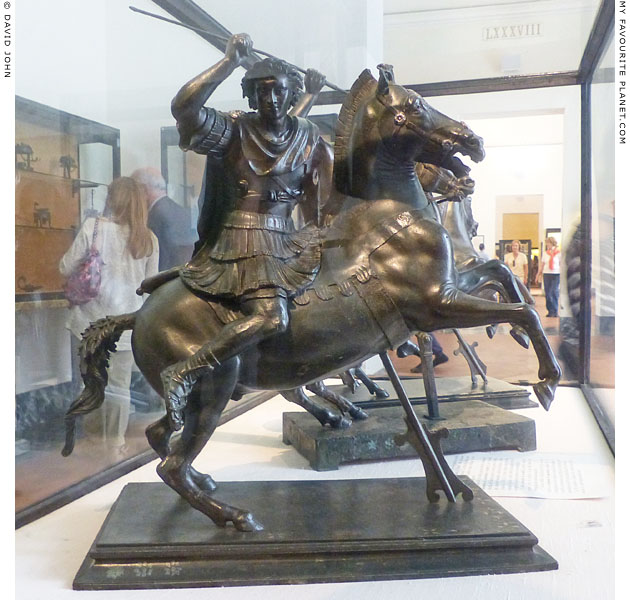
Bronze statuette of Alexander the Great on horseback from Herculaneum.
1st century BC. Found in around 15 fragments in October-November 1761, during
the Bourbon excavations, in a tunnel at the theatre, under the Casa dei Colli Mozzi,
Herculaneum, Campania, southern Italy. The rider's legs and right arm, and the horse's
legs were missing. It was restored over several years from 1762 in the Reale Fonderia
of Portici (the royal foundry of Naples), under the direction of Camillo Paderni, custodian
of the Real Museo Borbonico (Royal Bourbon Museum) in Naples. During the 1770s it was
exhibited in the museum in Herculaneum, and first displayed in the Naples museum in 1820.
Height 48.5 cm, Length 47 cm, depth 29 cm.
National Archaeological Museum, Naples, Italy. Inv. No. 4996.
|
One of a group of three similar cast bronze equestrian statuettes discovered in the theatre in Herculaneum. The other two are of an Amazon on horseback (Inv. No. 4999, see image, right) and a now riderless rearing horse (Inv. No. 4894).
This figure is thought to be a copy of a statue of Alexander the Great from a bronze equestrian group of 25 mounted figures (there may have been more figures in the work, perhaps depicting Persians), known as the Granikos Monument (or Granicus Monument). The group was commissioned by Alexander and made by the sculptor Lysippos (Λύσιππος) to commemorate members of Alexander's Companion royal guard, recruited from young Macedonian noblemen, who died at the Battle of the Granicus River (Γρανικὸς ποταμός) in 334 BC, and erected at Dion, Macedonia around 330 BC (Arrian, Anabasis of Alexander, Book 1, chapter 16; Plutarch, Life of Alexander, chapter 16).
Alexander, with swept-back, wavy hair, wears a royal diadem, a short chlamys (cloak), a cuirass over a short chiton, and laced high military sandals. He rides without a saddle or stirrups, as the latter were unknown to the ancient Greeks. The rearing horse is thought to be his favourite steed Bucephalos (Βουκέφαλος, Ox-Head). The figure originally held a sword in his right hand, and reins in the left, probably both of silver. Other details of the statuette were also inlaid with silver foil, including the eyes of the rider and horse, the rosette fastening on right shoulder of the rider's cloak, and the mask on the horse’s breastplate.
The Battle of the Granicus River was the first of three major battles fought by Alexander during his ten year campaign in Asia against armies of the Persian King Darius III; the other two were at Issos (or Issus) in 333 BC and Gaugamela in 331 BC (see below). In each case his victory against superior numbers has been put down to his brilliant, innovative and unconventional tactics. These victories and his eventual complete defeat of the Persian Empire astonished the world and cemented his legendary status.
The Granikos Monument was recognized from antiquity not merely as a memorial to fallen soldiers but, perhaps more importantly, as part of Alexander's sophisticated propaganda campaign, aimed at convincing supporters and enemies - in Greece as well as in Asia - of his determination, invincibility and extraordinary persona. The point was certainly not lost on the Romans.
The Roman praetor Quintus Cecilius Metellus took the sculpture group to Rome after defeating of the rebellion of Andriscus (Ἀνδρίσκος, Andriskos, also known as the Pseudo-Philip, pretender to the Macedonian throne, arguably the last Macedonian king) at the Second Battle of Pydna in 148 BC and reducing Macedonia to a Roman province (146 BC), and set it up in a new portico he built there. [15]
Unfortunately, the museum lighting and reflections from the glass case (which is near a large window) make photographing the statue difficult.
See: Salvatore Siano et al, The bronze sculpture of Alexander the Great on horseback: An archaeometallurgical study. In: Jens M. Daehner, Kenneth Lapatin, Ambra Spinelli (editors), Artistry in bronze: The Greeks and their legacy, XIXth International Congress on Ancient Bronzes, No. 44. Papers published by the J. Paul Getty Museum and the Getty Conservation Institute, 2017. At getty.edu, website of the J. Paul Getty Trust. |
|
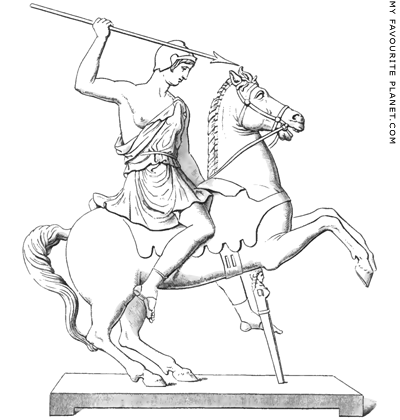
The bronze statuette of an Amazon on horseback
from the Herculaneum theatre. Height 48.3 cm.
National Archaeological Museum, Naples. Inv. No. 4999.
Image source: Drawn and engraved by G. Fusaro.
In: Domenico Monaco and Eustace Neville Rolfe,
Specimens from the Naples Museum, page 13
and plate 90. William Clowes & Sons, London, 1884.
At the Internet Archive. |
|
| |
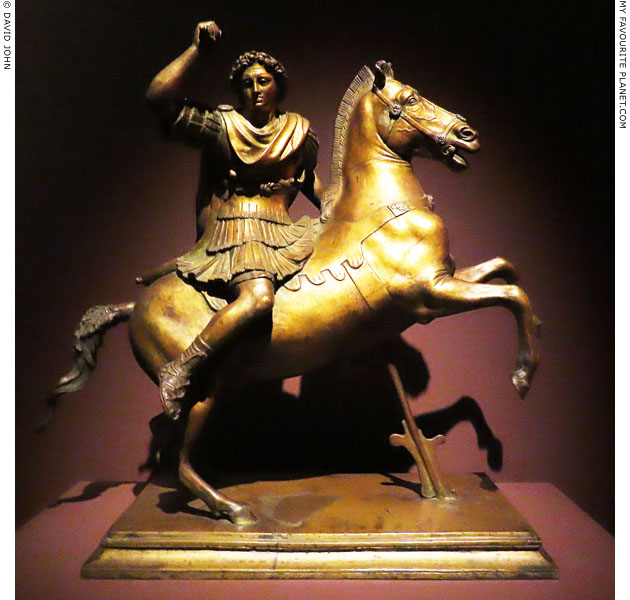
A modern copy of the bronze statuette of Alexander the Great
on horseback from Herculaneum, made in the 1780s.
The replica was made at an unknown date after the restoration of the
original was completed in the 1770s. It has been suggested it was
made either by the Reale Fonderia of Portici (the royal foundry of
Naples), or by one of the craftsmen who worked on the original.
Height 48 cm, Length 55 cm, depth 29 cm.
Museum of Philhellenism, Athens. |
| |
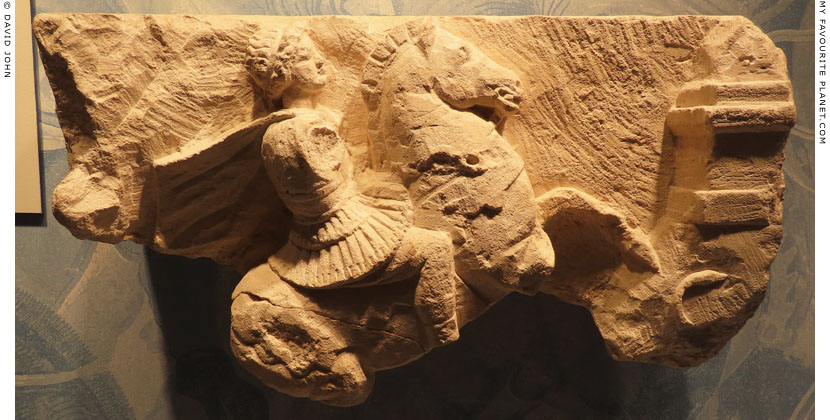
A fragment of an early Hellenistic limestone funerary stele with a relief depicting a Macedonian
cavalryman on a rearing horse in front of a flaming altar on a rock, below which is a snake facing
right, perhaps symbolizing chthonic (underworld) forces. The rider wears a chlamys (short cloak),
which was originally red, a cuirass over a short chiton (tunic), an armour skirt and high boots.
The scene is typical of hero reliefs (see Pergamon gallery 2, page 10). However, the rider's
diadem (or fillet; headband), according to the museum's labelling a type "reserved for kings"
(see, for example, portraits of Alexander on a coin of Lysimachus and an Aboukir medallion
above), has led scholars to suggest that the figure may represent Alexander.
Ptolemaic period, circa 3rd century BC. Provenance unknown. From Egypt; purchased on the
Cairo art market in 1906. Height 23.0 cm, width 40.0 cm, depth 8.1 cm. Depth of relief 3.0 cm.
Allard Pierson Museum, Amsterdam. Inv. No. 7941.
Catalogue No. 133, pages 110-111, plate 59, b. The museum catalogue describes the
cuirass as Macedonian, "made of either leather or metal and equipped with a double
row of pteruges; this type of cuirass is usually provided with flaps on the shoulder, as
seen in the Alexander mosaic." However, the author also comments, "the horseman's
face cannot be considered the portrait of an individual". [see note 14]. |
| |
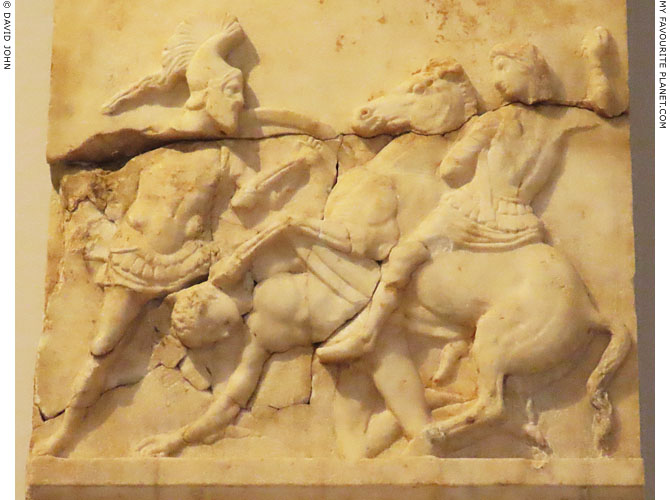
Detail of the large marble grave stele of Panchares, son of Leochares
(Παγχάρης, γιος του Λεωχάρους). In the relief, the deceased (left) is
depicted as a hoplite fighting a Macedonian cavalryman, probably at
the Battle of Chaeroneia, 338 BC. The Macedonian, on his rearing
horse, originally held a spear in his raised right hand.
The large relief loutrophoros at the bottom of the stele probably
indicates that the dead man was unmarried.
Mid 4th century BC. Found by chance during public construction
works near Peiraios Street, Kaminia, Piraeus. Pentelic marble.
Dimensions of preserved monument, including recompleted part:
height 351 cm, width 54-63 cm, thickness 19-21 cm.
Piraeus Archaeological Museum. Inv. No. ΜΠ 5280. |
| |
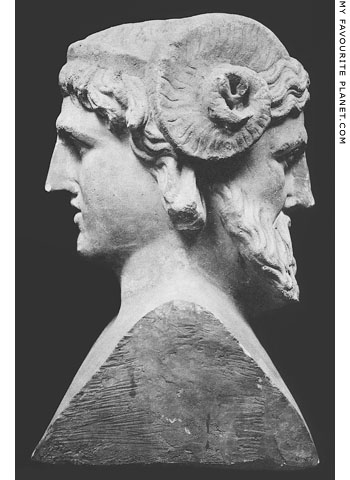
A small double herm bust with the addorsed heads of
Alexander the Great (left) and Zeus Ammon (Ζεύς Ἄμμων).
Palazzo dei Conservatori, Capitoline Museums, Rome. |
| |
This janiform bust was described as an exhibit in the Sala degli Orti Lamiani of the Palazzo dei Conservatori in Henry Stuart Jones's 1926 catalogue of sculptures there:
"Height (of heads) .20 m. Marble grechetto. Restored: the nose of each head, the herm.
One of the heads is of the usual type of Zeus Ammon, with ram's horns at the ears; the other is youthful, with strongly marked protuberance of the frontal bone, and is no doubt a head of Alexander. The traditional likeness, though slight, is clear, and the neck shows the usual slight deflexion. The workmanship is of little merit.
Provenance unknown."
If the sculpture may be judged from this photo from the catalogue, Jones may have been correct about the poor quality of the workmanship, especially compared to other works in the museum. I do not recall seeing this bust in the Capitoline Museums, and have yet to discover a more recent reference to it in print or online. The arrangement of the objects displayed in the museums has been changed several times, and it may no longer be on display.
A similar bust was temporarily exhibited in the Colosseum around 2012-2013, but this appears to have been a sculpture from the Vatican Museums, perhaps the double herm said to be in the Galleria delle Carte Geografiche. A similarly lacklustre sculpture, Zeus Ammon is shown younger, with sideburns rather than a beard, and the other head is even less recognizable as a portrait of Alexander (if that is who it is meant to be?) than that above. See: 20484: Marmor Büste des Zeus Ammon von einer Doppelherme (with an old photo). At Arachne, Archaeological Institute of the University of Cologne.
See: Henry Stuart Jones, A catalogue of the ancient sculptures preserved in the municipal collections of Rome: The sculptures of the Palazzo dei Conservatori (Volume 2 of 2, text; Volume 1 contains the plates), "Small double herm", Sala degli Orti Lamiani No. 1a, page 128 and plate 45. Clarendon Press, Oxford, 1926. Both volumes online at Heidelberg University Digital Library. |
|
| |
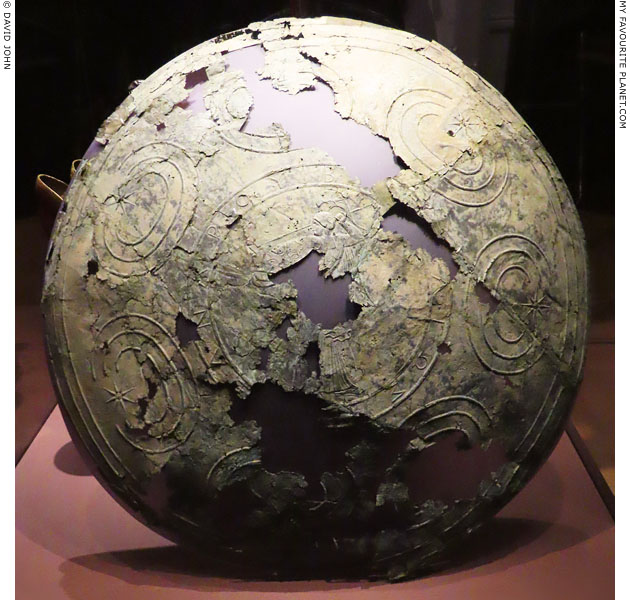
The bronze outer cover of a round Macedonian shield, inscribed
Β[ΑΣΙ]ΛΕΩΣ Α[ΛΕ]ΞΑΝΔΡΟΥ (King Alexandros), thought to refer
to Alexander IV, son of Alexander the Great and Roxana.
317-309 BC. Cast in a mould. Diameter 69.2 cm, thickness 1 mm.
Ephorate of Antiquities of Thessaloniki. Inv. No. 2742.
|
| A number of such covers have been found, and they also appear on coins of Alexander's successors (see Pan). It was designed to fit over a round wooden shield. Around the edge are relief representations of seven peltai (from the Greek πέλτη, shield), each shown as a double crescent around an eight-pointed star. In the centre a circular band, 2.8 cm wide, on which is the inscription, surrounds a blazon, 24 cm in diameter, with a depiction of the goddess Athena of the type shown on coins and Panathenaic vases, thought to be Athena Alkidemos (Ἀθῆνη Ἀλκίδημος, defender of the people, demos), the patron goddess of Pella. She is viewed from behind, advancing to the left, brandishing a spear in her raised right hand, and on her left arm she holds a shield with a Gorgonian in the blazon. She wears a high-crested Attic helmet and an aegis over a long, pleated tunic (see photo below). |
|
| |
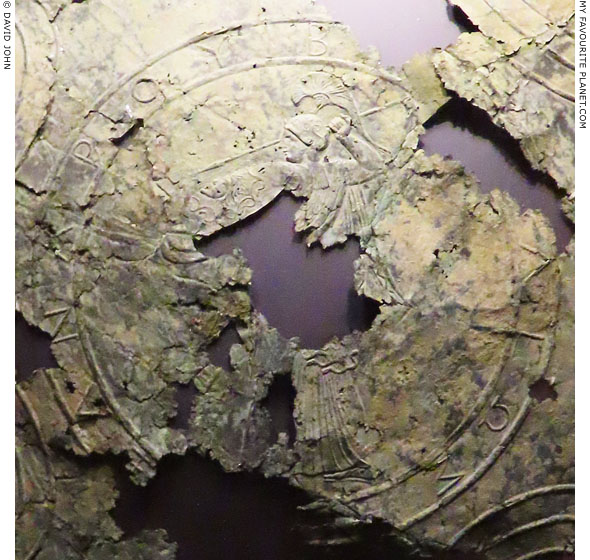
The blazon of the bronze Macedonian shield cover above,
with a depiction of Athena, around which is the inscribed band. |
| |
Alexander
the Great |
"Alexander Aigiochos" type statues |
|
 |
|
| |
 |
|
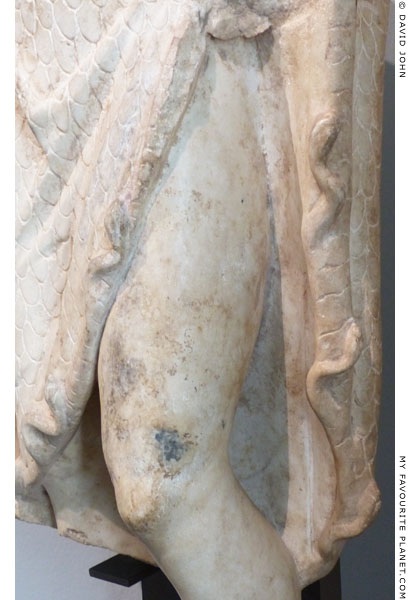 |
Lifesize marble statue of Alexander the Great of the "Alexander Aigiochos" type.
From Egypt. Roman period, thought to be a copy of a Greek original from
Alexandria, around 310-280 BC. Height 135.5 cm, width 55.5 cm, depth 25.5 cm.
Museum für Kunst und Gewerbe Hamburg. Inv. No. 1963.74.
Purchased with funds from the Campe'schen Historischen Kunststiftung.
|
|
There are 17 known examples of the Alexander Aigiochos (αἰγίοχος, aegis-bearing) type, as fragmentary statues and statuettes (see photos below). All those for which the provenance is known are from Egypt. One of the finest and most complete examples is a marble statuette from El Manshah (ancient Ptolemais Hermiou), Egypt, in the Fitzwilliam Museum, Cambridge, Inv. No. GR.69.1970 (see data.fitzmuseum.cam.ac.uk ...).
The figures show Alexander the Great standing barefoot in a "contrapposto" pose, with his weight on his right leg, the left leg bent and resting on the toes. He wears a so-called Macedonian chlamys (short cloak), covering his shoulders and torso, and falling to the knees, with the opening at his right side. His outstretched left forearm lifts the left side of the chlamys, exposing his naked left thigh. The snake-fringed chlamys is covered with scales, as on the aegis, asociated with Zeus, but most often shown on depictions of Athena (particularly Athena Parthenos, see Pergamon gallery 2, page 13). A Gorgoneion (head of Medusa) is attached to the cloak at his left breast (on the Hamburg statue it is below the breast).
He probably held a spear in his raised right hand, and in the palm of the left hand a Palladion, an ancient statue of Pallas Athena which protected Troy (see Homer part 2). The features of the heads on some of the figures have led some scholars to associate the original work with Lysippos.
The date and location of the original statue are unknown, but is thought to have stood in Alexandria, Egypt, where it may have been a cult statue representing the deified Alexander as the founder (κτίστης, ktistes) of the city (in 331 BC). The Tycheion, the sanctuary of the city-protecting goddess Tyche (Τύχη; Latin, Fortuna), has been suggested as the centre of the cult. It may have been made as early as the reign of Ptolemy (Πτολεμαῖος, circa 367 - 283/282 BC), one of Alexander's generals and close friends, who took control of Egypt after the king's death in 323 BC and became Ptolemy I Soter (Πτολεμαῖος Α' Σωτήρ, ruled 323-283/282 BC), founder of the Ptolemaic dynasty. The statue may represent Alexander as Zeus Aigiochos, and has also been identified with Agathos Daimon (Ἀγαθὸς Δαίμων, Good Demon), the anguiform (serpentine) protective spirit of Alexandria. (See a statuette of the syncretic deity Serapis Amun Agathodaemon on Pergamon gallery 1, page 27.)
It has been suggested that it may have been set up at the tomb of Alexander in Alexandria. In Syria in late 322 or early 321 BC Ptolemy stole Alexander's body from the funeral cortege on its way from
Babylon to Macedon (or perhaps the sanctuary of Ammon at Siwa) and and took it to Memphis in lower Egypt. [16] His son and successor Ptolemy II Philadelphus (Πτολεμαῖος Β' Φιλάδελφος, ruled 283-246 BC) moved the body to the tomb he built in Alexandria, where it was still to be seen in Roman times. The tomb was visited by several prominent Romans, including Pompey, Julius Caesar, Augustus, Caligula, Septimius Severus and Caracalla. There are no further mentions of the tomb from the Middle Ages onwards; it seems to have disappeared, and its location remains unknown.
See: Klaus Parlasca, Alexander Aigiochos: Das Kultbild des Stadtgründers von Alexandria in Ägypten. Städel-Jahrbuch, Band 19, pages 341-362. Städelsches Kunstinstitut, Frankfurt am Main, 2004. |
|
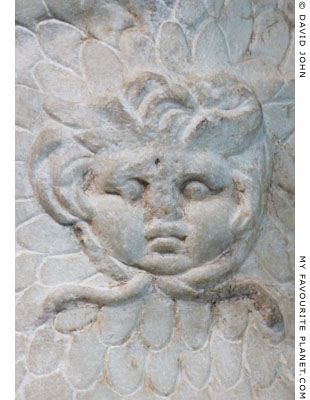
The Gorgoneion on the Alexander Aigiochos
statue in Hamburg. |
|
| |
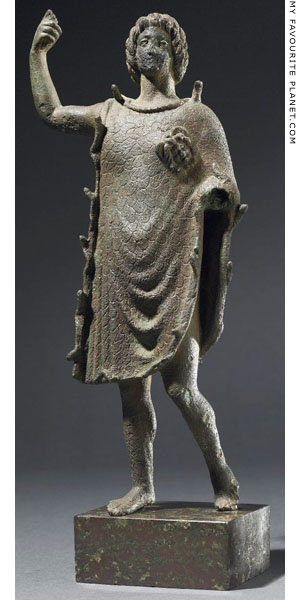
Bronze statuette of the
Alexander Aigiochos type.
Roman period, 1st century AD.
Perhaps from Egypt. Height 32.6 cm,
width 13.2 cm, weight 2 kg.
British Museum. Inv. No. 1922,0711.1.
From the collection of Dr Daniel Marie Fouquet.
Donated by The Art Fund (as NACF), 1922.
Photo © The Trustees of the British Museum
Source: britishmuseum.org ... |
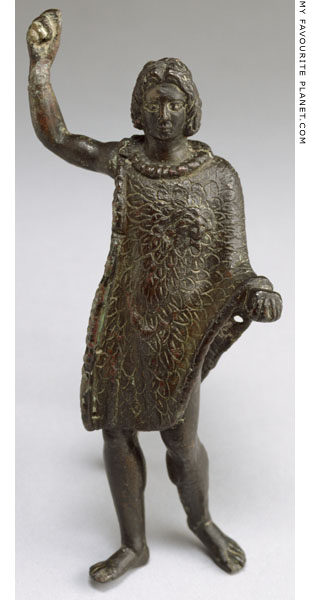
Bronze statuette of the
Alexander Aigiochos type.
Roman period, 1st - 3rd century AD.
Said to be from Alexandria. Bronze, inlaid
with silver. Height 12 cm, width 6.5 cm,
depth 3.2 cm. Weight 218 grams.
Walters Art Museum, Baltimore.
Inv. No. 54.1075 (not on display).
From the Matossia Collection.
Purchased by Henry Walters, 1922.
Creative commons photo. Source:
art.thewalters.org/detail/
10553/alexander-the-great/ |
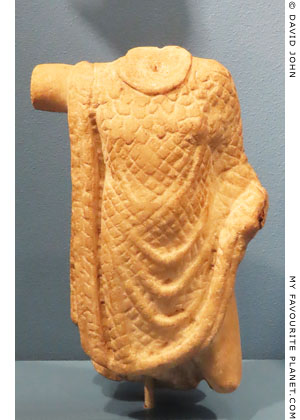
A fragment of a small marble statuette
of the Alexander Aigiochos type.
Provenance unknown. Perhaps from
Alexandria, Egypt. 2nd century AD.
Height 21.5 cm, width 13.0 cm, depth 6.6 cm.
Allard Pierson Museum, Amsterdam.
Inv. No. APM 7842.
The statuette, with its head, and most of
the arms and legs missing, is displayed in
the museum's "Hellenistic Cabinet", among
a large number of objects from various
places, including Greece, Egypt and Italy,
dating from the early Hellenistic period to
the Roman period. Unfortunately, most of
the objects are not labelled individually.
Catalogue No. 27, pages 24-25,
and plate 11, c-d. [see note 14] |
|
| |
 |
|
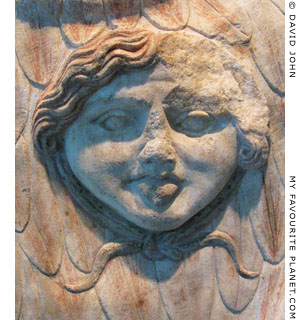 |
A headless marble statue from Thessaloniki, thought to have
depicted a Roman emperor, wearing an aegis and Gorgoneion.
Made during the reign of Emperor Hadrian, 117-138 AD.
Found at 32 Karaoli-Dimitriou Street, Thessaloniki.
Thessaloniki Archaeological Museum. Inv. No. ΜΘ 21996.
|
|
The work is based on the "Alexander Aigiochos" type , with a few differences: the left arm is raised and the right arm extended; the right shoulder, side and lower torso are exposed; the Gorgoneion is on the centre of the breast. The folds on the aegis are more pronounced, and the "collar" forms a socket for a separately sculpted (and interchangeable) head.
If the statue depicted a Roman emperor it may have been one of Hadrian's deified predecessors, perhaps Trajan (reigned 98-117 AD), who became the main focus of the imperial cult during Hadrian's reign (see the Trajaneum in Pergamon). A number of depictions of emperors were modelled on portraits of Alexander.
A now lost cameo portraying a youthful emperor, probably Caracalla (reigned 198-217 AD), shows him as Alexander Aigiochos. The figure, standing contrapposto, wears a crown of solar rays, the aegis and Gorgoneion and high military boots, with a spear in his right hand and a Palladion statuette in the left. The cameo, once in the treasury of the Cathedral of Saint John the Baptist (Konkatedra św. Jana Chrzciciela), Kamien Pomorski (Cammin), northwestern Poland, disappeared along with other objects from the treasury at the end of World War II, when they were being transported to safety during a tank battle in 1945.
See: Andrew Stewart, Faces of Power: Alexander's Image and Hellenistic Politics, page 246 (fig. 82). University of California Press, 1993.
A cast of the cameo is in the Sammlung der Gipsabgüsse (Cast Collection) of the Archaeological Institute of the University of Göttingen, Germany.
See: viamus.uni-goettingen.de/fr/e/uni/c/04
Caracalla is said to have suffered from Alexander mania, and presented himself as the reincarnation of the deified king. When a mob in Alexandria jeered him for his pretensions he ordered their massacre. His apotheosis is shown on a cameo made around 210-220 AD, now in the Bibliothèque Municipale, Nancy. The figure, carried by a large eagle, wears a wreath and the aeigis and Gorgoneion. In his left hand he holds a cornucopia, and in the right a winged Nike offering a victory wreath.
See a bust of Caracalla on an Aboukir medallion above. |
|
| |
Alexander
the Great |
The Philippeion at Olympia |
|
 |
|
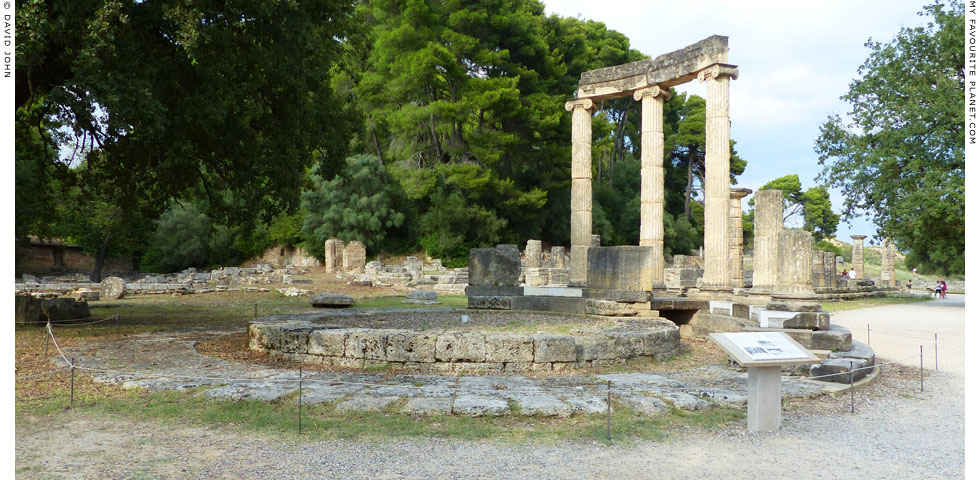
The partly reconstructed Philippeion in the archaeological site of Olympia, western Peloponnese, Greece.
Mid-late 4th century BC.
|
The Philippeion (Φιλιππείον) at Olympia was commissioned by Philip II of Macedonia following his victory over the Athenians and Boeotians at the Battle of Chaeroneia in 338 BC, and probably completed during the reign of his son Alexander the Great.
The remains of the Ionic tholos (circular building) still stand to the northwest of the Temple of Zeus and west of the Temple of Hera (Heraion), near the entrance to the Altis, the sacred enclosure of the Sanctuary of Zeus, which was extended to the west to accommodate this new monument.
Estimated to have been over 10 metres tall, with a diameter of 15.24 metres, it was the only circular building in the Altis. It consisted of an external circular peristyle (outer colonnade) of 18 Ionic columns, supporting a conical roof and surrounding the circular cella, 7 metres in diameter. Around the outside of the wall of this central chamber were 9 Corinthian half-engaged columns (see photo, right). In its centre, on a semi-circular podium (see photo below) stood chryselephantine statues made by Leochares, depicting Alexander, his parents Philip II and Olympias, and his paternal grandparents Amyntas III and Eurydice I (Εὐρυδίκη).
The Greek travel writer Pausanias gave a short description of the Philippeion, the only surviving ancient literary source on the monument:
"The Metroum is within the Altis, and so is a round building called the Philippeum. On the roof of the Philippeum is a bronze poppy which binds the beams together.
This building is on the left of the exit over against the Town Hall [the Prytaneion]. It is made of burnt brick and is surrounded by columns. It was built by Philip after the fall of Greece at Chaeroneia. Here are set statues of Philip and Alexander, and with them is Amyntas, Philip's father. These works too are by Leochares, and are of ivory and gold, as are the statues of Olympias and Eurydice."
Pausanias, Description of Greece, Book 5, chapter 20, sections 9-10. At Perseus Digital Library.
He had earlier written that chryselephantine statues had been taken from the Philippeion to the nearby Temple of Hera, although it is not known when, why or by whom this may have been done. One of the statues was of "Philip's Eurydice" ("Εὐρυδίκη τε ἡ Φιλίππου"), but then there are lacunae (gaps) in the text. It has been assumed by some modern scholars that the statues were those of Eurydice and Olympias mentioned in chapter 20. However, the identity of Eurydice has been debated, and it has been suggested that she may have been the wife of Philip's son Arrhidaeus (Ἀριδαίος; he later took the name Philip and is referred to as Philip III Arrhidaeus, king of Macedon 323-317 BC), or one of the other women in the family who may have been known by that name according to some ancient sources. [17]
"There were also brought hither from what is called the Philippeum other images of gold and ivory, Eurydice [the wife of Aridaeus and Olympias the wife of Philip]."
Pausanias, Description of Greece, Book 5, chapter 17, section 4. (Translation by W. H. S. Jones and H. A. Ormerod, in the Loeb Classical Library edition, 1918.)
Archaeologists have determined that the wall of the cella was not made of burnt brick but of conglomerate rock, limestone and marble, and had an east-facing doorway. Most of the building has survived, although none of the statues have been found, nor the bronze poppy or doors. Studies of architectural parts indicate the influence of Attic, Peloponnesian and Macedonian styles and techniques, suggesting that it may have been designed as a panhellenic monument for the most important panhellenic sanctuary.
Although the Philippeion was presumably officially dedicated to Zeus, in form, and perhaps intended function, it was more like a heroon (ἡρῷον; plural ἡρῷα, heroa), a shrine to a heroized individual, family or dynasty. As such it was the only building dedicated to mortals in Olympia. [18] Throughout the history of Olympia several rulers erected statues of themselves as Olympic victors, and during the Roman period the individual sanctuaries and temples of the Altis were also full of statues of senators and emperors. Philip was himself an Olympic victor [19], his horse won the horse race in 356 BC (although he did not ride it, and did not even attend the games), giving him the right to erect his statue here. But this monument was much more than a sports trophy since it symbolized his status as the conquerer and first ruler (hegemon) of Greece, a fact that his successor Alexander was also keen to underline. Since Philip was murdered at Aigai (Vergina) in 336 BC, just two years after his victory at Chaeroneia, it has been argued that Alexander decided whose statues were to be set up, which may explain why his mother Olympias was included rather than Philip's seventh and last wife Kleopatra (Κλεοπάτρα, married in 337 BC, renamed Eurydice).
The partial restoration of some of the surviving parts of the Philippeion, completed in 2005, was undertaken by the German Archaeological Institute (DAI) and sponsored by the A. G. Leventis Foundation. It includes some architectural members returned to Olympia from the Pergamon Museum, Berlin.
An outer ring of limestone blocks mark the circuit of the outer colonnade, at the east of which three restored Ionic columns and parts of the architrave have been reconstructed. In the centre a higher ring of masonry forms the foundation of the cella. |
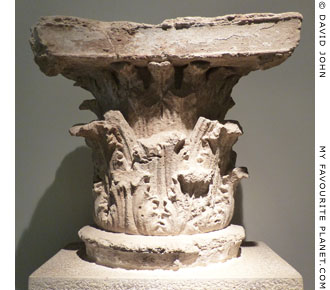
A Corinthian capital of a half-engaged column
from the cella of the Philippeion. The better
preserved of two displayed in the museum.
Mid-late 4th century BC.
Olympia Archaeological Museum. |
| |
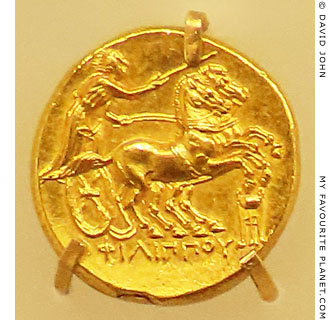
A gold stater coin of King Philip II of Macedonia
(ruled 359-336 BC) with a depiction of a two-
horse chariot and a tripod over the name
"ΦΙΛΙΠΠΟΥ" (of Philip). Obverse: head of
Apollo in profile, facing right.
Circa 323-315 BC.
Thessaloniki Archaeological Museum. |
| |
| |
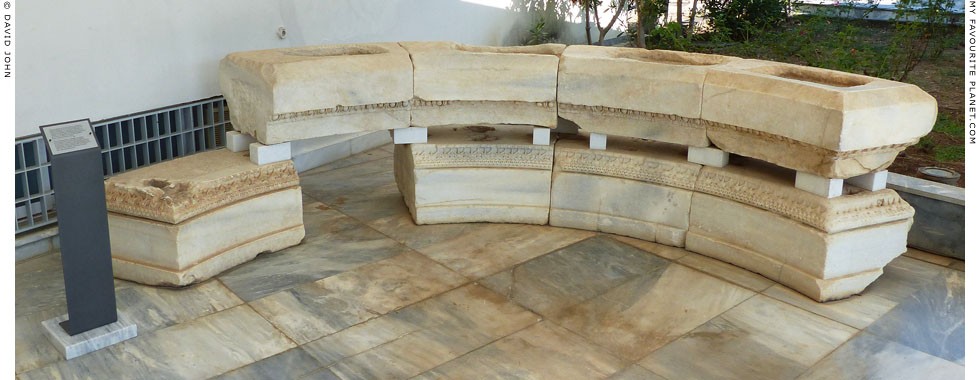
Part of the base and entabltature of a semi-circular marble podium from the cella of
the Philippeion at Olympia, on which stood the chryselephantine statues of Alexander
the Great, his parents and paternal grandparents, made by the sculptor Leochares.
Mid-late 4th century BC.
Exhibited at the entrance to the Olympia Archaeological Museum. |
| |
Alexander
the Great |
The "Alexander Sarcophagus" |
|
 |
|

Detail of one of the coloured reliefs on the "Alexander Sarcophagus" (Iskender Laht), with a depiction
of Alexander the Great at the Battle of Issos (333 BC) or the Battle of Gaugamela (331 BC).
Last quarter of the 4th century BC (circa 320 BC). From the Royal Necropolis of the Phoenician city
Sidon (Sayda, Chamber No. III), today in southern Lebanon. Pentelic marble. Height of frieze 69 cm.
Istanbul Archaeological Museum. Inv. No. 370 T. Cat. Mendel 68.
|
The "Alexander Sarcophagus" was excavated in 1887 by Osman Hamdi Bey (1842-1910, first Director General of the Ottoman Imperial Museums, 1881-1910) and Demosthenes Baltazzi [see note 9], and restored by sculptor Yervant Voskan (Osgan Efendi, 1855-1914).
The large sarcophagus is in the form of a Greek temple, with all four sides and both pediments on the lid decorated with reliefs showing what are considered to be historical events. One of the long sides depicts a battle between Macedonians and Persians, thought to be the Battle of Issos, the other a lion hunt (see photo below). The reliefs were painted red, blue, yellow, red ochre, violet, purple, earth, burnt sienna, black and white (see photo below). Weapons and horse reins were made of silver, but only one silver axe has survived the attentions of grave robbers.
Shortly after its discovery it was proposed that the sarcophagus was the tomb of Abdalonymos (Ἀβδαλώνυμος), who was made king of Sidon by Alexander in 332 BC. The figures represented on the reliefs were identified as Alexander, Abdalonymos, Hephaistion (Alexander's companion), Arrhidaios (Alexander's half brother, later Philip III of Macedon), Perdiccas (one of Alexander's generals, later co-ruler with or regent for Arrhidaios), as well as other Macedonian and Persian aristocrats, soldiers and hunters. The figures identified as Alexander, Hephaistion and Abdalonymos appear on both long sides.
Alexander (left), wears a lionskin headdress (see above), a chiton (tunic), gathered up and belted at the waist, and a chlamys (short cloak). He rides a rearing horse, perhaps Bucephalos, and his right arm is raised to aim a spear (now missing) downwards and to the right at a fleeing and cowering Persian whose horse has fallen beneath him. The Persian's tunic and headdress, often referred to as a "tiara" (τιάρα), can also be seen on depictions of other Persian soldiers (see photo, right), and Darius III himself wears one on the "Alexander Mosaic" in Naples (see below). Herodotus decribed the battle dress of the Persians and Medes when narrating how the enormous army of Xerxes I marched through Thrace in 480 BC on its way to Athens.
"The men who served in the army were the following: the Persians were equipped in this way: they wore on their heads loose caps called tiaras [τιάρας], and on their bodies embroidered sleeved tunics, with scales of iron like the scales of fish in appearance, and trousers on their legs; for shields they had wicker bucklers, with quivers hanging beneath them; they carried short spears, long bows, and reed arrows, and daggers that hung from the girdle by the right thigh... The Medes in the army were equipped like the Persians; indeed, that fashion of armor is Median, not Persian."
Herodotus, The Histories, Book 7, chapters 61-62. At Perseus Digital Library.
Inevitably, the iconography of the relief has been compared to that of the "Alexander Mosaic", and it has been suggested that both works derive from the same hypothetical painting.
The Canadian historian Waldemar Heckel has challenged the traditional interpretation of the reliefs, arguing that the sarcophagus may have been made for Mazaeus (died 328 BC), a Persian general and satrap (governor) appointed by Alexander as the satrap of Babylon after the Battle of Gaugamela (331 BC). According to this argument the identification of the figures and events on the reliefs should be reappraised, and the battle depicted is Gaugamela. Heckel also asserts that the primary source for accounts of the battle by later authors (Diodorus, Curtius, Plutarch) was the Alexandrou Praxis (Deeds of Alexander) by Callisthenes of Olynthos (see below), only fragments of which have survived. [20] |
|
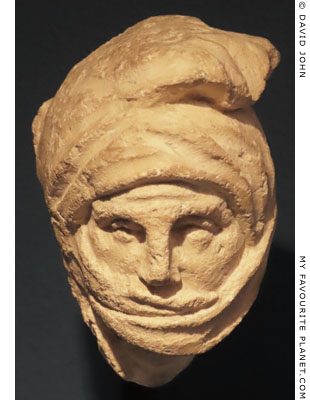
A small limestone head of a Persian warrior
wearing a "tiara", the type of headdress
shown on the "Alexander Sarcophagus"
and the "Alexander Mosaic" (see below).
Around 325-280 BC. From Tarento
(ancient Tarentum), Apulia, southern Italy.
Height 7.2 cm, width 4.8 cm, depth 6.2 cm.
Allard Pierson Museum, Amsterdam.
Inv. No. 1600.
Displayed, unlabelled, in the museum's
"Hellenistic Cabinet". Described elsewhere
as an "Achaemenid nobleman".
Catalogue No. 149, page 125, plate 63, b-c.
Thought to be from a relief on a frieze or
pediment. The headress is described in the
museum catalogue as a tiara, "wrapped
around cheeks, mouth and chin, with its
tip folded on crown". [see note 14] |
|
| |
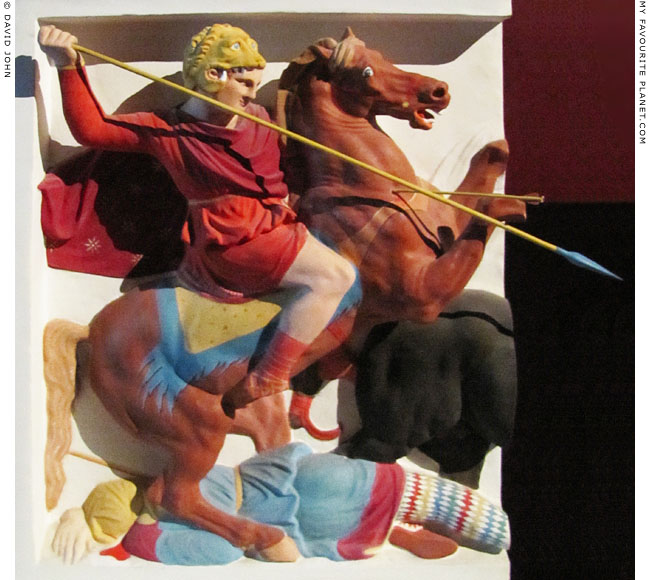
A modern model reconstructing the polychrome decoration of Alexander the Great
at the Battle of Issos from the relief on the "Alexander Sarcophagus".
Study: Vinzenze Brinkmann and Ulrike Koch-Brinkmann. Stereolithography: Alphaform, Munich.
Restoration of missing parts: Joseph Kotti, Sylvia Kellner. Painting: Ulrike Koch-Brinkmann.
Istanbul Archaeological Museum. |
|

The lion hunt relief on the other long side of the "Alexander Sarcophagus",
opposite the scene showing Alexander fighting Persians (see above).
Circa 320 BC. Height of frieze 69 cm.
Istanbul Archaeological Museum. Inv. No. 370 T. Cat. Mendel 68.
|
Alexander is shown riding the rearing horse on the left (see detail below). In the centre is the figure usually identified as Abdalonymos, dressed in Persian style, riding the horse being attacked by a lion. To the right of the lion, Alexander's companion Hephaistion (?), also on horseback, wears a red cloak (originally purple). On the far right of the frieze, a naked Macedonian and a man in Persian dress hunt a stag (see below).
The poses of the figures are similar to those on the Lion Hunt mosaic and Stag Hunt mosaic in Alexander's hometown Pella, Macedonia. |
|
| |

Detail of the lion hunt scene on the "Alexander Sarcophagus", with Alexander (left)
and Abdalonymos (?) on horseback. Both figures originally held spears made of silver.
A figure in Persian garb (right) is about to strike the lion with an axe. The horses are shown
at a smaller scale than the humans and the lion. Two hunting dogs are also shown in action. |
| |
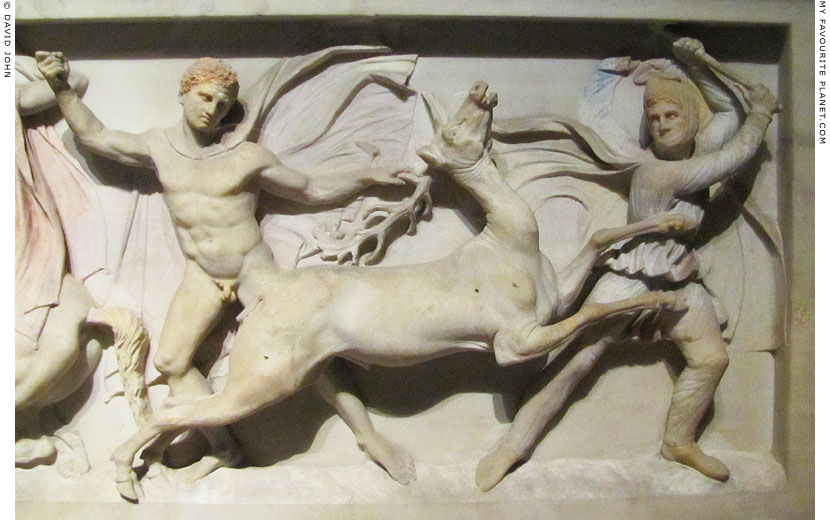
The stag hunt scene to the right side of the relief with the lion hunt on the "Alexander Sarcophagus".
A Macedonian (left), naked apart from a cloak, and a man in Persian garb (right) attack a rearing stag. |
| |
Alexander
the Great |
The "Offering of Krateros", Delphi |
|
 |
|
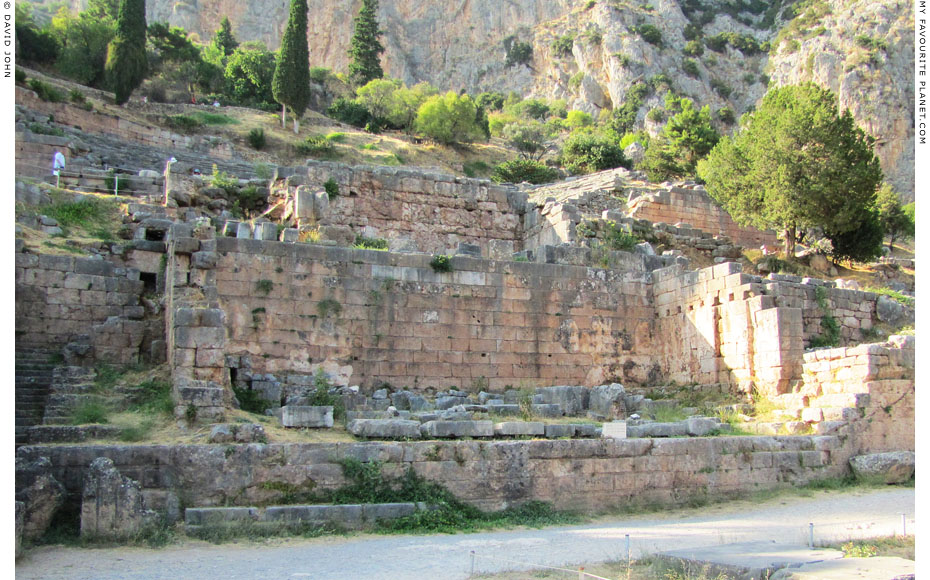
The site of the Krateros Monument, also known as the "Offering of Krateros"
or the "Ex-voto of Krateros" (Greek, Ανάθημα του Κρατερού), on a terrace
opposite the north side of the Temple of Apollo, Delphi.
|
Krateros (Κρατερός, circa 370 - 321/320 BC), son of Alexandros, a nobleman from Orestis, western Macedonia, who became a friend and general of Alexander the Great. After the king's death in 323 BC Krateros returned to Greece, and as one of the Diadochi (successors) sided with the viceroy Antipater (Ἀντίπατρος, Antipatros, circa 400-319 BC) in the ensuing wars over control of Alexander's empire. In 322 BC he married Antipater's daughter Phila (Φίλα, died 287 BC), but was killed in battle against Eumenes around a year or so later. Their son, also named Krateros, probably born after his father's death, may have been the Macedonian historian of that name.
Plutarch, who was a priest at Delphi, wrote that Krateros dedicated a bronze statue group there, made by Lysippos and Leochares. It depicted Krateros coming to the assistance of Alexander who was struggling with a lion during a hunt. This is thought to have been one of the last works of both artists and to have been dedicated around 320 BC or a little later.
"Accordingly, he [Alexander] exerted himself yet more strenuously in military and hunting expeditions, suffering distress and risking his life, so that a Spartan ambassador who came up with him as he was bringing down a great lion, said: 'Nobly, indeed, Alexander, hast thou struggled with the lion to see which should be king.' This hunting scene Craterus dedicated at Delphi, with bronze figures of the lion, the dogs, the king engaged with the lion, and himself coming to his assistance; some of the figures were moulded by Lysippus, and some by Leochares."
Plutarch, Life of Alexander, chapter 40, sections 4-5. At Bill Thayer's LacusCurtius website.
Pliny the Elder also mentioned a bronze statue of Alexander hunting by Lysippos, "now consecrated at Delphi", but did not say that Leochares worked on the sculpture.
Pliny the Elder, Natural History, Book 34, chapter 19. At Perseus Digital library.
Neither the monument nor its sculptures were mentioned by Pausanias in his description of Delphi, written in the mid 2nd century AD (Description of Greece, Book 10).
During excavations in Delphi by French archaeologists in the late 19th century the remains of the limestone base of the statue group were discovered on the raised terrace north of the Temple of Apollo. The dedicatory inscription states that the work was dedicated after the death of Krateros by his son. Since the younger Krateros was probably still an infant at the time the sculptures were set up, the dedication may have been made on his behalf by Phila and other family members, unless the metrical inscription was added later.
Υἱὸς Ἀλεξάνδρου Κράτερος τάδε τὠπόλλων[ι]
ηὔξατο τιμάεις καὶ πολύδοξος ἀνήρ·
στᾶσε, δ’ ὃν ἐμ μεγάροις ἐτεκνώσατο καὶ λίπε παῖδα,
πᾶσαν ὑποσχεσίαν πατρὶ τελῶν Κράτερος·
ὄφρα οἱ ἀίδιόν τε καὶ ἁρπαλέον κλέος ἅγρα,
ὦ ξένε, ταυροφόνου τοῦδε λέοντος ἔχοι·
ὅμ ποτε, Ἀλ[εξάν]δρωι τότε ὅθ’ εἵπετο καὶ συνεπόρθει
τῶι πολυαιν[ήτωι τ]ῶιδε Ἀσίας βασιλεῖ
ὧδε συνεξαλάπαξε, καὶ εἰς χέρας ἀντίασαντα
ἔκτανεν οἰονόμων ἐν περάτεσσι Σύρων.
Alexander's son, Krateros, offered these to Apollo,
A man exalted, honoured, and far-famed.
But he who placed them here was Krateros his orphaned child,
Fulfilling every promise for his sire,
To bring him glory, sweet and everlasting, O stranger,
As hunter of that bull-devouring lion.
Along with Alexander, Asia's much-praised monarch,
Companion to his king in victory,
He destroyed it as it rushed upon them, killed it thus
At sheep-rearing Syria's furthest bounds.
Inscription Fouilles de Delphes, FD III, 4:137 at The Packard Humanities Institute.
Due to the style of the lettering the inscription has been dated to around 300-270 BC, suggesting that Krateros junior may have dedicated or rededicated the monument himself when he reached adulthood. By this time both Lysippos and Leochares were probably very old or even dead.
The sculptures stood in a roofed portico, 15.27 metres long and 6.35 metres deep, with walls almost 4 metres high around three sides, and a colonnade of six Doric columns along the front which faced the northwest corner of the Temple of Apollo. Stairs to the west (left) of the monument led up towards the theatre.
It is not known when or where the hunt commemorated by the monument was supposed to have taken place. "Syria's furthest bounds" could indicate somewhere in the Levant or further east into Asia. According to one theory, the incident may have occurred in the royal game park at Sidon in 332/331 BC. The siginifcance of the scene is taken to be the rescue of Alexander by Krateros, but it also symbolized the close relationship of the two men and the dangers they faced and overcame together during the decade-long military campaign in Asia. Its propaganda value for Krateros' claim as a successor to Alexander would have been great, had he not died soon after he commissioned the monument.
The fate of the sculptures is also unclear, but no remains of them have been found at Delphi. Despite Plutarch's brief description, the form of the group may never be known. While some scholars have seen an echo of the sculptures in the Lion Hunt Mosaic in Pella (see below), others believe that a marble relief from Messene, now in the Louvre, may have been copied from the monument (see below).
See also the lion hunt relief on the "Alexander Sarcophagus" above. |
|

The modern sign marking the location of
the "Offering of Crateros" in Greek, French
and English, north of the Temple of Apollo
in the Archaeological Site of Delphi. |
|
| |
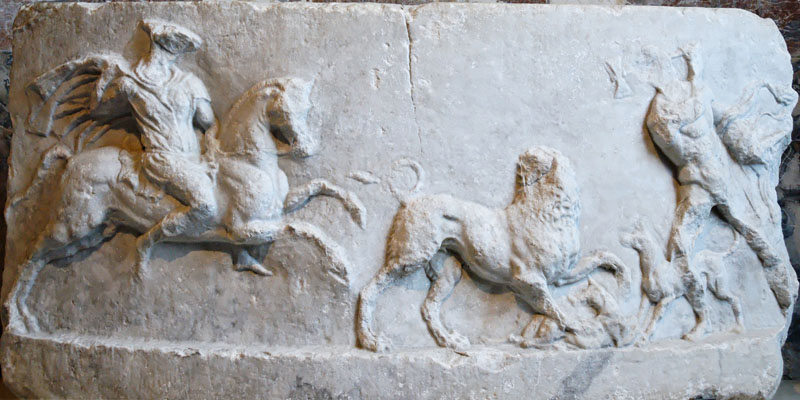
A marble relief known as "la Chasse d'Alexandre" ("Alexander's hunt") depicting
two men with dogs hunting a lion. The composition is thought by some scholars
to have been based on the "Ex-voto of Krateros" in Delphi.
Found in 1830 by the French Morea Expedition (see Herodes Atticus), in the
stadium-gymnasium complex in ancient Messene (Μεσσήνη), southwestern Peloponnese.
3rd or 2nd century BC, Hellenistic period. Height 59.5 cm, width 117.5 cm, depth 22.5 cm.
The curved fragment of grey-blue marble was part of a cylindrical altar, statue base
or funerary monument with an estimated diameter of 4.5 - 5 metres.
Louvre, Paris. Inv. No. Ma 858.
Photo by Jastrow at Wikimedia Commons.
|
In the centre the lion, its body facing right, confronts two hunting dogs, one of which it has pinned down with its right forepaw. To the right a naked hunter with a lion skin draped around his left arm, advances towards the lion and is about to strike it with a double-headed axe. His heroic nudity, muscular body and the skin on his arm are reminiscent of depictions of Herakles. On the left, a rider, wearing what has been described as "Macedonian garb", causia, chlamys, and belted short sleeved chiton, advances on the lion on a rearing or galloping horse, and with his right hand appears to be aiming a spear (now missing). The faces of both hunters and the lion are missing, but the cat appears to have been looking back towards the hunter behind it (the rider), as in the Lion Hunt pebble mosaic in Pella (see below).
If this is a copy of the Delphic Krateros monument, the naked hunter may be Alexander and the rider Krateros, galloping to the rescue. On the other hand the reverse identification of the figures has also been suggested.
A fragment of a similar relief found during more recent evcavations at Messene, now in a storeroom the Museum of Ancient Messene (Inv. No. 501), is thought to be from another block of the same monument. Part of a deer of antelope and a dog suggest that it was also a hunting scene. [21] |
|
| |
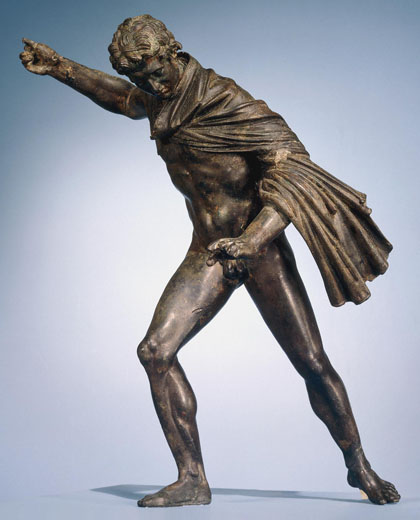
A bronze statuette of a huntsman aiming a spear, probably depicting
Alexander the Great or one of his Macedonian successors. Perhaps
inspired by the statue group of the "Ex-voto of Krateros" in Delphi.
Circa 250-100 BC. Height 45.72 cm.
British Museum. Inv. No. 1868,0520.65. Acquired 1868.
Photo: © The Trustees of the British Museum
See: www.britishmuseum.org/collection/object/G_1868-0520-65 |
| |
Alexander
the Great |
The Lion Hunt mosaic, Pella |
|
 |
|
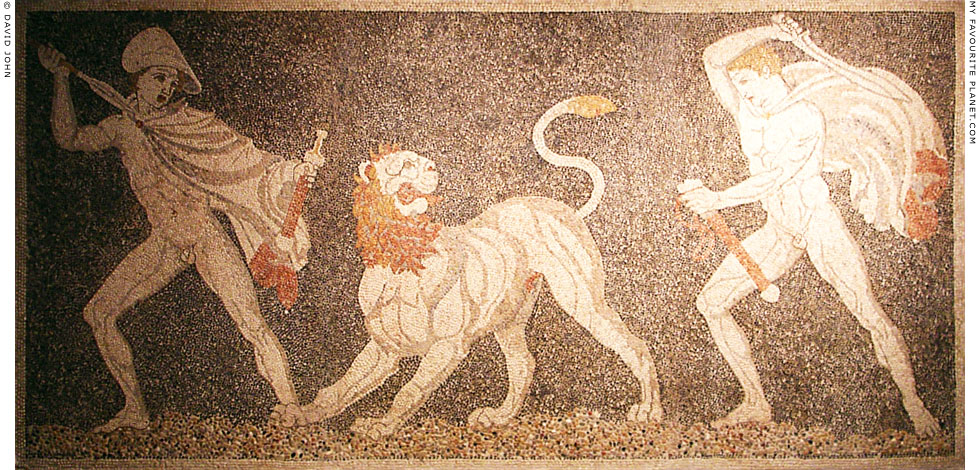
Lion Hunt pebble mosaic in Pella depicting two men hunting a lion. Around 325-300 BC.
The large emblema (panel) formed part of the pebble mosaic floor of the north
andron (symposium or banqueting hall for men) in the "House of Dionysos"
in the centre of ancient Pella, Macedonia. Height 320 cm, width 490 cm.
Pella Archaeological Museum.
|
The lion in the centre is flanked by two hunters, each naked apart from a chlamys (short cloak), who approach it on foot. The figure on the left, perhaps Krateros, wears a petasos (πέτασος, a broad-brimmed hat) and aims a spear with his right hand, while holding a sheathed sword in his raised left hand. His companion on the right, perhaps Alexander, who has short curly blond hair, holds a sword above his head with his right hand and is about to strike the lion. In his left hand he holds a scabbard. The lion's body faces left, but its head is turned to the right, as if suddenly surprised by the appearance of the second hunter.
It is thought that the lower bodies and legs of both hunters, which are almost identical, were designed from same cartoon. |
|
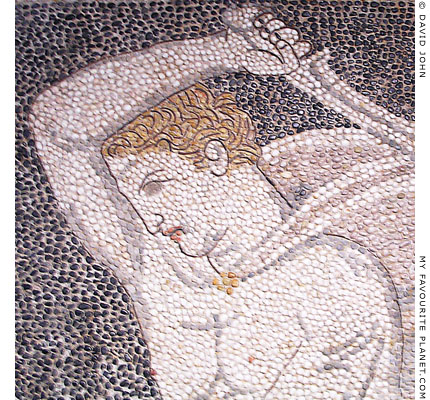
The hunter on the right in the Lion Hunt mosaic
in Pella, perhaps Alexander the Great. |
|
| |
Alexander
the Great |
The "Alexander Mosaic" from Pompeii |
|
 |
|

Detail of the "Alexander Mosaic", depicting Alexander the Great
on horseback, during a battle with the Persian King Darius III.
See a photo of the entire mosaic and further information below. |
| |
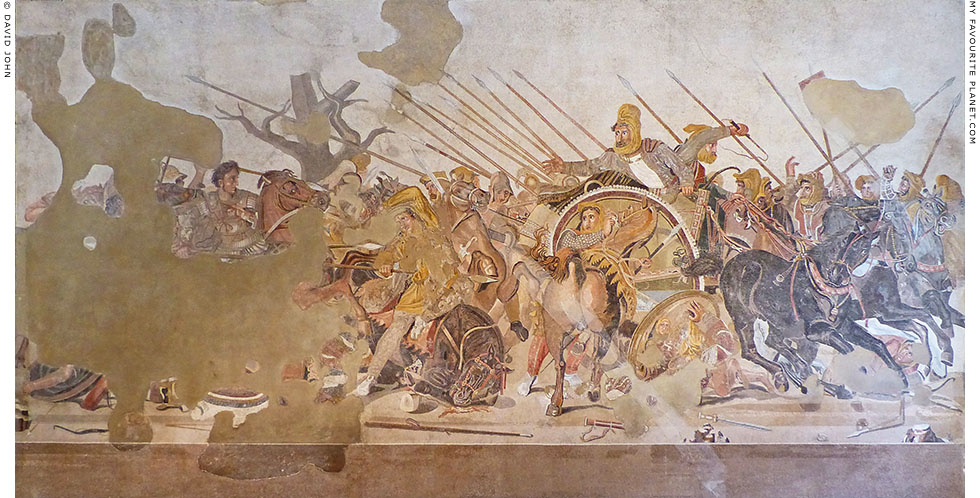
The "Alexander Mosaic" from Pompeii, depicting a battle between
Alexander the Great and the Persian King Darius III (circa 380-330 BC),
either the Battle of Issos in 333 BC or the Battle of Gaugamela in 331 BC.
Floor mosaic, made using the opus vermiculatum (Latin, worm-like work)
technique, of local stone and some glass tesserae. 200-100 BC.
National Archaeological Museum, Naples. Inv. No. 10020.
In this photo the mosaic frame around the image has been cropped.
See a photo of a reconstruction of the entire mosaic below. |
| |
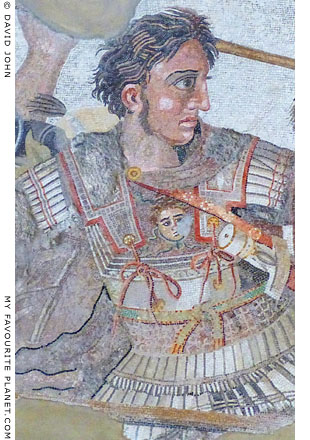
Alexander the Great wearing the Gorgoneion
on the breastplate of his linothorax (armour
made of layered and stiffened linen).
Photos: © David John |
|
Although a large area of tesserae on the left side of the mosaic is now missing, 26 combatants and 16 horses can still be seen in the dramatic battle scene. On the left Alexander the Great is shown bareheaded, wearing a linothorax (body armour made of stiffened linen layers) decorated with a Gorgoneion on the chest. Charging to the right on a brown horse, his spear, held in his lowered right hand, has gone straight through a companion of Darius. The Persian king himself appears highly alarmed as he looks and gestures towards the approaching Macedonian, and his chariot driver is already urging the horses to retreat to the right. Above the figures, 19 spears (plus at least 2 in the missing area) are raised diagonally against a grey-white sky, and in the background stands a large dead tree, which some scholars believe may point to Gaugamela as the location of the battle.
The large floor mosaic was discovered on 24 October 1831 in the tablinum of the House of the Faun (Casa del Fauno, VI 12, 2, 37, exedra), once the villa of a wealthy citizen of Pompeii, during excavations directed by Carlo Bonucci. [22]
The entire mosaic, including the frame of dentils (see photo below), is 582 cm wide and 313 cm high, and the picture area 512 x 271 cm [23].
It was moved to the National Archaeological Museum, Naples in September 1843 by Antonio Niccolini (1772-1850). Since it had originally decorated a floor the museum also displayed it on a floor. However it was reset on a wall in August 1915. [24]
The decision to exhibit the work on a vertical surface was undoubtedly a wise one. Several other museums consider such floor mosaics should be set on a floor to give visitors the impression of how they would have appeared to the people who lived with them in ancient times. Unfortunately, this approach makes it difficult to see such works in their entirety or appreciate the compositions, images, colours or workmanship. This is particularly true of such as large picture mosaics as this. Since it is believed that such works were copies of famous ancient paintings which have since disappeared, they are important sources for the study of Classical and Hellenistic art.
Much has been written about this work and the first articles appeared soon after its discovery. It is considered as one of the most important ancient mocaics yet discovered as it is thought to be a copy of a painting of a critical historical event made soon after it happened. Unfortunately, most of the accounts by contemporary writers and eye-witnesses of Alexander the Great's life and deeds, and the art works commemorating them (primary sources) have been lost, and we only have retellings by authors living centuries later.
There has been much debate over whether the image represents the Battle of Issos (or Issus) in 333 BC or the Battle of Gaugamela in 331 BC, both decisive battles at which Alexander and Darius faced each other to decide the future of western and central Asia, and ultimately of Europe.
It is thought by some scholars that the composition of the mosaic is based on a lost 4th century BC painting, perhaps one of those mentioned by ancient authors. Three painters of this period have been suggested as authors of the original work [25]:
Philoxenos of Eretria
Aristeides of Thebes
Helena of Egypt |
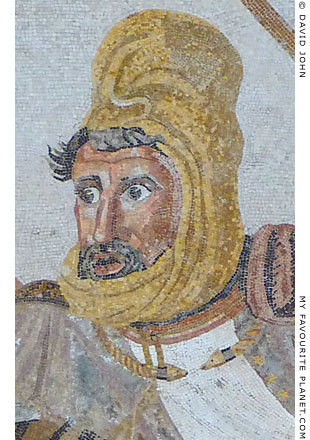
Persian King Darius III |
| |
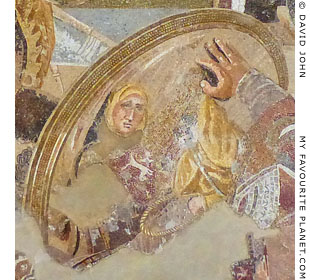
Fallen Persian sees his reflection in a shield. |
| |
| |
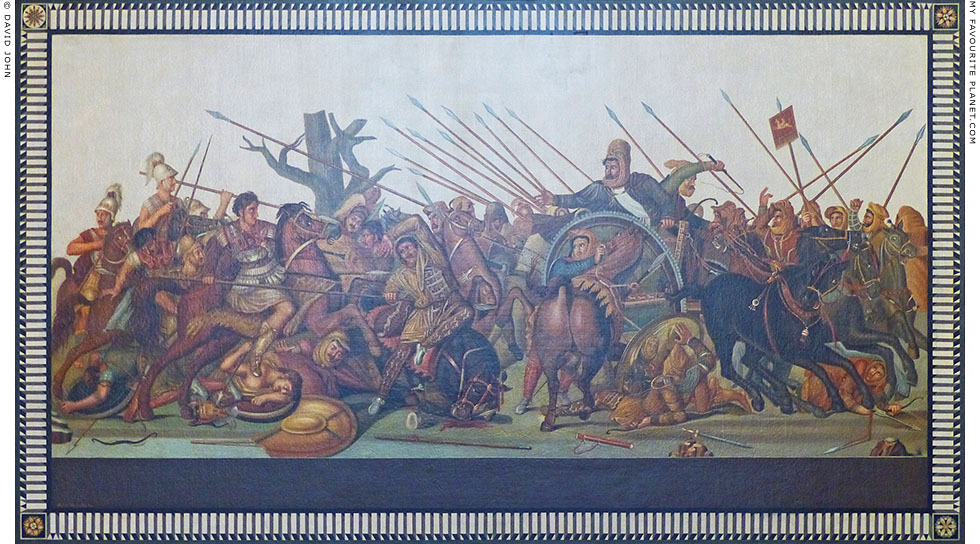
Modern reconstruction of the Alexander Mosaic, painted in oils soon
after its discovery. National Archaeological Museum, Naples.
The monochrome frame of the mosaic is in the form of rows of raised blocks
(dentils) rendered in perspective to give an illusion of three-dimensionality.
Each of the corners is decorated with a coloured floral emblem (rosette),
and the frame is surrounded by a band of grey-white tesserae. |
| |

Battle of Alexander the Great and Darius by Pietro da Cortona (Pietro Berrettini, 1596-1669).
Painted 1644-1650. Oil on canvas. Height 173 cm, width 375 cm.
Sala dei Trionfi (Hall of the Triumphs), Palazzo dei Conservatori, Capitoline Museums,
Rome. Inv. No. PC260. From the Sancchetti Collection.
|
Probably painted for Alessandro Sacchetti, Captain of the Papal troops and brother of Cardinal Guilio who was one of Pietro da Cortona's main patrons.
The Baroque painting is remarkable for its dynamic composition, vivid colours, virtuoso representation of the action, figures, costumes and other details. It was not possible for artists of this time to be historically accurate in their representation of such details as armour, weapons or breeds of horses. However, da Cortona created a scene of a battle, including the brutality, fear and chaos, to tell a story in a convincing way.
Even more remarkable is the similarity of the composition to that of the Alexander Mosaic, around two centuries before its discovery. As in the mosaic, Alexander on horseback (here with Zeus as an eagle flying above his head) charges to the right, towards the fleeing chariot of a surprised and fearful looking Darius. Around the two main figures, warriors are engaged in fierce close combat above the bodies of fallen soldiers and horses. Da Pietro has even included the device of massed upright spears above and behind the main field of action, although they play a less dominant role in the overall composition.
Whereas the mosaic maker gives us a view of the battle from more or less eye level, Da Pietro shows the scene from a more elevated perspective so that we are above the action, and the enormous scale of the battle can be suggested by the fighting figures in the background, particularly on the right of the scene, beyond which we can see part of a broad plain. On the left a mountain rises above the figures and a bright blue sky with dramatic clouds which echo the action on the ground.
Pietro da Cortona also made an imaginative drawing of an enormous statue of Alexander the Great carved out of the side of Mount Athos, based on a proposed design mentioned by ancient writers (see article below). |
|
| |

Darius marching to the Battle of Issus, by the workshop of the Florentine
painter Apollonio di Giovanni di Tomaso (circa 1414-1465).
Tempera on panel. Around 1450-1455. Height 48.5 cm, width 141.5 cm.
Rijksmuseum, Amsterdam. Inv. No. SK-A-3999. Acquired in 1960.
|
The painter Apollonio di Giovanni, also known as the "Master of the Jarves Cassone", had a workshop in Florence producing richly decorated furniture, and was one of the most prominent cassone specialists in the city. A cassone (plural cassoni) was a painted wooden chest, produced mainly as a wedding gift for a bride. Often produced in pairs, they were decorated with scenes of courtly romance or sometimes religious subjects, and from the 15th century increasingly with depictions of scenes from classical history and mythology, particularly those with a heroic character.
In this painting, which has been removed from its chest, the Persian king Darius III is shown travelling in procession with members of his court and guard to the Battle of Issos (333 BC). The figures are fashionably dressed in styles which would have been familiar to a 15th century European viewer, and mounted soldiers are shown in contemporary armour. Towns and towers in the background are those of Medieval Italy rather than the ancient Near East. The exotic ancient orient is indicated by the carriage of the king and those carrying golden religious objects, including a large idol and a flaming shrine, which may refer to Zoroastrian practice. Since cassoni were often produced in pairs, perhaps another chest painting depicted Alexander marching to meet Darius. The work certainly demonstrates the interest of artists and their wealthy customers in the stories of Alexander the Great during the late Middle Ages and early Renaisssance. |
|
| |
Alexander
the Great |
Alexander and the foundation of Smyrna |
|
 |
|
Pausanias related the story, perhaps a local legend, that the Ionian city of Smyrna (Σμύρνα; today Izmir, Turkey) was refounded by Alexander the Great. The area has been inhabited for around 8500 years, and the ancient city Old Smyrna (ἡ παλαιὰ Σμύρνα, Palaia Smyrna) was first founded as an Anatolian settlement around 3000 BC at the northeast of the Bay of Smyrna (Smyrna Harbour), the eastern end of the long Gulf of Smyrna (today the Gulf of Izmir). Its name appears in Hittite texts as "Tismurna". Around 1000 BC the Anatolians were supplanted by Aeolian Greek colonists from Thessaly and Boeotia, who in turn were displaced by Ionian Greeks from nearby Colophon. The ruins of the Archaic city can be visited in the archaeological site of Old Smyrna (Eski Izmir) at Tepekule in Bayraklı, today a northern suburb of Izmir.
Much of the old city was destroyed around 610-600 BC during the conquest by the Lydian king Alyattes II (ruled circa 617-560 BC, father of Croesus; see Herodotus, Histories, Book 1, chapter 16), when the Temple of Athena was badly damaged and the mud brick and polygonal stone city walls ruined. Although there was a phase of reconstruction, this was ended by the Persian conquest around 546 AD. It appears that by the 4th century BC the old city had declined, and like nearby Ephesus, it was refounded during the Hellenistic period at its present location, 7 kilometres further south along the eastern shore of the bay, below Mount Pagos (Πάγος), today named Kadifekale (Velvet Castle).
"Smyrna, one of the twelve Aeolian cities, built on that site which even now they call the old city, was seized by Ionians who set out from Colophon and displaced the Aeolians; subsequently, however, the Ionians allowed the Smyrnaeans to take their place in the general assembly at Panionium. The modern city was founded by Alexander, the son of Philip, in accordance with a vision in a dream.
It is said that Alexander was hunting on Mount Pagus, and that after the hunt was over he came to a sanctuary of the Nemeses, and found there a spring and a plane tree in front of the sanctuary, growing over the water. While he slept under the plane tree it is said that the Nemeses appeared and bade him found a city there and to remove into it the Smyrnaeans from the old city.
So the Smyrnaeans sent ambassadors to Clarus [an oracle of Apollo] to make inquiries about the circumstance, and the god made answer:
'Thrice, yes, four times blest will those men be
Who shall dwell in Pagus beyond the sacred Meles.'
So they migrated of their own free will, and believe now in two Nemeses instead of one, saying that their mother is Night [Νύκτα, Nykta], while the Athenians say that the father of the goddess in Rhamnus is Ocean [Ὠκεανος, Okeanos]."
Pausanias, Description of Greece, Book 7, chapter 5, sections 1-3. At Perseus Digital Library.
Pausanias added that according to another local legend, Homer lived in a cave near Smyrna, at the springs of the river Meles (ὁ Μέλης ποταμός, variously identified as the Melez Çayı, Yeşildere stream or the Halkpinar Suyu).
"The Smyrnaeans have the river Meles, with its lovely water, and at its springs is the grotto, where they say that Homer composed his poems."
Description of Greece, Book 7, chapter 5, section 12.
Pliny the Elder related that Smyrna was founded by Amazons (he wrote the same of Ephesus), and that it was refounded by Alexander, although he did not mention the dream.
"On returning thence [from Klazomenai] towards the coast, at a distance of twelve miles we find Smyrna, originally founded by an Amazon [of that name], and rebuilt by Alexander; it is refreshed by the river Meles, which rises not far off."
Pliny the Elder, Natural History, Book 5, chapter 31. At Perseus Digital Library.
A little more obscurely, in his Sacred Tales, the Sophist orator Aelius Aristides (Αἴλιος Ἀριστείδης; 117-181 AD), who lived in Smyrna, alluded to the legend of Alexander's dream.
"It is told that the sleep of Alexander was the prelude to the city's foundation." (20.7 [26])
As usual in foundation myths of ancient Greek cities, the legendary founder hero is given a divine sign of where to build the new city, and an oracle is consulted, in this case the temple of Apollo at nearby Klaros (Κλάρος, today Ahmetbeyli, south of Izmir). The story was depicted on the city's coins during the reigns of Roman emperors Marcus Aurelius, Gordianus III and Philip the Arab. No archaeological evidence has yet been found to prove that Alexander was ever in Smyrna or played any part in its rebuilding [27], but he may have passed through on a four-day journey he is said to have made from Sardis to Ephesus in June 334 AD (Arrian of Nicomedia, The Anabasis of Alexander, Book 1 chapter 17, at Wikisource).
Perhaps being more specific, the geographer Strabo wrote that the rebuilding of the city had been left to two of Alexander's generals and successors (Diadochi), first Antigonus I Monophthalmus ("the One-Eyed") and later Lysimachus.
"Next is another bay, on which is situated the ancient Smyrna, at the distance of 20 stadia from the present city. After Smyrna had been razed by the Lydians, the inhabitants continued for about four hundred years to live in villages. It was then restored by Antigonus, and afterwards by Lysimachus, and at present it is the most beautiful city in Ionia.
One portion of Smyrna is built up on a hill, but the greater part is in the plain near the harbour, the Metroum, and the Gymnasium. The division of the streets is excellent, and as nearly as possible in straight lines. There are paved roads, large quadrangular porticos, both on a level with the ground and with an upper story.
There is also a library, and the Homereium (Ὁμήρειον, Homereion), a quadrangular portico, which has a temple of Homer and a statue. For the Smyrnaeans, above all others, urge the claims of their city to be the birth-place of Homer, and they have a sort of brass money, called Homereium.
The river Meles flows near the walls. Besides other conveniences with which the city is furnished, there is a close harbour.
There is one, and not a trifling, defect in the work of the architects, that when they paved the roads, they did not make drains beneath them; the filth consequently lies on the surface, and, during rains particularly, the receptacles of the filth spread it over the streets.
Strabo, Geography, Book 14, chapter 1, section 37. At Perseus Digital Library.
The notion of two Nemeses (Νεμέσεις) is unusual, as Nemesis (Νέμεσις) was normally a single goddess of divine retribution and revenge. Rhamnous (Ῥαμνοῦς), near Marathon, Attica, was the location of a well-known sanctuary for Nemesis, where she was worshipped alongside Themis (Θέμις), the goddesss of divine order and justice (see Agorakritos of Paros and Chairestratos of Rhamnous).
A warped echo of the story of Alexander's visit to Smyrna survived in popular imagination into the Ottoman period. The 17th century Turkish traveller Evliya Çelebi (see Kuşadası gallery page 1) recounted that Kadifekale castle was said to have been named after a legendary queen Kaydafe. According to this folktale she captured Alexander when he came to negotiate with her, and set him free only when promised not to attack her country.
Another folktale concerning Alexander, Aristotle and a beautiful queen was told in connection of the "Incantadas" in Thessaloniki (see the Dioskouroi page). |
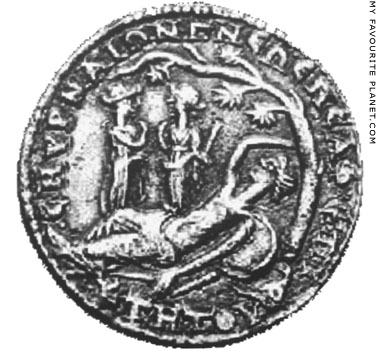
A Roman Imperial period coin of Smyrna showing
Alexander the Great sleeping under a plane tree
on Mount Pagos and dreaming of two Nemeses.
Reign of Philip the Arab, 244-249 AD. |
| |
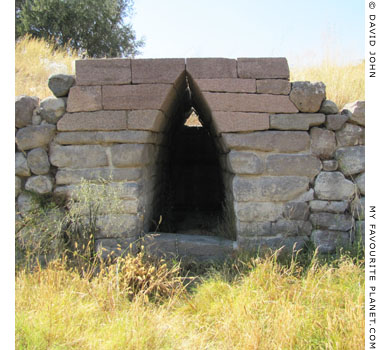
The Archaic monumental fountain, last quarter of
the 7th century BC, in the "Old Smyrna" (Eski Izmir)
archaeological site, at Bayraklı, north of Izmir. Inside
the 2.5 metre high rectangular stone structure a
corbelled tunnel, 5.1 metres long and 1.5 metes
wide, leads to a basin in which spring water was
collected and distributed through a channel. Both
channel and basin are in good condition, and the
latter is still full of water, even in mid-summer.
It was unearthed during the first archaeological
excavations carried out here 1948-1951 by a joint
British and Turkish team led by John M. Cook and
Ekrem Akurgal. Excavations of the old city have
since continued intermittently. |
| |
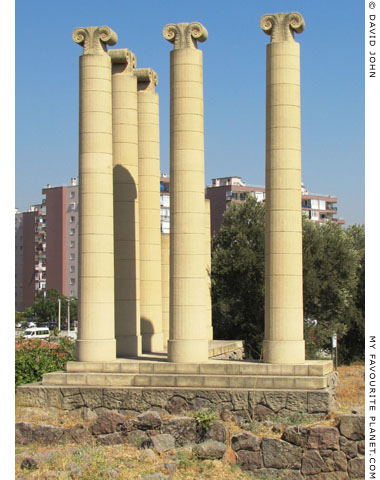
Modern reconstructions of Aiolic columns of the Temple
of Athena at the north of "Old Smyrna" archaeological
site. The temple was constructed in several phases from
the Geometric period to the early Archaic period, circa
725-610 BC, and repaired circa 610-546 BC, between
the invasion of Alyattes and the Persian conquest. |
| |
| |
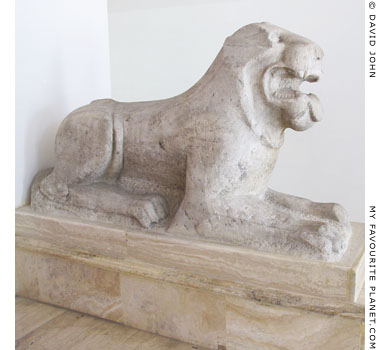
A colossal Archaic marble statue of a crouching lion,
one of a pair from ancient Smyrna. 6th century BC.
This lion found in 1965. Height 102 cm, length 193 cm,
width 51 cm.
Izmir Museum of History and Art. Inv. No. 5258.
The other lion, not so well preserved, found in 1925.
Height 82 cm, length 157.5 cm, width 40 cm. Inv. No. 328. |
|
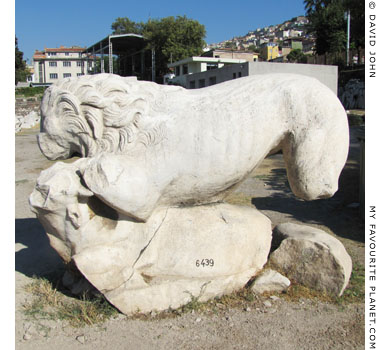
A marble statue of a lion attacking a bull, one
of a pair on display in the Hellenistic / Roman
Agora of Smyrna, Izmir city centre.
Inv. No. 6439 (the other 6440). |
|
| |

The state Agora of the "new" city of Smyrna, founded in the 4th century BC.
|
The Romans rebuilt the Agora, but following the destruction caused by a powerful earthquake in 178 AD, it was again rebuilt by Emperor Marcus Aurelius. Most of the remains here today are from the Roman period, with some foundations from the Hellenistic period, as well as gravestones and architectural fragments from the late Byzantine and Ottoman cemeteries. A number of columns have been reerected to give visitors an impression of the market place's former grandeur.
Here the bases and capitals of two Corinthian columns have been set up and support a long marble block from the entablature of a building, with part of a Greek inscription carved in fine Ionic lettering: "... Θ Ε Μ Ι Σ Ν Ε ..." (Themis ne...). Another inscription fragment found in the Agora, "... Ν Ε Μ Ε Σ Ε ..." (Nemese ...), may refer to the two Nemeses worshipped in the city.
In the background is the hill of Kadifekale (Velvet Castle), ancient Mount Pagos (Πάγος), on which Lysimachus (circa 360-281 BC) built a fortress from which two lines of defensive walls enclosing the new city descended to the sea. The fortress was rebuilt several times, and the remains now on the hilltop are mainly Byzantine and Ottoman.
See also high reliefs of Artemis, Poseidon and Demeter found in the agora of Smyrna. |
|
| |
Alexander
the Great |
Alexander and Priene |
|
 |
|

An inscription naming Alexander the Great as dedicator of the
temple of Athena Polias, Priene (Πριήνη), Ionia, Anatolia (Asia Minor).
ΒΑΣΙΛΕΥΣ ΑΛΕΞΑΝΔΡΟΣ
ΑΝΕΘΗΚΕ ΤΟΝ ΝΑΟΝ
ΑΘΗΝΑ Η ΠΟΛΙΑΔΙ
King Alexander dedicated the temple to Athena Polias
334-330 BC. A wall block from the anta of the temple.
Height 49.53 cm, width 120.65 cm.
British Museum. Inv. No. GR 1870,0320.88 (part) (Inscription 399).
|
The inscription was discovered at the temple during excavations at Priene in 1868-1869, directed by the architect Richard Popplewell Pullan (1825-1888) on behalf of the Society of Dilettanti. It was shipped with other finds from Priene to England and donated to the British Museum in 1870.
Alexander visited Priene in 334 BC, when the Ionic temple designed by the architect Pytheos was still under construction. He left funds for its completion, for which he was named as the dedicator. Two other inscribed blocks below this dedication detail Alexander's funding of the temple.
At Ephesus his offer to pay for the rebuilding of the Temple of Artemis had been diplomatically turned down, on the grounds that it would be unfitting for a god to make dedications to other gods.
"Artemidorus says that Alexander promised to defray the expense of its restoration, both what had been and what would be incurred, on condition that the work should be attributed to him in the inscription, but the Ephesians refused to accede to this. Much less, then, would they be disposed to acquire fame by sacrilege and spoliation. He praises also the reply of an Ephesian to the king, 'that it was not fit that a god should provide temples in honour of gods.'"
Strabo, Geography, Book 14, chapter 1, section 23. At Perseus Digital Library. |
|
| |
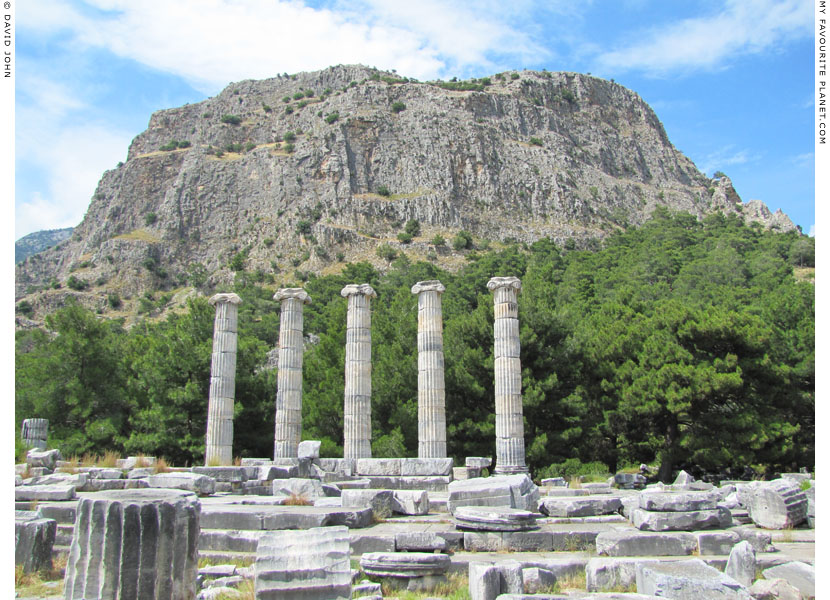
The ruins of the temple of Athena Polias in Priene, designed by the architect
Pytheos in the 4th century BC, and finally completed during the reign
of Emperor Augustus (27 BC - 14 AD). Five reconstructed Ionic columns of
the north side of the temple (originally there were eleven) stand against
the city's 381 metre high acropolis, on the southeast side of Mount Mykale. |
| |
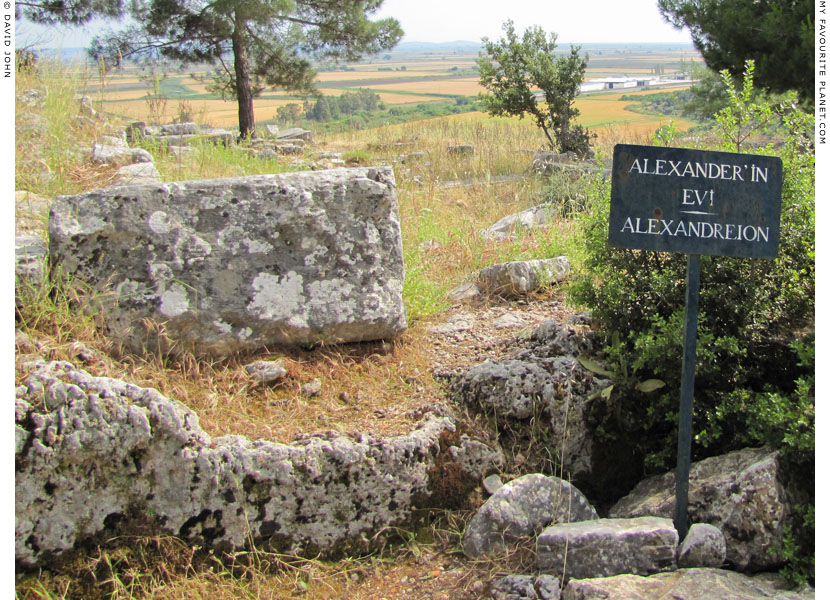
The site of the "House of Alexander the Great", "Alexandreion" (Turkish, Alexander'in Evi)
or "Sacred House" on the south side of the West Gate Street in Priene, among similar
ruins of rows of houses along both sides of the street (see plan below). All that now
remains are strewn stone blocks, lower parts of walls and part of a pebble mosaic floor.
The house is believed to have been where Alexander the Great may have lived during his
visit to Priene in 334 BC, and the location of an Alexandreion where he was worshipped.
A fragmentary marble statuette of Alexander (see above) and other and objects associated
with religious sacrifice appear to support this theory. |
| |
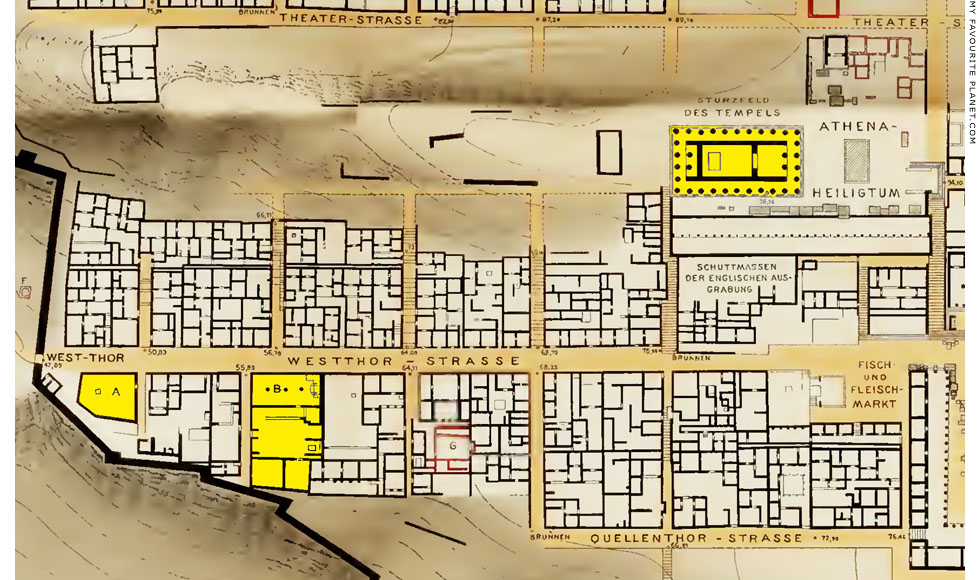
Plan of the west of Priene showing the location of the "House of Alexander the Great" (B), House 22,
3rd insula, on West Gate Street (Westthor Strasse), just to the east of the sanctuary of Kybele (A).
The steep street led up from the city's western gate to the fish and meat market and the main agora.
Further uphill to the northeast is the sanctuary and the temple of Athena Polias (marked yellow).
Image source: Theodor Wiegand (1864-1936) and Johann (Hans) Schrader (1869-1948),
Priene: Ergebnisse der Ausgrabungen und Untersuchungen in den Jahren 1895-1898.
Königliche Museen zu Berlin. Georg Reimer, Berlin, 1904. At archive.org.
Schrader described the house and the archaeological finds in
V., 6. "Das heilige Haus an der Westthorstrasse", pages 172-182. |
| |
Alexander
the Great |
Inscriptions from Thessaloniki |
|
 |
|
| |
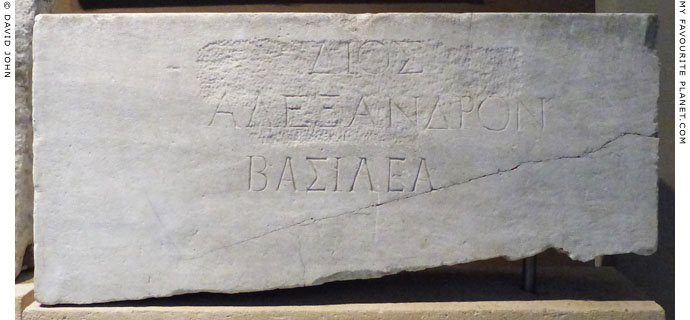
Inscribed building slab commemorating Alexander the Great as a son of Zeus.
Διὸς
Ἀλέξανδρον
βασιλέα.
Inscription IG X,2 1 275
From Thessaloniki, 150-200 AD.
Thessaloniki Archaeological Museum. |
| |
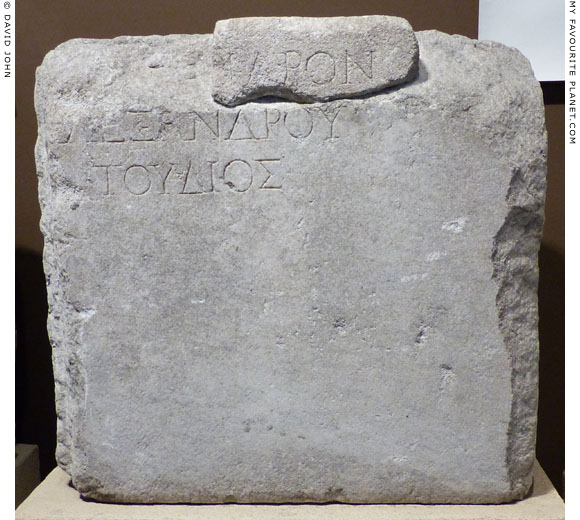
Inscribed building slab commemorating Alexander IV (Ἀλέξανδρος Δ΄, 323/322 - 310/309 BC),
the son of Alexander the Great and Roxana. Alexander the Great is named as a son of Zeus.
Alexander junior and Roxana are said to have been murdered by Cassander, who founded
Thessaloniki (Θεσσαλονίκη, Thessalonike, Thessalian Victory) around 315 BC, naming it after
his wife, half sister of Alexander senior (see History of Stageira and Olympiada part 6).
[Ἀλέξα]ν̣δρον
[Ἀ]λεξά̣νδρου
τοῦ ∙ Διός.
To Alexander, son of Alexander, son of Zeus.
Inscription IG X,2 1 276.
From Thessaloniki, 150-200 AD.
Thessaloniki Archaeological Museum. |
| |

Inscribed marble base of a bronze statue of Alexander the Great
from Thessaloniki, hounouring him as a son of Zeus.
[ἡ] π̣όλις
βασιλέα ∙ μέγαν Διὸς ∙ Ἀλέ-
ξανδρον.
The city, to King Alexander the Great, son of Zeus.
Inscription SEG 47:960 (Epigraphes archaias Makedonias (1997), 57, 45).
Severan dynasty, late 2nd - early 3rd centuries AD.
Thessaloniki Archaeological Museum. Inv. No. 11318. |
| |
Alexander
the Great |
Alexander and Diogenes in Corinth |
|
 |
|
| |
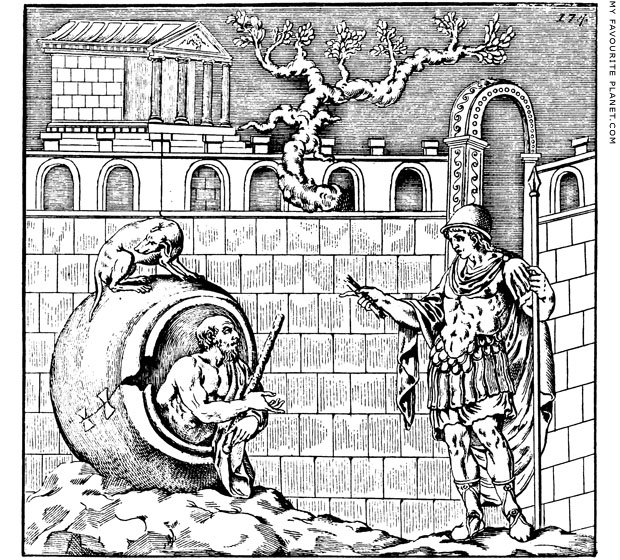
A marble bas-relief in the Villa Albani, Rome, depicting
Alexander meeting the philosopher Diogenes at Corinth.
Roman, late 2nd century AD.
An engraving made by Giovanni Battista Casanova for Johann Joachim Winckelmann.
From the Albani Collection. Inv. No. 161. Now in the Torlonia Collection, Rome.
|
The relief is said to have been discovered by workmen in May 1726 at Monte Testaccio, near the Porta di S. Paolo, Rome. The artist Pier Leone Ghezzi claimed to have been drinking wine nearby at the time and to have purchased the find for one scudo. Soon after it was acquired by the art dealer Philipp von Stosch, who had it restored to its present state, which included the addition of the figure of Alexander and the head of Diogenes, based on other ancient sculptures. At some point it was acquired by Cardinal Alessandro Albani for his collection in the Villa Albani.
Alexander's anecdotal meeting with the philosopher Diogenes of Sinope (Διογένης, 412 or 404 - 323 BC) is mentioned by ancient writers, including Plutarch, who tells us that it occurred when the king was at a general assembly of the Greeks at Corinth, probably in 336 BC.
"And now a general assembly of the Greeks was held at the Isthmus [Corinth], where a vote was passed to make an expedition against Persia with Alexander, and he was proclaimed their leader. Thereupon many statesmen and philosophers came to him with their congratulations, and he expected that Diogenes of Sinope also, who was tarrying in Corinth, would do likewise.
But since that philosopher took not the slightest notice of Alexander, and continued to enjoy his leisure in the suburb Craneion, Alexander went in person to see him; and he found him lying in the sun. Diogenes raised himself up a little when he saw so many persons coming towards him, and fixed his eyes upon Alexander. And when that monarch addressed him with greetings, and asked if he wanted anything, 'Yes,' said Diogenes, 'stand a little out of my sun.'
It is said that Alexander was so struck by this, and admired so much the haughtiness and grandeur of the man who had nothing but scorn for him, that he said to his followers, who were laughing and jesting about the philosopher as they went away, 'But verily, if I were not Alexander, I would be Diogenes.'"
Plutarch, The Parallel Lives, The Life of Alexander (Part 1 of 7), chapter 14, sections 1-5. Loeb Classical Library, Volume VII, 1919. At Bill Thayer's website LacusCurtius.
Kraneion (Κράνειον) was a cypress grove on the southeast of Corinth, outside the city walls, with a temple of Aphrodite Melainis (Αφροδίτη Μελαίνις), a chthonic deity worshipped in cemeteries. The gymnasium there became a meeting place for philosophers. Pausanias wrote that Diogenes was buried by the city gate at Kraneion (Description of Greece, Book 2, chapter 2, section 4).
The anecdote was also related by the Roman orator Cicero (106-43 BC), although he did not mention the location or the historical occasion of the meeting.
"But Diogenes took a greater liberty, like a Cynic, when Alexander asked him if he wanted anything: 'Just at present,' said he, 'I wish that you would stand a little out of the line between me and the sun,' for Alexander was hindering him from sunning himself. And, indeed, this very man used to maintain how much he surpassed the Persian king in his manner of life and fortune; for that he himself was in want of nothing, while the other never had enough; and that he had no inclination for those pleasures of which the other could never get enough to satisfy himself; and that the other could never obtain his."
Cicero, Tusculan disputations, Book V: Whether virtue alone be sufficient for a happy life, chapter 32. In: Cicero's Tusculan disputations; also Treatises on the nature of the gods, and On the commonwealth. Translated by Charles Duke Yonge. Harper & Brothers, New York, 1877. At Project Gutenberg.
The scenery of the relief is most probably imaginary or generic, not reflecting the appearance of Corinth, particularly not the city of the 4th century BC. Alexander, in armour and holding a spear (not the garb he is likely to have chosen for a political assembly), stands in front of an arched gateway (an anachronism) of the city walls above which a raised Ionic prostyle temple can be seen. The gnarled tree branch growing from the wall and the rough ground in front probably indicate a rural area outside the city.
Diogenes is said to have lived in a large amphora or pithos (not a barrel, since they had not yet been invented, nor a tub, see below), although he did not necessarily spend his days lounging in it. The dog on top of it is an allusion to the Cynical philosopher's nickname "the Dog", perhaps from the Greek word cynic (κυνικός, kynikos, dog-like; from κύων, kyon, dog). The Cynics were thought to have been given their name because Antisthenes (Ἀντισθένης; circa 445-365 BC) taught in the gymnasium at Cynosarges (Κυνόσαργες, Kynosarges, place of the white dog), a sanctuary of Herakles east of the Athens city walls, near the Ilissos river (see a map of ancient Athens in Digging Aristotle at The Cheshire Cat Blog).
The description of the relief by the art historian Johann Joachim Winckelmann (1717-1768) and the illustration were published in:
Johann Joachim Winckelmann, Monumenti antichi inediti spiegati ed illustrati da Giovanni Winckelmann, Volume I (Unedited antique monuments, described and illustrated by Giovanni Winckelmann), plate 174. Rome, 1767. At Heidelberg University Digital Library.
A short description of the relief also appears in:
Wolfgang Helbig and Emil Reisch, Guide to the public collections of classical antiquities in Rome, Volume 2, Villa Albani, No. 809 (161), Relief of Diogenes and Alexander the Great, page 63. English translation by James Fullarton Muirhead and Findlay Muirhead. Karl Baedeker, Leipzig, 1896. At the Internet Archive.
Much of the Albani Collection was later sold off and the works are now dispersed among many collections and museums around the world (for example, the Capitoline Museums, Naples, Dresden and the Louvre). However, several works are still in the private collection of the Villa Albani which has belonged to the Torlonia family since 1866. Kept in storage for many years, plans were set in motion in 2016 to finally exhibit the works to the public. |
|
| |
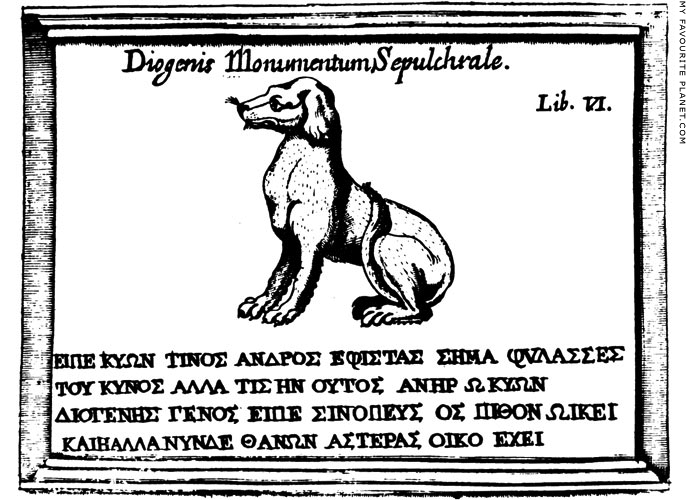
And while we're on the subject of Diogenes ...
A drawing of the epitaph of Diogenes in Venice by George Wheler.
|
The travellers Jacob Spon and George Wheler visited Corinth in 1676, noting the topography, water supply, ruins and inscriptions of the city. Wheler wrote about Diogenes' epitaph in Venice and his life, but made no mention of the story of his meeting with Alexander.
"We found not the tomb of Diogenes the Cinick: which was in times past by the entrance into the town coming from the Isthmus. But we saw it and copied his epitaph at Venice, in the palace of Signior Erizzo, upon a marble, under the basso-relievo of a dog; which we suppose was brought from hence, when the Morea was under the dominion of that state.
On it is an epigram, that importeth thus much. Supposing a passenger going that way, enquireth of the dog, whose tomb he guardeth? He answers, The Dogs. But who is this man you call the Dog? Answer is made, Diogenes the Cinick, who lived in a tub: But now being dead, inhabits among the stars. This rigid philosopher, Diogenes, who lived in a tub, was a native of Sinope; but his sowre and austere nature and discipline having changed his nature: it seems they changed his name from that of Σινοπεὐς to Κυνοπεὐς, his nature being transformed from humanity to the churlishness of a dog. He was one of the magistrates of his city; and flattered by the oracle, aspir'd to the highest place in it by coining of false money: but for this he was chased from Sinope, and fled to Athens: where he came acquainted with that great philosopher, Antisthenes, who disputed so much against the seeking of glory. He fell afterwards, passing by sea, into the hands of pyrats who brought him to be sold in the publick market-place: where being asked what he could do, he answer'd govern men; and seeing a certain spend thrift of Corinth, he desired he might be sold to him, because he wanted a governour: who bought him, and set him to teach his children: where he lived and died."
George Wheler, A journey into Greece, pages 444-445. London, 1682. Wheler's spelling, punctuation and italics. |
|
| |
Alexander
the Great |
Alexander and the Gordian Knot |
|
 |
|
| |
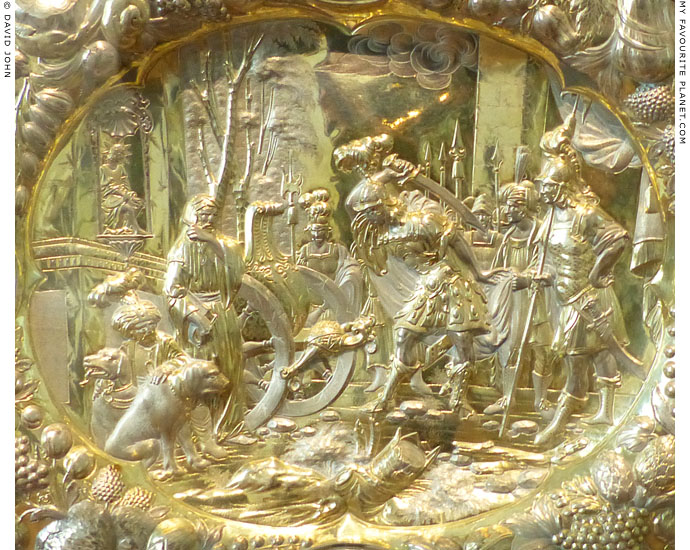
Alexander the Great cutting the Gordian knot with his sword.
Centre of a repoussé, gilded silver decorative dish, made around 1670-1674 in Augsburg,
Bavaria, by Alexander Warnberger II (born 1632, master goldsmith 1664-1704).
The scene is surrounded by portraits of Roman emperors Claudius, Nero, Otho and Galba.
Museum für Kunst und Gewerbe Hamburg. Inv. No. 2007.284.
|
According to an oracle, supremacy over Asia would be gained by whoever could undo the intricate knot of cornel bark tied to the ox-cart (in art usually depicted as a chariot) of King Gordias of Phrygia, the legendary or mythical founder of Gordion (Γόρδιον, central Anatolia) and father of Midas. While Alexander was in Gordion in 334-333 BC, he is said to have sliced through the knot with a single stroke of his sword.
Alexander bends forward intently, legs astride, his right arm raised high and bent back, with the forearm and sword hand behind his head. His left arm is held rigid at his side, with the hand stretched back horizontally. His mind and body are totally concentrated on destroying the knot tied to the shaft of the massive chariot which is stretched before him like a sacrificial animal. The pose is full of tension and determination, but the figure remains graceful. He is watched attentively by a similarly-armoured companion (Hephaistion?). Both he and Alexander have curved, scimitar-like swords. The Macedonian army is suggested by a small cluster of four soldiers in the background holding upright spears, and even one with a halbard, and like Alexander and his companion, wearing a plumed helmet.
To the left of Alexander, the long-robed priest solemnly points back behind him to a statue of a seated Helios who looks down from an ornate niche, high on the side of a tall monument. The brooding cloud high above may stand for Zeus. The two figures in turbans presumably represent Asians. One tends two ferocious hunting dogs (Molossians?), while the other holds one end of a long cloth (the cover of the ancient chariot?), which, passing behind Alexander, appears to be supported at the other end by the soldier with the halbard. The stump of a dead tree leans into the rocky foreground. The edge of a curtain on the far right underlines the theatricality of the scene.
An almost identical dish, made in Augsburg around 1692-1700 by Marx Weinold (master 1665, died 1700), shows the same scene mirrored. National Museum, Warsaw, Poland, Inv. No. SZM 11403.
See: commons.wikimedia.org/wiki/File:Weinold_Cutting_the_Gordian_Knot_01.jpg |
|
| |
Alexander
the Great |
The Ascension of Alexander |
|
 |
|
| |
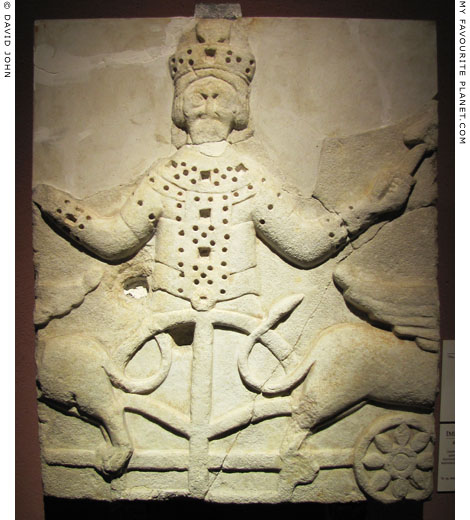
A Byzantine marble relief depicting the ascension of Alexander the Great.
Late 10th - early 11th century AD. Found in the area of
the site of the Forum of Theodosius, Beyazit, Istanbul.
Istanbul Archaeological Museum. Inv. No. 5799 T.
|
One of several Medieval images showing Alexander the Great, depicted as a contemporary king or emperor, ascending to heaven on a chariot-like device drawn by two griffins (or gryphons). Images of the type known as "the ascension of Alexander the Great", "Alexander’s celestial journey" and "the aerial flight of Alexander the Great" appeared from around the 9th century AD, until the 13th century on sculptures, reliefs and mosaics in or on the exterior of churches, and until the 16th century in miniatures in manuscripts and on tapestries. Such representations have been found over an enormously wide geographic area, from Chester in northern England to the Yamalo-Nenetz district of Siberia. [28]
The literary source for the imagery is thought to have been a largely fictional account of Alexander's life known as the Alexander romance. The earliest known version is in Greek and dated to the 3rd century AD, containing legends about Alexander, some of which may have been in circulation during his lifetime or shortly after. The work was traditionally attributed to Callisthenes of Olynthos (Καλλισθένης, Kallisthenes, circa 360-328 BC), a great nephew of Aristotle, who accompanied Alexander on his military campaigns and wrote an account of them. This attribution was later considered implausible due to the fantastic nature of the narrative, and because Callisthenes was executed by Alexander and could not have written about the king's entire life. The author is therefore usually referred to as Pseudo-Callisthenes.
Later versions, with various interpolations, embellishments and fabulous episodes, were written in several languages, including Latin, Arabic, Hebrew, Armenian, Syriac, French and English. Not all versions include the episode in which Alexander captures two fantastic birds or griffins, tethers them and has them pull him up into the sky to explore the heavens. As in several other ascension images, the relief above shows the figure holding up two sticks on the end of which are pieces of meat used to coax the griffins into flight (see also photos below).
The depictions of Alexander on a large number of Medieval artefacts across the Christian and Muslim world are evidence of the continuing popular fascination with the legends of the king as a wise ruler and accomplished, fearless warrior. The reasons for the use of the ascension scene to decorate churches are uncertain: either they were meant to illustrate Alexander's arrogant and sinful pride (hubris, or in Christian terms, exemplum superbiae, an example of pride) in attempting to fly to heaven, or as an allegory of the king as the ideal earthly ruler seeking spiritual salvation, whose ascension was associated with that of Christ. |
|
| |
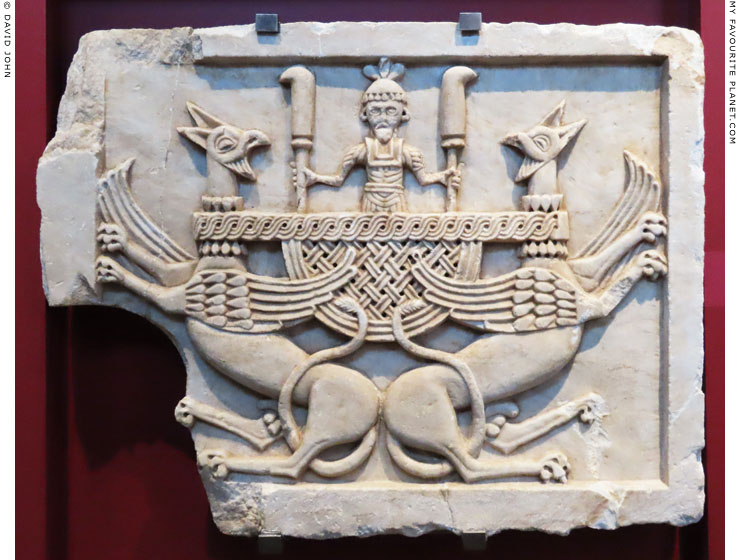
A Byzantine marble panel with a relief depicting the ascension of Alexander the Great.
12th century AD. Found in the Byzantine fortifications of Chalkis on the
island of Evia (Euboea), central Greece. Height 90 cm, width 118 cm.
New Archaeological Museum "Arethousa", Chalkis, Evia.
Formerly in the Exhibition of Architectural Sculptures, Karababa Fortress,
Chalkis (see below), where now a replica is displayed. |
| |

A Byzantine limestone column capital with a relief of the ascension of Alexander
on the main face (centre). On the left side is a griffin, and on the right side a
stork attacks a snake. The rear is undecorated.
13th - 14th century AD. Provenance not stated.
Exhibition of Architectural Sculptures, Karababa Fortress, Chalkis, Evia. |
| |
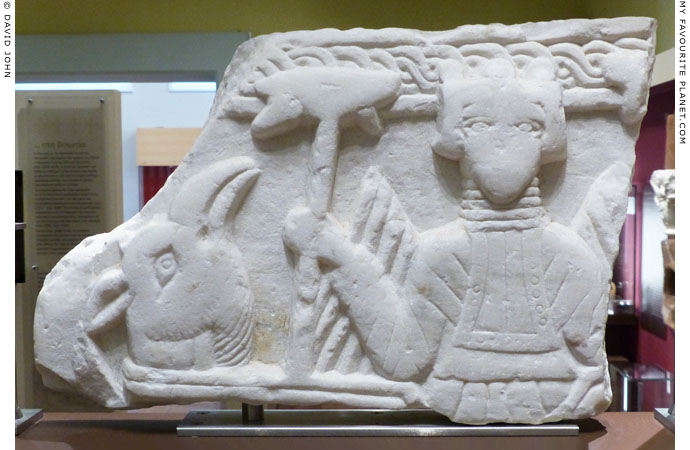
A fragment of a marble plaque from Thebes with a relief of the ascension of Alexander the Great.
In his right hand the king holds a large chunk of meat on a stick, which a griffin tries to reach.
12th - 13th century AD.
Thebes Archaeological Museum. |
| |
Alexander
the Great |
Modern depictions of Alexander |
|
 |
|
| |
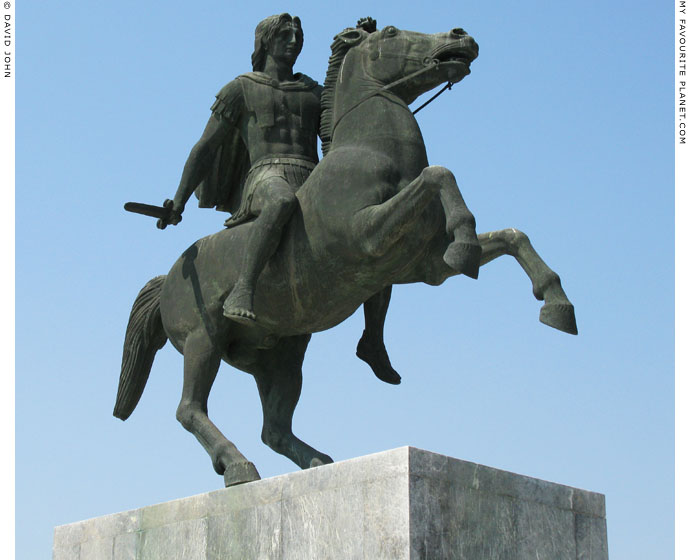
The modern equestrian statue of Alexander the Great
by Evangelos Moustakas on the seafront of Thessaloniki.
|
This colossal bronze sculpture of Alexander, made 1971-1974 by Evangelos Moustakas (Ευάγγελος Μουστάκας), stands on a high plinth at the southeast of Thessaloniki's long seaside promenade, near the city's trademark White Tower (Lefkos Pirgos) and the Achaeological Museum. It portrays the great conquerer, placid but resolute, his sword at the ready, looking into the far distance; he faces eastward - towards Asia. The drama and excitement in the work are provided by the agitated state of his rearing horse, the renowned Bucephalos, echoing ancient portrayals of Alexander in action (see photos above). As in ancient depictions of him, such as the "Alexander Sarcophagus", he is shown wearing a short cloak which billows out behind him, rather like a modern comic book super hero.
During the 20th century Greece as a whole and Macedonia in particular rediscovered Alexander in a big way. Once again he is seen as the great pan-Hellenic hero, a defiant unifying symbol and a heritage trademark both for the country and the region. Statues and busts of him can be found in town squares and public buildings (see photos below). Even the airport of Kavala has been named after him.
Evangelos Moustakas was born in 1930 in Piraeus. His design won the 1971 competition for an Alexander the Great monument in Thessaloniki, contested by twenty five Greek sculptors and judged by a committee which included the archaeologist Manolis Andronikos (Μανόλης Ανδρόνικος, 1919-1992). Two previous competitions had failed to provide an acceptable design. The bronze elements were cast and welded in an Italian foundry, and the monument was unveiled on 30 August 1974 (Saint Alexander's Day).
The public park area around "Alexander's Garden" (ο κήπος του Αλεξάνδρου), the piazza on which the monument stands, was reopened to the public in 2014 after substantial renovation which began in 2011. The tree-lined piazza connects 30th October 1944 Avenue (Λεωφόρος 30ης Οκτωβρίου 1944, Leoforos 30is Oktovriou 1944), on the landward side, with the broad pedestrianized seaside promenade.
The statue is 6 metres high, 11 metres high with the marble-clad plinth, and 7 metres long; the head of Bucephalos is 2 metres long. A masterpiece of balance, the sculpture's entire mass is supported only by the horse's rear legs. It is flanked by two rows of 3-metre high sarissas (long Macedonian spears) - three on the north side of the statue and five to the west - on which hang round shields, each decorated with a relief symbolizing the insignia of Alexander's military corps: a snake, a bull's head, a lion, an eagle, a hawk and a Gorgoneion.
To the west of the statue stands a 15.2 metre long bronze relief with 45 figures, representing the Battle of Issos (333 BC). A Greek cavalryman and a group of infantrymen advance from the left (in ancient Greek iconography the victors of a battle were traditionally shown on the left), led by Alexander on horseback charging at the chariot of the fleeing Darius. On the right stands a group of Persian infantrymen.
It is notable that Alexander (and his father Philip II in another nearby statue) is commemorated here and elsewhere as a heroic military leader rather than for the effects his life and deeds had on the cultures of Europe and Asia. Generally accepted by historians as a genius with broad intellectual and cultural interests, he seems fated to remain in the popular consciousness as a warrior, conquerer and tactician.
Symbolic reminders of warfare and militarism in this part of Thessaloniki are not confined to these sculptures or other martial monuments. The White Tower and the city's walls are testimony to a long history of wars and foreign occupation, and 30th October 1944 Avenue is named after the date of the liberation of Thessaloniki from the Nazi occupying forces by the Greek resistance army ELAS. Ensuing power struggles between left and right divided the already devastated and impoverished Greece and flared up into a bitter civil war which had disastrous effects on the populations of Macedonia and Thrace.
The Alexander the Great Statue (Άγαλμα Μεγάλου Αλεξάνδρου) was commissioned during the Greek military dictatorship (the Colonels' Junta, 1967-1974), at a time when troops were stationed around the nearby university to control potential student and public unrest, and many opposition leaders, intellectuals and artists were imprisoned. Most of Moustakas' public sculpture commissions were for war memorials, including a number around Greece commemorating fallen airmen.
As Moustakas himself commented, at the time when the statue was being put in place in summer 1974, civil conflict in Cyprus led to the Turkish invasion of the island. The consequent loss of face for the Greek military was among the factors, including student demonstrations (particularly at the Athens Polytechnic) supported by artists, intellectuals and working people, which caused the collapse of the dictatorship. |
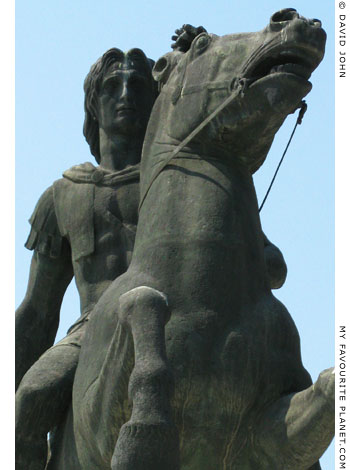
Alexander and Bucephalos in Thessaloniki.
Evangelos Moustakas' website:
vagelismoustakas.com
(in Greek and English) |
| |
|

A modern bronze bust of Alexander the Great
in the lobby of Serres Town Hall, Macedonia.
The composition is loosely based on the Azara Herm ( see above), and the lower part of the herm bust is inscribed AΛEΞANΔPOΣ (Alexandros), but the face appears not to have been copied directly from any existing ancient portrait of Alexander. It may be a product of the sculptor's own imagination, and is quite a modern conception. |
|

"Alexandros 2000", a modern larger than lifesize bronze head
of Alexander the Great in Thessaloniki "Macedonia" Airport.
Made by Veria-born artist Efthymios "Makis" Warlamis (also
spelled Varlamis; Ευθύμιος «Μάκης» Βαρλάμης, 1942-2016),
as part of the project Alexander 2000 - The Spirit of Tolerance.
Although modelled on ancient portraits of Alexander, the head has been rendered in a "modern" 20th century style, including deliberate distortion of the features. The surface has been roughened to give it an "antique" look, and the pitting on the sides of the face, typical of clay maquettes from which bronze sculptures are traditionally moulded, has been left unsmoothed.
It has the character of a mask, since Warlamis has concentrated on the face and omitted the ears and rest of the head, emphasizing the oversized eyes and the small mouth with its slightly pursed lips. As in the ancient heads, the eyebrows are hairless, but here the ridges have been rounded, making them seem more naked. An arrangement of overlapped olive leaves over the left side of the forehead signify a victory wreath but also stand in for the king's swept-back hair. The result appears to be the image of an intelligent young man, battered and scarred, lifting his head and eyes to the heavens in an expression of hope or supplication.
The sculpture is displayed in a prominent place in the centre of the departures hall of the airport. Originally exhibited on a tall plinth, it has now been consigned to a glass-windowed case against a wall. There is no information about the sculpture, just the legends "Ἀλέξανδρος 2000 / Alexander the Great" and "Βαρλάμης / Varlamis" in large raised lettering on the front of the case. To either side of the case, the English and Greek texts of the "oath" of Alexander the Great [29] are displayed on plexiglass plaques. |
|
| |

The modern bronze equestrian statue of Alexander the Great
in the centre of Pella, Macedonia, Greece.
|
Not quite as dramatic or warlike as the Thessaloniki statue, the handsome Άγαλμα του Μεγάλου Αλεξάνδρου (Agalma tou Megalou Alexandrou, Statue of Alexander the Great) in the centre of Pella village depicts the Macedonian king riding Bucephalos, striding calmly but boldly, into his hometown. Alexander returns carrying, in his raised right hand, the symbol of his victorious career in the form of a small figure of a winged Nike, Greek goddess of victory, standing on an orb, holding high a laurel wreath to crown a winner. Although he wears military garb with a sword, the general effect of the statue is more peaceful than the dramatic and overtly martial statue in Thessaloniki.
The larger than lifesize bronze statue stands on a rectangular bronze base, placed on a tall marble-clad plinth. The surrounding monumental marble platform is designed in the same way as war monuments, and even has the kind of steps in front which dignitaries ascend to lay wreaths to fallen military heroes on particular anniversaries. Pella's main square, in front of the town hall has even been renamed Plateia Megalou Alexandrou (Πλατεία Μεγάλου Αλεξάνδρου, Alexander the Great Square) after the monument, which stands on its northeast corner.
The front of the plinth is inscribed with Alexander's name, Ἀλέξανδρος ὁ Μέγας (Alexandros o Megas, Alexander the Great), and a smaller inscription below records that the statue was officially unveiled on 25th May 2002, no doubt with great pomp, ceremony and several speeches. Scratched on the back of the base are the names of the sculpture's makers, K. Xyterio (Κ. Χγτηριο) and M. Gabala (Μ. Γαβαλα).
A very similar, perhaps identical, statue has been set up in front of the Alexandrion (Αλεξάνδρειον), the centre of the private Alexander the Great Institute at Lithocoro, near Dion, Macedonia, and another stands in Alexandria, Egypt, which was founded by Alexander.
More controversially, plans to set up statues of Alexander the Great in the former Yugolavian Republic of Macedonia (since February 2019 officially named the Republic of North Macedonia, see Introduction to Macedonia, Geece) caused an outcry among Greeks, who accused the govenment in Skopje of attempting to appropriate Greek Macedonian heritage and identity. As a result of deescalation of political antagonism between the two countries, the bronze equestrian statue of Alexander at Skopje "Alexander the Great" Airport, donated by the Turkish owned company TAV, which manages the airport, and erected in 2011, was removed in March 2018 and the airport renamed.
Athens finally has its first modern monument to Alexander the Great, set up opposite in the city centre in 2019. See below. |
|
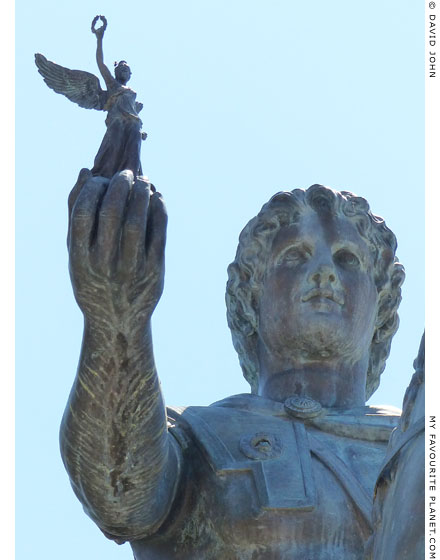
Alexander and Nike in Pella. |
|
| |
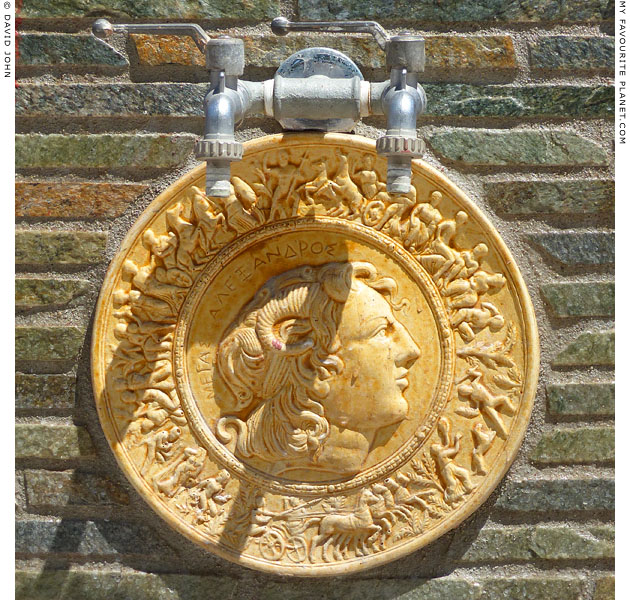
A modern round ceramic plaque with a portrait head of Alexander the Great in Pella.
The portrait of Alexander, shown in profile wearing the ram's horns of Zeus Ammon,
is based on ancient coins (see a coin of Lysimachus and an Aboukir medallion
above). It is surrounded by a countinuous relief frieze depicting war scenes.
On the front of a water fountain in the courtyard of the Agoi Apostoli church (Άγιοι Απόστολοι,
Holy Apostles), on the northeast edge of Pella village. An earlier, more modest tribute to Pella's
most famous native. Pella was known as Agoi Apostoli during the Byzantine and Ottoman periods.
This church was built in 1867, but there is no indication of when or by whom the plaque was made. |
| |

Alexander and the eye of faith.
The rock-face of "Alexander the Great" on Mount Kerdylion.
|
The rocky side of a hill, around 600 metres high and about half way up the wooded south slope of Mount Kerdylion (Ὄρος Κερδύλιον), 2 kilometres west of the Northern Aegean resort Asprovalta (Ασπροβάλτα), Central Macedonia, Greece. It is visible from the EO2 National Road and A2 (E90) "Egnatia Odos" motorway. [30] From a certain angle in the right light, the craggy surface of the rock resembles a human face on its side, and local people will tell you it is the face of Alexander the Great. You may think they are pulling your leg, but the belief may be quite old.
The British journalist and author George Frederick Abbott (1874-1947), who spent three years (1900-1903, before Macedonian independence in 1913) travelling through Macedonia to study the local folklore traditions, reported that local people at Stavros, 7 km south of Asprovalta and then the only village in this area, called one of the nearby mountains "Alexander's Mount":
"Again, near the village of Stavros, or 'The Cross', close to the eastern coast of the Chalcidic Peninsula, and a little to the north of the site where Stageira, Aristotle's birthplace, is generally located, there rises a mountain, unnamed in maps, but known to the peasantry as 'Alexander's Mount' (το Βουνό του Αλεξάνδρου, or, less correctly, της Αλεξάνδρας) – a designation especially appropriate in a neighbourhood which is associated with the name of Alexander's famous tutor."
George Frederick Abbott, Macedonian folklore, page 280. Cambridge, University press, 1903. At the Internet Archive.
"Alexander's famous tutor" was, of course, the philosopher Aristotle, whose hometown Stageira is just 15 kilometres south of Stavros. Unfortunately, Abbott did not tell us the reason local people gave "Alexander's Mount" this name, or which of the many hills and peaks in this area was meant, but this hill seems to be the best candidate. I have been travelling around this area for many years, and this is the only hill I know of which is associated with Alexander by locals.
Like elsewhere in the world, Greeks have traditional names for local topographical features (hills, valleys, springs, lakes, woods), some though centuries old are not "official" and do not appear on maps. In several places such names are gradually forgotten when later generations lose interest in local history, folklore and the geography around them, or when the places are built over and renamed. Many modern inhabitants of rural Macedonia are from other places, particularly the descendants of refugees from Turkey who settled here in the 20th century, and who generally have little connection with older local history or traditions. Even the names of villages and towns here have been changed a number of times during the last two millenia (see, for example, History of Stageira & Olympiada part 8 and History of Kavala).
This rock appears to have inspired the recent plan to carve a colossal relief with Alexander's face on the side of the mountain (see below). Considering the amount of publicity the megalomanic scheme attracted, it is surprising that nobody mentioned the existing rock-face, although most reports appear to have merely copied from press releases, and few writers or journalists actually travelled to the location. So far (summer 2018) I have seen no photos or information about the rock or "Alexander's Mount", even on the internet.
When discussing the rocks of Meteora, the English artist and critic Sir Osbert Lancaster (1908-1986) wrily commented on the phenomenon of rock formations and natural features being perceived as faces and other familiar forms:
"Normally I am not one in whom the freaks of nature arouse an unqualified enthusiasm: stalagmites and stalactites, cliffs in the silhouettes of which the eye of faith can discern the profile of Napoleon, caves which the guide books delight to describe as 'Gothic chancels', leave me not merely unmoved but resentful; nature has no business, I consider, to go monkeying about in the province of art."
Osbert Lancaster, Classical Landscape with Figures. John Murray, London, 1947.
See Do Meteora dogs dream of floating sheep? at The Cheshire Cat Blog.
See also the "Weeping Rock of Niobe" in Manisa, Turkey. |
|
| |

Alexander on the beach.
A modern metal cut-out head of Alexander the Great at the seaside resort
Asprovalta, Macedonia, Greece. The square on which the town hall, post
office, theatre and folk museum stand is named Alexander the Great Square.
Sculpture by Tasos Papadopoulos, 2008. Inscribed in Greek
and English on the dedicatory plaque next to the sculpture:
"May all mortals live as one nation together for the common prosperity."
A quote from the "oath of Alexander the Great" [see note 29].
|
In 2002 a scheme was proposed - and seriously considered - to carve a 73-80 metre tall face of Alexander the Great on a rock outcrop on the south side of the 1092 metre high Mount Kerdylion, just west of Asprovalta.
Chicago-based Greek-American sculptor Anastasios (Tasos) Papadopoulos (Αναστάσιος Παπαδόπουλος) founded the organization Alexander the Great Mountain to raise support and money for his project, which would have cost an estimated $10 million and taken ten years to complete. According to Papadopoulos the head of Alexander would have been "four times the size of the presidents of Mount Rushmore" and was designed to "enlighten the world for the contribution of Alexander the Great to humanity". The sketch and the plaster model he made to publicize the project look pretty hideous.
Papadopoulos' project may have been partly inspired (if that is the right word) by the natural rock formation said to resemble the face of Alexander on one of the hills there (see above), although it is not clear whether he knew of the local tradition himself. The apparent location of the planned sculpture was this rockface itself. It would have been not so much a case of gilding a lily, but destroying a wildflower to create a gigantic concrete blot on the landscape.
The new tourist attraction would have included a theatre and a visitor centre (or museum), and even a cable-car up the tree-covered mountain was proposed. No doubt a car park and at least one restaurant and souvenir shop would have also appeared. Luckily, although this megalomanic proposal was supported by some local politicians, it was halted by opposition from environmentalists, archaeologists and the Greek Ministry of Culture.
Papadopoulos has now abandoned his plan, and even his website for the project has disappeared in a puff of virtual smoke. Perhaps the metal head set up on Asprovalta beach is meant as a kind of consolation prize for his failed project.
The scheme is reminiscent of the design proposed to Alexander by the architect Deinokrates to carve out of the nearby 2033 metre high Mount Athos a colossal statue of Alexander, so large that the figure would have held a city in its left hand. Ancient writers tell us that Alexander rejected the proposal, which in the opinion of the satirist Lucian of Samosata (Λουκιανὸς ὁ Σαμοσατεύς, circa 125-180 AD), actually increased the king's greatness.
"'Leave Athos alone,' he said, 'and do not degrade a mighty mountain to the similitude of a poor human body.' This only showed the greatness of Alexander, and itself constituted in the eyes of all future generations a monument higher than any Athos; to be able to scorn so extraordinary an honour was itself magnanimity."
Lucian of Samosata, Defence of the 'Portrait-Study', chapter 22. At eBooks@Adelaide, University of Adelaide.
Versions of this story are also related by other ancient and Medieval authors, including Plutarch, Strabo, Vitruvius, John Tzetzes and Eustathios of Thessaloniki, who variously named the artist responsible Deinokrates, Cheirocrates, Stasikrates or Diocles of Rhegium. |
|
| |
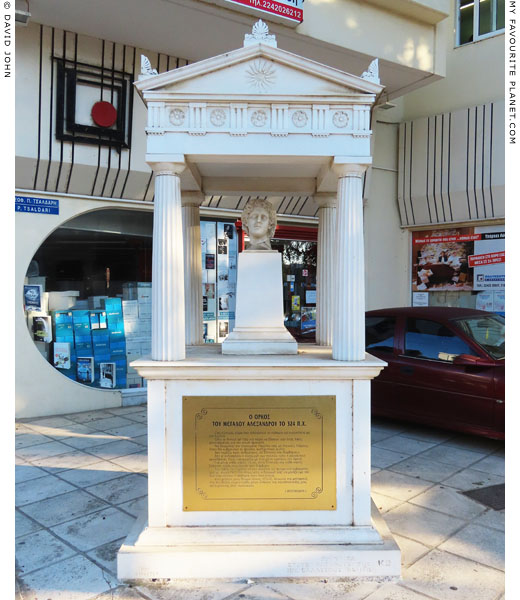 |
|
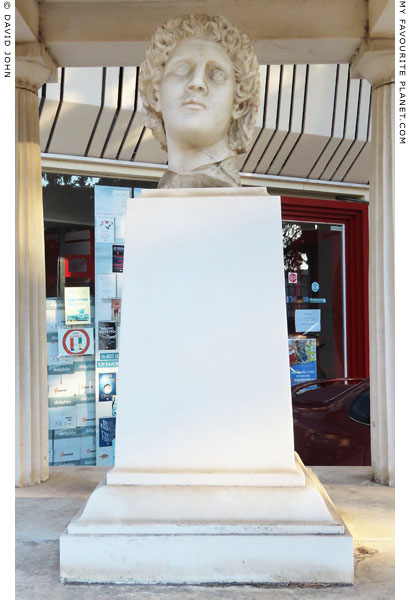 |
The "Alexander Altar", a modern marble monument to Alexander the Great,
on Panagi Tsaldari Street, at the corner of 31st Martiou Street, in the centre
of Kos town, Dodecanese, Greece. Dated 1 April 1995. |
|
| |
A square marble-clad base supports a Classical-style naiskos (small temple) consisting of four Doric columns, architrave, entablature with triglyphs and metopes (with rosettes in relief), pediments, roof and akroteria. A relief of the Macedonian star-burst symbol decorates the centre of both pediments. This construction shelters a marble head of Alexander on a tall, tapering pedestal. The sculpture is an original modern work, which appears to be modelled on the Hellenistic head in Pella Archaeological Museum (see top of page).
On each of the four sides of the base is a golden aluminium plaque inscribed with extracts of "The pledge of Alexander the Great in 324 BC" (the so-called "Oath of Alexander", see above and note 29) in modern Greek, English, French and German. The names of the monument's makers are inscribed at the bottom of the front of its base:
ΕΡΓΟ
ΦΥΛΑΚΤΟΥ
ΠΡΟΣΦΟΡΑ
ΣΤΟΥΣ ΚΑΤΟΙΚΟΥΣ ΤΗΣ
ΝΙΚ. ΘΑΛΑΣΣΙΝΟΣ 1.4.1995
ΚΩ
There is no indication of what prompted the makers, or whoever commissioned them, to set this up here at that particular time. Its location is not one passed by many locals or tourists. It happens to be outside a frontisterio, one of Greece's many small private schools, providing extra tuition to children in subjects such as maths and languages. This may have been the only space available with a wide enough pavement (sidewalk) to place such a construction; most streets and pavements in Kos are very narrow, with the latter usually blocked by parked vehicles, trees and various types of street furniture. Still, it seems odd that it stands here and not on Leoforos Megalou Alexandrou (Alexander the Great Avenue), the next parallel street to the west of Panagi Tsaldari Street. Between the two streets lie the overgrown remains of the enormous ancient stadium. |
|
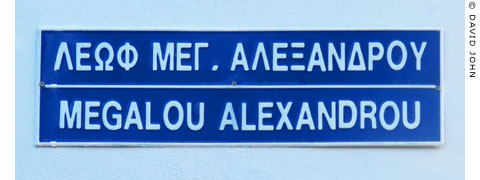
Alexander the Great Avenue (Λεωφόρος Μεγάλου Αλεξάνδρου,
Leoforos Megalou Alexandrou), Kos. |
|
| |
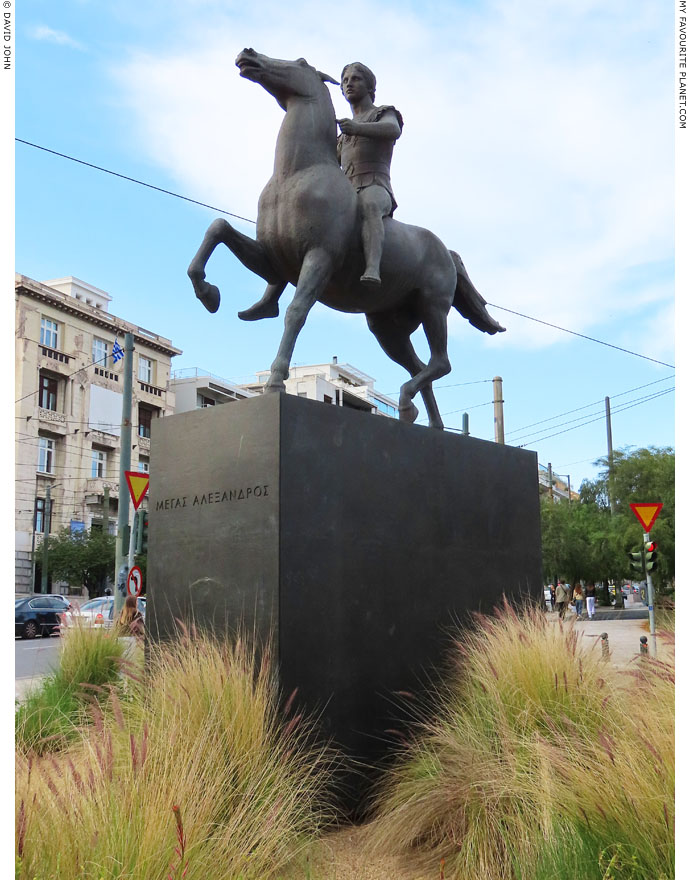
Alexander in Athens.
"Μέγας Ἀλέξανδρος" (Megas Alexandros, literally Great Alexander), a modern
bronze equestrian statue of Alexander the Great riding Bucephalos in Athens
city centre, made by Greek sculptor Yiannis Pappas in 1972.
|
Athens now has its first modern monument to Alexander the Great. The 3.5 metre bronze statue of Alexander as a teenager, riding an agitated Bucephalos, was made in 1972 by the sculptor Yiannis Pappas, and donated by the Greek Ministry of Culture to the Municipality of Athens in 1992. However, due to bureaucratic or political issues (nothing to do with the Skopje controversy, claim officials), it remained in the yard of the artist's studio for over two decades. It was finally set up opposite a statue of Lord Byron, on a traffic island at the corner of Amalias and Vasilissis Olgas avenues, outside the National Gardens, central Athens, and unveiled on Friday 19th April 2019.
The placement of the statue at this location could be described as "strategic" in political, cultural and financial terms. Vasilissis Olgas Avenue runs westwards towards the city centre from the Panathenaic Stadium (see Herodes Atticus), between the Olympieion (the Temple of Olympian Zeus), to the south, and the National Gardens to the north. Many statues and busts of famous Greeks and philhellene foreigners, including Lord Byron, have been set up during the last two centuries in and around the gardens, the largest public park in the city centre. Amalias Avenue runs southwards from the Greek parliament building (Vouli) on the city's central Syntagma Square, between the National Gardens to its east and the Plaka (one of the city's tourist traps) to the west, towards the Acropolis, and eventually in the direction of the port of Piraeus. This was also the route to the old Athens airport before the new one was built on the other side of the Attica peninsula.
All this means that most visitors to the city, including tourists, business people and officials from other countries, will pass this place on their way in or out of town, or on their way to or from one of the main sightseeing and shopping attractions, as well as principal offices of government and business.
Yiannis Pappas' statue has been placed on a tall, plain black pedestal, to ensure it is visible to pedestrians, motorists and passengers in the countless bikes, cars, taxis, trams and buses which pass by this busy traffic intersection day and night. Here you are also slap-bang between two important metro stations, Syntagma and Acropolis, from which thousands of people emerge every day. So, you really can't miss it.
With a population of well over four million, Athens is by far the largest city in Greece, and has been the nation's capital since shortly after it won independence from the Ottoman Empire in the 19th century. As such, it continues to claim to be the centre of Greece, politically, financially and culturally. Here also are concentrated more remains and artefacts from the country's historical past than anywhere else, and successive governments have commited to protect its heritage. As has been discussed elsewhere on this page, in recent years Alexander has become the single most recognizable and attractive figure from Greece's history, and thanks to books, films, television documentaries and websites, fascinates people all over the world as much as ever. He has become in himself symbolic of Greece (remind me not to use the cliché "poster boy"), which trades very much on its legacy, and his propaganda value remains very high. And this why, when the politicans and bureaucrats finally got around to displaying this statue, they decided to plonk it right here.
Alexander rides Bucephalos towards Piraeus in the southwest, perhaps only because he thus faces traffic coming into the city. At the front of the pedestal the inscription "Μέγας Ἀλέξανδρος" appears to be chiselled neatly in large capital letters. Nothing more, nothing less. I looked around the statue and pedestal, but could not find any other inscriptions, and nothing to indicate who sculpted it, which foundry cast it, or even when or by whom it was set up here. This seems a bit churlish of the authorities responsible, and reduces it to a mere generic civic monument or just another piece of street furniture.
However, if one must have such statues, one may be allowed to find this sculpture admirable and pleasing to the eye, charming even. Whether it may be considered as "Great Art", perhaps the future and its aesthetes will judge. As far as I know, it has not yet become a tourist attraction in itself, and I have not even seen many other people even photographing it as they pass by on their way to the next ruin or restaurant.
The young Macedonian prince rides his favourite steed bareback and bare-headed. He wears a cuirass (breastplate), decorated with a Gorgoneion, over a short chiton, light sandals, and has a diadem (or fillet; headband) around his head. Perhaps a little underdressed, but it does get very hot here in summer. As a portrait of Alexander the figure is convincing, given that it replicates the features known from some of the ancient sculptures, particularly the statue by Menas in Istanbul (see above).
Viewing the statue from its left side, he seems quite relaxed, just a young man going for a ride in the fields around his home. But if you go around to the right of the sulpture you can see that his right arm is raised, his fist closed (but not tightly clenched), and was probably meant to show him holding a sword or spear. Also, although judging from its rear legs Bucephalos is walking forwards, the position of its left foreleg suggests it has suddenly stopped and the right foreleg is raised dramatically. Its head is also raised high, indicating that Alexander may have pulled hard on the reins. Whether or not the statue was originally intended to include reins and a sword or spear, these are now noticably absent, perhaps to simplify it for display in a public place (statues in Athens are often climbed on or vandalized, particularly during political demonstrations), or maybe in order to soften the sculpture and make it less bellicose.
Looking a bit closer, the surface of the bronze is not smooth or highly polished, but quite rough in places (for example the fingers of the left hand), and certain parts looks as if they have been repaired of altered.
At present (2024) the sculpture is surrounded by a plants resembling isolated tufts of long grass set in a sandy or gravelly soil. This is an attractive but unusal planting arrangement, particularly for central Athens. Is it meant to suggest the wildernesses and deserts of Africa and Asia through which Alexander's campaigns would take him? Or is there some other botanical reasoning behind the design, totally unrelated to ancient history or biography? There certainly appears to have been a deliberate intention in the planting. For one thing, it is not lawn grass, nor has the traffic island been paved or cemented in. It may be a subtle way of keeping people at a distance from the statue and deterring them from clambering over or sitting around it - as happens to many public monuments. This is not a place you would want to hang around anyway.
Incidentally, Alexandrine parakeets, the green parrots said to have been sent to Europe from India by Alexander the Great (see Pergamon Gallery 2, page 12), have somehow found their way to Athens, and can be seen and heard flitting around the National Gardens. Many years ago, I first saw these exotic birds in the grounds of the Topkapi Palace in Istanbul. They have also colonized the wooded park near the Alexander the Great statue in Thessaloniki, and more recently several have emigrated to a number of cities in Germany. |
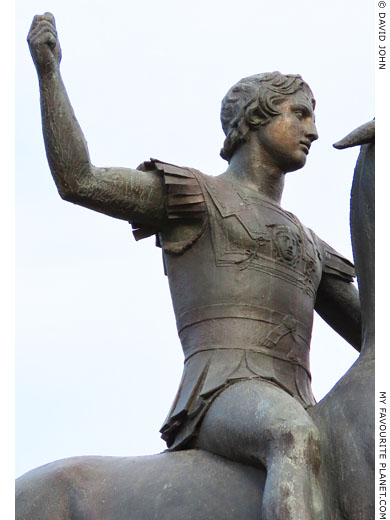
Detail of the right side of the Alexander statue in
Athens city centre. The teenage Macedonian prince
is depicted riding Bucephalos bareback. His right
arm is raised, as if he is holding a sword or spear.
He wears a diadem (or fillet; headband) on his
head, and a short chiton (tunic) under a cuirass
(breastplate) decorated with a Gorgoneion
(the head of the Gorgon Medusa). |
| |
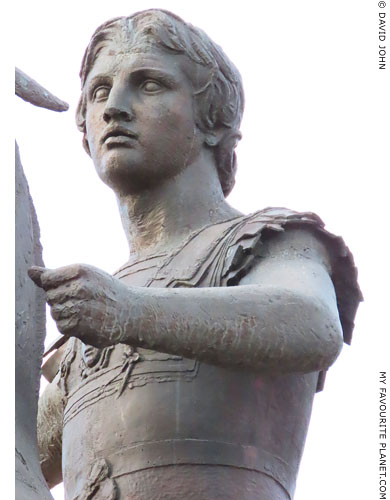
Detail of the left side of the Alexander the Great
statue in central Athens. |
| |
| |
Alexander
the Great |
Notes, references and links |
 |
|
1. Marble head of Alexander the Great in Pella
A chance find from Giannitsa, near Pella, Macedonia, Greece.
Around 300-270 BC, early Hellenistic period. Height 30 cm.
Pella Archaeological Museum. Inv. No. ΓΛ 15.
The identification of the head as Alexander has been challenged, and it has been suggested that it may represent a river god. Arguments for or against such claims are difficult if not impossible to prove conclusively. As can be seen from the illustrations on this page, ancient artworks considered to depict Alexander are not uniform and vary considerably. Many sculpted heads representing other known and unknown figures are similar to and were obviously influenced by portraits of Alexander. See, for example, the colossal "Medusa" head in Veria above.
2. Plutarch on Alexander's anastole
Alexander's anastole was described by Plutarch in his biography of the Roman statesman and general Pompey.
"His (Pompey's) hair was inclined to lift itself slightly from his forehead, and this, with a graceful contour of face about the eyes, produced a resemblance, more talked about than actually apparent, to the portrait statues of King Alexander. Wherefore, since many also applied the name to him in his earlier years, Pompey did not decline it, so that presently some called him Alexander in derision."
Plutarch, The Life of Pompey, chapter 2, sections 1-2. In: The Parallel Lives by Plutarch, Volume 5. Loeb Classical Library edition, in Greek with an English translation by Bernadotte Perrin. Harvard University Press, Cambridge, Mass., and William Heinemann, London, 1917. At Bill Thayer's website LacusCurtius.
3. The head of Philip II in the Vatican
It has also been suggested that the head may be a portrait of Alkibiades, the handsome, wealthy Athenian politican and general, notorious for his role in the Peloponnesian War, 5th century BC.
The sculpture formed part of the temporary exhibition about the Battle of Chaeronia: Chaeronia, 2 August 338 BC: A day that changed the world. Museum of Cycladic Art, 14 December 2023 - 23 April 2024.
4. Beardless Herakles on coins from Kamarina
The name of the issuing city is inscribed KAMAPINAION, next to the head of Herakles. Reverse sides of these finely made coins show Athena, driving a quadriga, being crowned by a flying Nike, and the signature of the die-cutter Exakestidas (Εξακεστίδας). The signature on coins signed by Exakestidas appears either as ΕΞΑΚΕΣΤΙΔΑΣ or abbreviated ΕΞΑΚΕΣ.
Many sources describe the obverse (front or recto, right) side of these and other types of Sicilian coins as the reverse (back or verso, avers, left), and vice versa. See further discussion of this matter on the Nike page.
Further reading on beardless Herakles on Sicilian coins:
Dimitrios Kousoulas, Unbearded Hercules on the coins of the Sicilian cities in the late 5th c. BC: some thoughts on the origins of the iconographical type and its spreading in the sculpture. In: Maria Caccamo Caltabiano (editor), Proceedings of the XV. International Numismatic Congress, Taormina 2015, Volume I, pages 374-377. Roma - Messina, 2017. At academia.edu.
In this short article Kousoulas examines the apparently sudden appearance of beardless Herakles on coins from Kamarina and Selinous in Sicily and their possible connections to contemporary Greek statues attributed to the Myronian school and Skopas of Paros.
5. Macedonian mints and Alexander's coinage
For further discussion, see, for example:
Hyla A. Troxell, Studies in the Macedonian Coinage of Alexander the Great (Digital Edition). Numismatic Studies, Issue 21. American Numismatic Society, New York, 1997. Digital Edition, 31 August 2016, at numismatics.org/digitallibrary.
"The rather amorphous, non-specific nature of this book's title is unfortunately unavoidable. The work deals with what are essentially five coinages, in two metals [gold and silver], struck over several different periods of time and very possibly at two or more different mints – whose locations we do not know." Introduction, page xv.
A valuable, comprehensive study of the subject. Although it contains many plates with photos of coins, most of those in the digital edition are too small to make out details such as die-marks.
6. Aesillas coins
See, for example:
Margaret Thompson, Byzantium over Aesillas. In: Revue numismatique, 6e série - Tome 15, année 1973, pages 54-65. At Persée.
Robert A. Bauslaugh, Silver coinage with the types of Aesillas the Quaestor. Numismatic Studies No. 22. American Numismatic Society, New York, 2000. At the Hathi Trust.
7. The gold medallions from Tarsus and Aboukir
See: Heinrich Dressel, Fünf Goldmedaillons aus dem Funde von Abukir. 86 pages and 4 plates. Based on lectures given by Dressel in Berlin on 28 April 1904 and 5 April 1906. Abhandlungen der Königlich Preußischen Akademie der Wissenschaften. Georg Reimer, Berlin, 1906. At academia.edu.
The invoice numbers of the 20 Aboukir medallions, followed by the letter asigned by Dressel in brackets:
3 medallions in the Walters Art Museum, Baltimore.
59.1 (L); 59.2 (R); 59.3 (T).
5 medallions in the Bode Museum, Berlin.
1903/837 (A); 1905/1 (B); 1907/230 (C); 1907/229 (D); 1908/3 (E).
11 medallions in the Calouste Gulbenkian Museum, Lisbon.
2425 (I); 2426 (G); 2427 (U); 2428 (F); 2429 (H); 2430 (K); 2431 (M);
2432 (N); 2433 (S); 2434 (O); 2435 (P).
1 medallion in the Thessaloniki Archaeological Museum. ΜΘ 4304 (Q).
According to Dressel's 1906 publication, this medallion had been in the possession of a certain "Herr Nahman in Cairo", who in early 1902 sold it to a dealer in Paris. It was later one of four medallions purchased by Henry B. Walters of Baltimore. However, since it was considered a near duplicate of the other Olympias medallion, Inv. No. 59.2 (R), it was not bequeathed to the Walters Art Museum with the other three in 1931, but passed to Mrs Walters, and eventually to the auction in Basel in 1962.
The three "Alexander medallions" from Tarsus now in the Cabinet des Médailles, Paris, are conventionally referred to as Tarsos I, II and III:
I = Inv. No. 1671; II = Inv. No. 1672; III = Inv. No. 1673.
The first publication of the Tarsus medallions appears to have been the 1868 article by Henry Adrien Prévost de Longpérier (1816-1882), director of la Revue Numismatique and curator of antiquities at the Louvre Museum, who had begun his career in the Cabinet des Médailles.
Adrien Prévost de Longpérier, Trésor de Tarse. In: la Revue Numismatique, nouvelle série, Tome 13, pages 309-336 and plates X-XIII. La Société Française de Numismatique. Chez MM. Camille, Rollin et Feuardent, Paris, 1868. The article available as a PDF of an extract (offprint) at Googlebooks.
The entire volume available as a PDF: la Revue Numismatique, nouvelle série, Tome 13. At the website of the Sorbonne library.
Following the discovery of the Aboukir hoard, the London-born coin collector Captain Robert Knight Mowat (1823-1912) reappraised the Tarsus medallions. At the time he was one of the few numismatists to defend the authenticity of the Aboukir medallions.
Robert Mowat, Les médaillons grecs du Trésor de Tarse et les monnaies de bronze de la communauté macédonienne. In: Revue numismatique, quatrième série, Tome 7, pages 1-30 and plates I-IV. La Société Française de Numismatique. C. Rollin et Feuardent, Paris, 1903.
Since then the medallions have been discussed in several publications, including:
E. T. Newell, The gold medallions of Abukir. In: American Journal of Numismatics, Volume 44, No. 3, July, 1910, pages 128-130 and 2 plates. American Numismatic Society. At jstor.
Eight years after the discovery of the Aboukir medallions, Newell summarized the international academic controversy concerning the authenticity and "acceptance of these truly remarkable medallions as genuine antique works of art".
Cornelius Vermeule, Alexander the Great, the Emperor Severus Alexander and the Aboukir medallions. Schweizerische numismatische Rundschau (= Revue suisse de numismatique = Rivista svizzera di numismatica), Band 61, pages 61-72 plus 7 plates. Bern, 1982.
Michel Amandry, Vitrine 7, À. Le trésor de Tarse. In: Anatolie antique: Fouilles françaises en Turquie, pages 105-108. Catalogue of the exhibition Gypsothèque de l'Université Lumière Lyon II, 23 October - 23 December 1990. Institut Français d'Études Anatoliennes-Georges Dumézil, Istanbul, 1990. At Persée.
A short text with photos of 14 coins and medallions from the Tarsus hoard.
Karsten Dahmen, Alexander in gold and silver: Reassessing third century AD medallions from Aboukir and Tarsos. In: American Journal of Numismatics, Volume 20, pages 493-546 and plates 100-110. American Numismatic Society, 2008. At academia.edu.
An extensive and detailed survey of research and speculation, published over a century after their discovery of the medallions.
Bernhard Weisser and Karsten Dahmen, Goldener Alexander zum Geschenk (Golden Alexanders as gifts). In: Stella Drougou et al (editors), Κερμάτια Φιλίας : τιμητικός τόμος για τον Ιωάννη Τουράτσογλου (Coins of Friendship: Honour volume for Ioannis Touratsoglou), pages 343-359. Hellenic Ministry of Culture / Numismatic Museum, Athens, 2009.
(Ioannis Touratsoglou (Ιωάννης Τουράτσογλου, 1940-2021) was a Greek archaeologist and director of the Numismatic Museum, Athens. He also served periodically as director of the Epigraphic Museum and the National Archaeological Museum in Athens.)
Karsten Dahmen, Medallions from Aboukir in the Calouste Gulbenkian Museum. No. 2 in the series of limited edition booklets Museum Treasures. 46 pages, illustrated, with bibliography. Both sides of all 20 Aboukir medallions are described and illustrated with colour photos. The photo of Olympias on the obverse of the Thessaloniki medallion has been erroniously reversed. Calouste Gulbenkian Foundation, Lisbon, 2013. PDF at the website of the Calouste Gulbenkian Museum.
Karsten Dahmen, King in a small world: Depictions of Alexander the Great on his shields and armour. In: D. Boteva (editor), Ex nummis lux: Studies in ancient numismatics in honour of Dimitar Draganov, Pages 413-420. 2017. At academia.edu.
8. The "Schwarzenberg Alexander"
See: Erkinger von Schwarzenberg, Der lysippische Alexander. In: Bonner Jahrbücher (BJb), Band 167 (1967), pages 59-118. Verlag Butzon & Bercker-Kevelaer und Bühlau Verlag, Köln - Graz, 1967. Free PDF available at Heidelberg University Digital Library.
See also:
Olga Palagia, The case of the Schwarzenberg Alexander. Benaki Museum, Athens, 2020. At academia.edu.
Plutarch on Lysippos:
Moralia, 335A-B
"Apelles the painter and Lysippus the sculptor also lived in the time of Alexander. The former painted 'Alexander wielding the Thunderbolt' so vividly and with so natural an expression, that men said that, of the two Alexanders, Alexander, son of Philip, was invincible, but the Alexander of Apelles was inimitable.
And when Lysippus modelled his first statue of Alexander which represented him looking up with his face turned towards the heavens (as indeed Alexander often did look, with a slight inclination of his head to one side), someone engraved these verses on the statue, not without some plausibility.
Eager to speak seems the statue of bronze, up to Zeus as it gazes:
'Earth I have set under foot: Zeus, keep Olympus yourself!'
Wherefore Alexander gave orders that Lysippus only should make statues of him. For Lysippus was, it seemed, the only one that revealed in the bronze Alexander's character and in moulding his form portrayed also his virtues. The others wished to imitate the flexing of his neck and the melting and liquid softness of his eyes, but were unable to preserve his virile and leonine expression."
(Cf. Pliny, Natural History, vii. 37 (125) ; Horace, Epistles, ii. 1. 240 ; Valerius Maximus, viii. 11. 2 : Arrian, Anabasis, i. 16. 4.)
Moralia, 335F
"What of Apelles' 'Wielder of the Thunderbolt'? What of the statue which takes its name from the Spear? Shall we admit, then, that greatness in a statue cannot, without the help of Art, be created by Fortune's profuse provision of gold and bronze and ivory and much rich material, but is it possible that a great man, or rather the greatest man of all that have ever lived, without the help of Virtue, was perfected through Fortune's supplying him with arms and money, foot and horse?"
Plutarch, On the fortune or virtue of Alexander, Oration II. In: Plutarch's Moralia, Volume 4 (of 15), 263D - 351B, pages 432-435, 335A-B and pages 434-435, 335F. Loeb Classical Library edition, in Greek, with an English translation by Frank Cole Babbitt. Harvard University Press, Cambridge, Mass., and William Heinemann, London, 1962.
Moralia, 360D
"Moreover, Lysippus the sculptor was quite right in his disapproval of the painter Apelles, because Apelles in his portrait of Alexander had represented him with a thunderbolt in his hand, whereas he himself had represented Alexander holding a spear, the glory of which no length of years could ever dim, since it was truthful and was his by right."
Plutarch, Isis and Osiris. In: Plutarch's Moralia, Volume 5 (of 15), 351C - 438E, pages 58-59, 360D. Loeb Classical Library edition, in Greek, with an English translation by Frank Cole Babbitt. Harvard University Press, Cambridge, Mass., and William Heinemann, London, 1936. |
|
|
9. Head of Alexander the Great from Kyme
This head has been associated with other sculptured heads found by Baltazzi at the same findspot at Kyme, referred to as the "Kyme Alexander Group", now in the Istanbul Archaeological Museum (see photos, right): "Hephaistion", Inv. No. 387 (Cat. Mendel 599); a woman ("Artemis"), Inv. No. 386 (Cat. Mendel 598); and Emperor Augustus, Inv. No. 385 (Cat. Mendel 333).
The site of the ancient Aeolian city of Kyme (Κύμη) is at the modern Turkish coastal village of Nemrut Limani, in the Aliağa district north of Izmir, and 40 km south of Pergamon. It was one of the largest of the twelve cities of Aeolia (Αἰολία, Aiolia, or Αἰολίς, Aiolis), colonized by Aeolian Greeks from Thessaly and Boeotia around 1000 BC when they were driven from mainland Greece by invading Dorians (see History of Pergamon).
The site was first excavated in November 1887 by Demosthenes Baltazzi (1836-1896), who had a farm at Aliağa. He was described as "his Excellency Demosthenes Baltazzi-Bey, a learned archaeologist of Smyrna, and inspector of ancient monuments" *, and as "directeur du service archéologique du Vilayet d’Aïdin" (director of the archaeological service of the Aydin province) **. He and his brother Epaminondas (1828-1887), members of a wealthy Greek family based in Smyrna (Izmir), were both involved in early archaeological investigations in the Ottoman Empire. He also excavated at Magnesia on the Meander, Aegae, Hypaipa, Pergamon and Myrina (where another of his brothers, Aristides Baltazzi, owned the land of the necropolis site). With his friend Osman Hamdi Bey (1842-1910, founder and first director of the Istanbul Archaeological Museums), he co-directed excavations in 1887 at Sidon (Saida), where the "Alexander Sarcophagus" was discovered. He was assistant director of the Imperial Museum in Aydin Province until 1892, after which he worked as a researcher at the Istanbul museum.
See:
* The recent excavations at Saida (translated from Les récentes fouilles de Saida, an article in Le Bachir, a journal in French and Arabic, published in Beirut, 8 June 1887), in Palestine Exploration Fund, Quarterly statement for 1887 (Volume 19), Issue 4, page 201. London, 1887. At the Internet Archive.
** Osman Hamdi Bey, Theodor Reinach, Une nécropole royale à Sidon: Fouilles de Hamdy Bey, Texte, Introduction, page III. Ernest Leroux, Paris, 1892. At Heidelberg University Digital Library.
G. Kökdemir, 120. Ölüm Yıldönümünde Aydın Vilayeti Müze-i Hümayun Müdür Vekili Démosthènes Baltazzi ve Menderes Magnesiası’ndaki Çalışmaları (1887, 1890) (On the 120th anniversary of the death of Demosthenes Baltazzi, assistant manager of Asar-i Attika in the vilayet of Aydın and his excavations in Magnesia on the Meander (1887, 1890)). Türkiye Bilimler Akademisi Arkeoloji Dergisi (Turkish Academy of Sciences Journal of Archaeology), Volume 19, pages 291-304. Ankara, 2016. In Turkish, at academia.edu.
10. Colossal head of Alexander the Great from Priverno
The head was found during the digging on 8 and 9 April 1831 of foundations for a sacristy on the northern side of the church of the Madonna di Mezzo Agosto, at Piperno Vecchio, the site of ancient city of Privernum, north of modern Priverno (then known as Piperno). The workers unearthed a semicircular wall in which a number of ancient sculptures and fragments had been used as building material. The discovery was reported by the canon De Bonis, who gave the "Alexander" head and a bust of a Roman emperor to the Capitoline Museums in 1839.
See:
Henry H. Armstrong, Privernum: II. The Roman City. In: American Journal of Archaeology, Vol. 15, No. 2 (April-June 1911), pages 170-194. Archaeological Institute of America, 1911. At Bill Thayer's LacusCurtius.
Henry Stuart Jones, A catalogue of the ancient sculptures preserved in the municipal collections of Rome: The sculptures of the Museo Capitolino, Stanza dei Filosofi No. 28, pages 230-231. Clarendon Press, Oxford, 1912. At the Internet Archive. Here it is stated that the head was discovered in 1832, and the church referred to as the Church of the Assunta. The date of the donation is inscribed on the base. |
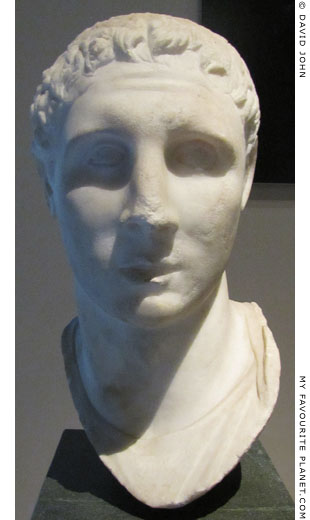
Marble head of a statue from Kyme,
perhaps a portrait of Hephaistion.
Late 3rd century BC. Height 42.5 cm.
Istanbul Archaeological Museum.
Inv. No. 387 T. Cat. Mendel 599. |
| |
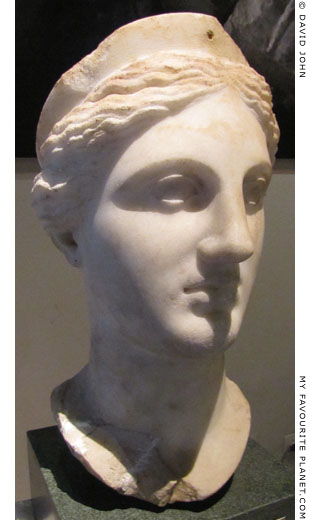
Marble head of a statue from Kyme,
thought to depict Artemis.
Late 3rd century BC. Height 39 cm.
Istanbul Archaeological Museum.
Inv. No. 386 T. Cat. Mendel 598. |
| |

Marble portrait head of a statue
of Emperor Augustus from Kyme.
1st century AD. Height 37 cm.
Istanbul Archaeological Museum.
Inv. No. 385 T. Cat. Mendel 333. |
| |
| |
11. Head of Alexander the Great as Helios
The larger-than-lifesize head, part of a huge sculpture thought to have been copied from a Hellenistic model, was formerly in the Vatican and was probably donated by Pope Pius V in 1566. Seven regularly-spaced holes around the head are thought to have been drilled for the attachment of a thin metal band from which radiated pointed spikes as solar rays, typical of depictions of the sun god Helios (known to the Romans as Sol).
Various dates have been proposed for the head, from the 4th century BC to the 2nd century AD. According to the prevailing theory, it was made in the 1st century AD, perhaps during the reign of Nero (54-68 AD), who is known to have placed a statue of himself as Helios in the vestibule of the Domus Aurea (Pliny the Elder, Natural History, Book 34, chapter 45).
See: Imagini del mito: Iconografia di Alessandro Magna in Italia (Images of a legend: Iconography of Alexander the Great in Italy), pages 174-175. Catalogue, in Italian and English, of the international travelling exhibition of photographs, organized by the Italian Directorate General for Cultural Promotion and Cooperation and the Ministry of Foreign Affairs. Gangemi Editori, Rome, 2006. |
|
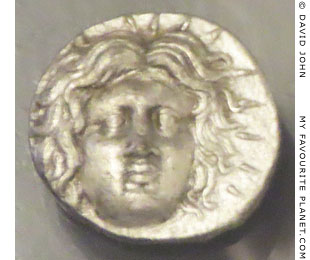
The head of Helios with a crown of
solar rays on a silver tetradrachm
coin of Rhodes. 230-210 BC.
Rhodes Archaeological Museum. |
|
| |
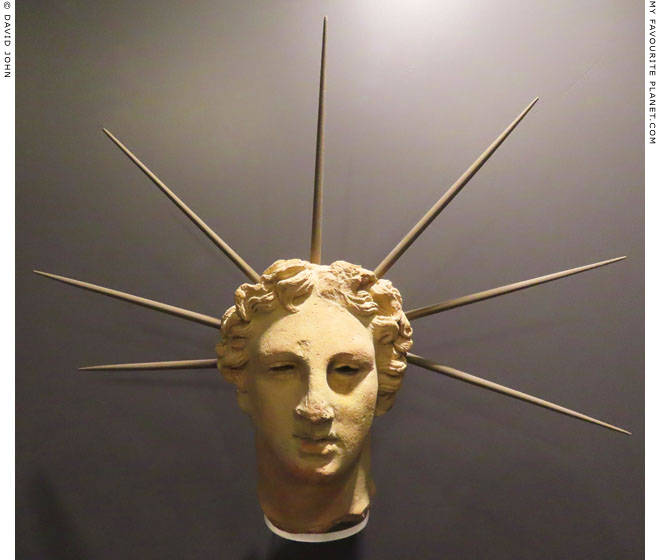
A terracotta head of Helios from Rhodes, with modern solar rays added. 150-100 BC.
Rhodes Archaeological Museum.
Currently (2022) part of the extended exhibition "Ancient Rhodes - 2400 years"
in the Palace of the Grand Master, Rhodes. |
| |
12. Head of Alexander the Great in the Barracco Museum, Rome
The theory that this head is a copy of the idealized Alexander by Euphranor of Corinth is based on a reference from Pliny the Elder (Natural history, Book 34, chapter 19) to statues of Alexander and Philip II in chariots, with which the "Alexander Rondanini" statue (see above) has also been associated. According to other theories it may be the head of Mithra Tauroctonos or one of the Dioskouroi with the features of Alexander.
See: Imagini del mito: Iconografia di Alessandro Magna in Italia, pages 138-139. Gangemi Editori, Rome, 2006.
13. Alexandreia festivals
Such Alexandreia (Ἀλεξάνδρεια) festivals were held at other places. The geographer Strabo wrote of a sacred grove or woods (ἄλσος) dedicated to Alexander at Chalcideis (Χαλκιδεῖς), near Teos (Τέως) in Ionia (Between Smyrna and Ephesus), where an Alexandreia festival with games was organized by the Ionian League, the member cities of which convened at Panionion (Πανιώνιον).
"Above the Chalcideis is situated a sacred precinct consecrated to Alexander the son of Philip; and games, called the Alexandreia, are proclaimed by the general assembly of the Ionians and are celebrated there."
Strabo, Geography, Book 14, chapter 1, section 31. Translated by Horace Leonard Jones. Loeb Classical Library. Harvard University Press, Cambridge, Massachusetts, and William Heinemann Ltd, London, 1924. At Perseus Digital Library.
Strabo's Chalcideis may have been the Chalcis (Χαλκίς) or Chalkidos (Χαλκίδος) mentioned by Pausanias as a district of Erythrai (Ἐρυθραί), another Ionian city to the northwest of Teos.
Pausanias, Description of Greece, Book 7, chapter 5, section 12. At Perseus Digital Library.
14. Ancient sculpture in the Allard Pierson Museum, Amsterdam
Many of the exhibits in the University of Amsterdam's museum were donated or have been acquired from private collections. Often their provenance and/or archaeological context is unknown. Some of the information about the sculptures there has been taken from the museum's illustrated catalogue:
H. A. G. Brijder (editor), Collections of the Allard Pierson Museum - Volume 1: Eric M. Moorman, Ancient sculpture in the Allard Pierson Museum, Amsterdam. Allard Pierson Museum, Amsterdam, 2000. PDF at the Radboud Repository, Radboud University, Nijmegen. (Unfortunately, not on sale in the museum.)
Although the catalogue only includes a small selection of the museum's extensive collection of ancient sculptures, it is a useful resource, particularly as many of the works are displayed grouped together, unlabelled, in glass display cases. Where there is labelling, many of the descriptions of objects (most in Dutch and English) have been printed on transparent film adhered onto the fronts of the glass cases. Many are thus very difficult to read. The exhibition is organized thematically (rather than chronologically, geographically or by culture), often with objects from various parts of the ancient world (Greece, Italy, Asia, Egypt) and from various periods displayed in the same case. Considering that the museum has recently been renovated and the exhibition reorganized, some unfortunate design decisions have been made. Otherwise an excellent museum with a wonderful atmosphere and many marvellous exhibits. |
|
|
|
15. Quintus Caecilius Metellus Macedonicus and the Alexander statue group
Following his victories in the Macedonian Wars, the long-lived Quintus Caecilius Metellus (circa 210 BC – 116/115 BC) added Macedonicus to the end of his name.
The Portico of Metellus (Porticus Metelli), in which the Granikos Monument statue group was placed, was built in 146 BC as an entrance to the colonnade surrounding the temples of Jupiter Stator and Juno Regina ("the two temples without inscriptions"), on the triumphal route at the southern side of the Field of Mars (Campus Martius), near the Circus of Flaminius.
It has been seen as significant that the Granikos Monument was removed from the Sanctuary of Zeus at Dion and placed at a sanctuary of Jupiter (Jove), Zeus' Roman equivalent.
The four-sided portico, 132 x 140 metres, was restored 27-23 BC by Emperor Augustus, who renamed it Porticus Octaviae (see drawing below) after his elder sister Octavia Minor (66-11 BC; wife of Mark Antony), and the statue group remained the main attraction among a number of works of art put on display there. The sculptures may have survived at this location until at least the 5th century AD, despite damage to the sanctuary by fire in 80 AD (when most of the buildings on the Campus Martius were destroyed) and 203 AD, after which it was rebuilt by Emperor Septimius Severus, and consequent restorations.
After the closing of pagan temples by Emperor Theodosius I at the end of the 4th century AD, the portico was again damaged by an earthquake in 442. The sanctuary became a fish market in which the church of Sant' Angelo in Pescheria was founded by Pope Stephen III in 755, built using columns and other material from the portico. The monumental entrance (propylaeum) of the portico was repaired, with a brick archway replacing two of its four Corinthian columns, and still acts as an entrance to the precinct of the church (see photo below).
A brief account of Metellus' victories and the removal of the statue group to Rome was written by Marcus Velleius Paterculus (circa 19 BC – circa 31 AD). Velleius also related the tradition that Alexander the Great commissioned the group from Lysippos, and wrote that Metellus was the first to build a temple of marble in Rome, inside the colonnade entered by the portico, "in the midst of these very monuments".
Velleius Paterculus, The Roman History, Book I, Chapter 11, sections 1-7. At Bill Thayer's excellent website LacusCurtius: Into the Roman World, University of Chicago.
Pliny the Elder (23-79 AD) also mentioned Metellus bringing the statues of the Granikos Monument to Rome (Natural History, Book 34, chapter 19), and listed several of the other works of art exhibited within the porticus, including those of Pheidias, Praxiteles, Kephisodotos, Timarchides, Dionysios, Polykles and Heliodoros (Book 36).
Pliny the Elder, The Natural History. Translated by John Bostock and H.T. Riley. Taylor and Francis, London, 1855. At Perseus Digital Library.
The marble temple built by Metellus is thought to have been the temple of Jupiter Stator (Aedes Jovis Statoris) in the Porticus Metelli, mentioned by Vitruvius, who named the architect as Hermodorus (thought to be Hermodorus of Salamis).
Vitruvius, The ten books on architecture, Book III, chapter 2, section 5. Translated by Morris Hicky Morgan and Albert A. Howard. Harvard University Press and Oxford University Press, 1914. At Perseus Digital Library. |
|
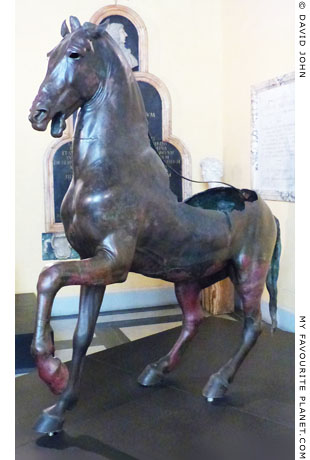
The bronze horse found in 1849 in Rome,
perhaps from Lysippos' Granikos Monument
statue group from Dion, Macedonia.
Height 195 cm.
Sale Castellani, Palazzo dei Conservatori,
Capitoline Museums, Rome. Inv. No. 1064.
The bronze horse known as "il Cavallo di Vicolo delle Palme" (the Horse from Vicolo delle Palme), found in 1849 during excavations on the Vicolo delle Palme (now Vicolo dell'Atleta), Trastevere, Rome, and now in the Capitoline Museums, is thought to be the only surviving element of the Granikos Monument statue group by Lysippos.
On the other hand, some scholars believe it may have been made in the 5th century BC by Hegias of Athens (active circa 490-460 BC), the teacher of Pheidias. The horse was returned to the Capitoline Museums in April 2007 following a $680,000 restoration which was begun in the 1970s. |
| |
| |

A reconstruction drawing of the Porticus Octaviae, Rome, showing the temples of Juno
Regina (left) and Jupiter Stator built in the 2nd century BC. The latter is thought to have
been designed by the Greek Cypriot architect Hermodoros of Salamis. The portico also
contained a Greek and a Latin library and the Curia in which the Senate sometimes met.
The inscription on the architrave of the central gateway (propylaeum):
OCTAVIAE SORORI OCTAVIANUS CAESAR AUGUSTUS (Octavia, sister of Octavian Caesar Augustus)
The fragmentary inscription which can now be seen on the architrave (see photo below)
is of a later date and mentions emperors Pertinax, Marcus Aurelius and Antoninus Pius.
Drawing made in 1827 by Felix Duban, a pensionnaire in the French Academy in Rome. |
| |
The temples of Jupiter Stator and Juno Regina were also referred to as "the two temples without inscriptions", and it is thought that it was not usual to place inscriptions on temples in Rome in the 2nd century BC. The lack of labels to identify the buildings and provide information about their history is thought to have later led to the stories, probably legends, related by Pliny the Elder, which attributed their design to two Spartan sculptors with the unlikely names Saurus (Σαύρα, Lizard) and Batrachus (Βάτραχος, Frog), who are otherwise unknown. The tale may have arisen from the reliefs of a lizard and a frog said to have been carved on the temple columns, imagined to be the artists' signatures. The statue of Jupiter was also said to have been accidently placed in the Temple of Juno and vice versa.
"Saurus, too, and Batrachus must not be forgotten, Lacedaemonians by birth, who built the temples enclosed by the Porticos of Octavia. Some are of opinion that these artists were very wealthy men, and that they erected these buildings at their own expense, expecting to be allowed to inscribe their names thereon; but that, this indulgence being refused them, they adopted another method of attaining their object. At all events, there are still to be seen, at the present day, on the spirals of the columns, the figures of a lizard and a frog, emblematical of their names.
In the Temple of Jupiter by the same artists, the paintings, as well as all the other ornaments, bear reference to the worship of a goddess. The fact is, that when the temple of Juno was completed, the porters, as it is said, who were entrusted with the carriage of the statues, made an exchange of them; and, on religious grounds, the mistake was left uncorrected, from an impression that it had been by the intervention of the divinities themselves, that this seat of worship had been thus shared between them. Hence it is that we see in the Temple of Juno, also, the ornaments which properly pertain to the worship of Jupiter."
Pliny the Elder, Natural history, Book 36, chapter 4. At Perseus Digital Library.
Earlier in the same chapter Pliny had mentioned that there were statues of the two deities in their respective - and correct - temples, made by Polykles and Dionysios, and that an ivory statue of Jupiter by Pasiteles stood in the "Temple of Metellus".
"In the Temple of Juno, within the Porticos of Octavia, there is a figure of that goddess, executed by Dionysius, and another by Polycles, as also other statues by Praxiteles. This Polycles, too, in conjunction with Dionysius, the son of Timarchides, made the statue of Jupiter, which is to be seen in the adjoining temple."
"Pasiteles constructed the ivory statue of Jupiter which is now in the Temple of Metellus, on the road to the Campus Martius." |
|
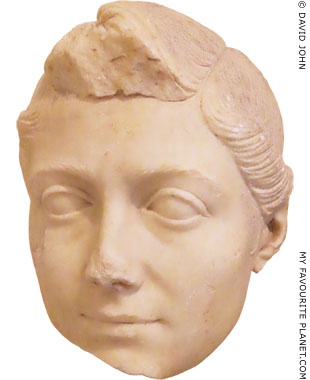
A marble portrait head, probably depicting
Octavia (66-11 BC), elder sister of Emperor
Augustus, wife of Mark Antony.
Around 30 BC. From Smyrna. Parian marble.
National Archaeological Museum,
Athens. Inv. No. 547. |
|
| |
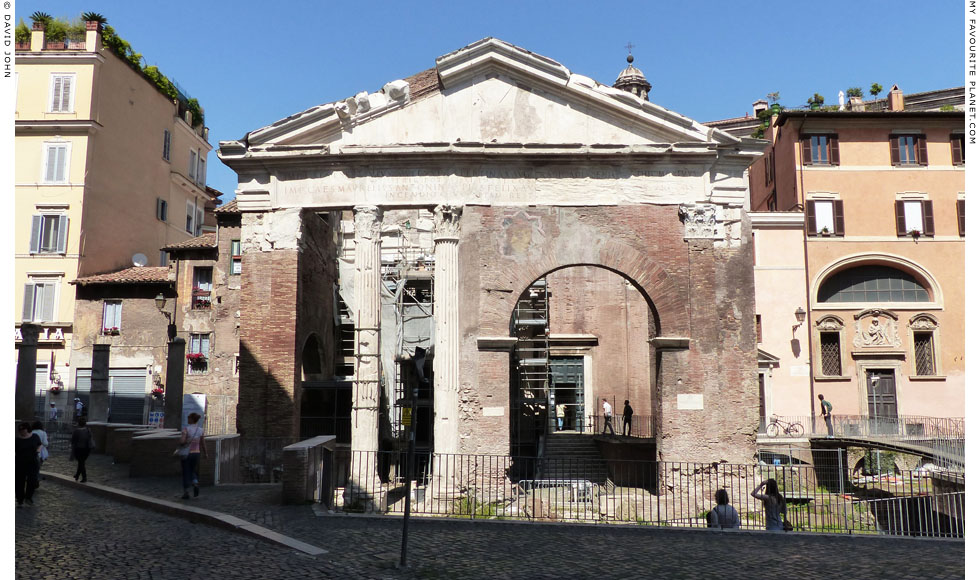
The remains of the monumental entrance (propylaeum) on the south side of the Portico of Octavia
in front of the church of Sant' Angelo in Pescheria, on the Via del Portico d'Ottavia.
|
One of the eagles carrying thunderbolts in their talons - symbols of Jupiter - which decorated the Corinthian capitals of the entrance can still be seen on the second column from the left.
The remains of the portico stand over 2 metres below the present street level, and much of it lies beneath the church and surrounding houses. On the right of the photo, a footbridge leads to the church, and a ramp and steps lead down to the ruins of the portico, the enormous Theatre of Marcellus and the temples of Apollo Sosianus and Bellona, in the area where the Circus of Flaminius once stood.
The archaeological area, which can also be entered from the east from Via del Teatro di Marcello, is open 9 am - 7 pm, winter 9 am - 6 pm. Entrance is free. |
|
|
16. Ptolemy I takes Alexander's body to Egypt
Pausanias included the story in his account of the dynasties of the Ptolemies and Attalids (of Pergamon):
"He [Ptolemy] crossed over to Egypt in person, and killed Cleomenes, whom Alexander had appointed satrap of that country, considering him a friend of Perdiccas, and therefore not faithful to himself; and the Macedonians who had been entrusted with the task of carrying the corpse of Alexander to Aegae, he persuaded to hand it over to him. And he proceeded to bury it with Macedonian rites in Memphis, but, knowing that Perdiccas would make war, he kept Egypt garrisoned."
Pausanias, Description of Greece, Book 1, chapter 6, section 3. At Perseus Digital Library.
"Aegae" (Aigai, today Vergina) was the ancient capital of Macedonia, before it was moved to Pella around the end of the 5th century BC.
The story was also related in a lost work known as Events after Alexander (Τὰ μετ᾽ Ἀλέξανδρον) by Arrian of Nikomedeia, which was summarized by Photios (Φώτιος Α΄, Photios I, circa 810-893 AD), Patriarch of Constantinople, in his Bibliotheka (Βιβλιοθήκη).
"Arrhidaeus, who kept the body of Alexander with him, contrary to the wish of Perdiccas, took it from Babylon by way of Damascus to Ptolemy the son of Lagus in Egypt; and though often hindered on his journey by Polemon, a friend of Perdiccas, nevertheless succeeded in carrying out his intention."
Photius, Bibliotheca, Codices 1-165: 92. Arrian, Continuation. Translated by J. H. Freese, edited by Roger Pearse. At tertullian.org.
The Roman writer Aelian (Κλαύδιος Αἰλιανός, Claudius Aelianus; circa 175-235 AD) also related a version of the story:
"Alexander, Son of Philip and Olympia, ending his daies at Babylon, lay there dead, who had said that he was the Son of Jupiter. And whilest they who were about him contested for the Kingdome, he remained without Burial, which the poorest persons enjoy, common Nature requiring that the dead should be interred; but he was left thirty daies unburied, until Aristander the Telmissian, either through Divine instinct, or some other motive, came into the midst of the Macedonians, and said to them, 'That Alexander was the most fortunate King of all Ages, both living and dead ; and that the Gods had told him, that the Land which should receive the Body in which his Soul first dwelt, should be absolutely happy and unvanquishable for ever.'
Hearing this, there arose a great emulation amongst them, every one desiring to send this Carriage to his own Countrey, that he might have this Rarity the Pledge of a firm undeclinable Kingdome. But Ptolemee, if we may credit Report, stole away the Body, and with all speed conveyed it to the City of Alexander in Aegypt.
The rest of the Macedonians were quiet, onely Perdiccas pursued him; not so much moved by love of Alexander, or pious care of the dead Body, as enflamed by the predictions of Aristander. As soon as he overtook Ptolemee there was a very sharp Fight about the dead Body, in a manner akin to that which happened concerning the Image [of Hellen] in Troy, celebrated by Homer, * who saith that Apollo in defence of Aeneas engaged amidst the Heroes; for Ptolemee having made an Image like to Alexander clothed it with the Royal Robe, and with noble Funeral Ornaments, then placing it in one of the Persian Chariots, adorned the Bier magnificently with Silver, Gold, and Ivory; but the true Body of Alexander he sent meanly ordered by obscure and private waies.
Perdiccas seizing the Image of the dead man, and the richly-adorned Chariot, gave over the pursuit, thinking he had gained the prize. But too late he found that he was couzened, for he had not got that at which he aimed."
* Homer, Iliad, Book 5, line 449. Not an image of Helen, but an image of Aeneas.
Claudius Aelianus, His Various History, Book 12, Chapter LXIV: Of Alexander dead. Translated by Thomas Stanley. Thomas Dring, London, 1665. At James Eason's website, University of Chicago.
In his description of Alexandria, Strabo told the tale of how Alexander's tomb came to be in the city:
"The Museum is a part of the palaces. It has a public walk and a place furnished with seats, and a large hall, in which the men of learning, who belong to the Museum, take their common meal. This community possesses also property in common; and a priest, formerly appointed by the kings, but at present by Caesar, presides over the Museum.
A part belonging to the palaces consists of that called Sema [Σῆμα, Tomb], an enclosure, which contained the tombs of the kings and that of Alexander (the Great). For Ptolemy the son of Lagus took away the body of Alexander from Perdiccas, as he was conveying it down from Babylon; for Perdiccas had turned out of his road towards Egypt, incited by ambition and a desire of making himself master of the country. When Ptolemy had attacked [and made him prisoner], he intended to [spare his life and] confine him in a desert island, but he met with a miserable end at the hand of his own soldiers, who rushed upon and despatched him by transfixing him with the long Macedonian spears.
The kings who were with him, Aridaeus, and the children of Alexander, and Roxana his wife, departed to Macedonia. Ptolemy carried away the body of Alexander, and deposited it at Alexandreia in the place where it now lies; not indeed in the same coffin, for the present one is of hyalus (alabaster ?) whereas Ptolemy had deposited it in one of gold: it was plundered by Ptolemy surnamed Cocce's son and Pareisactus, who came from Syria and was quickly deposed, so that his plunder was of no service to him."
Strabo, Geography, Book 17, chapter 1, section 8. Translated by H. C. Hamilton and W. Falconer. George Bell & Sons, London, 1903. At Perseus Digital Library.
Diodorus Siculus (Διόδωρος Σικελιώτης, 1st century BC) described the elaborate prepations for Alexander's funeral pageant, which took almost two years, the magnificent funeral chariot and the transfer of his body from Babylon to Alexandria. See:
Diodorus Siculus, The Library of History, Book 18 chapters 26-28. At Bill Thayer's LacusCurtius.
17. Statues of Olympias and Eurydice in the Philippeion
For further discussion, see, for example:
Olga Palagia, Philip’s Eurydice in the Philippeum at Olympia. In: Elizabeth Carney and Daniel Ogden (editors), Philip II and Alexander the Great: Father and son, lives and afterlives,
chapter 4, pages 33-41. A selection from papers presented at the international symposium, Philip II and Alexander III: Father, Son and Dunasteia, April 3-5, 2008, at Clemson University, South Carolina. Oxford University Press, 2010. Includes bibliographical references and index.
Katherine Denkers, The Philippeion at Olympia: The true image of Philip?. MA thesis, McMaster University, 2012.
18. Dedications to mortals at Olympia
The Nymphaeum of Herodes Atticus, on which the wealthy Arhenian placed statues of himself, his wife and their families, as well as Roman emperors and their familes, may also thought of as a kind of heroon, despite the inscription dedicating the fountain to Zeus and the fact that the emperors were themselves deified.
19. Macedonian kings and the Olympic Games
Herodotus wrote that Alexander I of Macedonia (ruled circa 498-454 BC), not only successfully competed in a foot race in the Olympics (perhaps in 504 BC at the 69th Olympiad), but in doing also so proved that the Macedonian royal family of the Argead dynasty was Greek.
"Now that these descendants of Perdiccas are Greeks, as they themselves say, I myself chance to know and will prove it in the later part of my history. Furthermore, the Hellenodicae who manage the contest at Olympia determined that it is so, for when Alexander chose to contend and entered the lists for that purpose, the Greeks who were to run against him wanted to bar him from the race, saying that the contest should be for Greeks and not for foreigners. Alexander, however, proving himself to be an Argive, was judged to be a Greek. He accordingly competed in the furlong race and tied step for first place. This, then, is approximately what happened."
Herodotus, The Histories, Book 5, chapter 22. At Perseus Digital Library.
The historian kept his promise to present his evidence that the Macedonians were Greeks in Book 8, chapters 137-139, in which he told the story of how the first Perdiccas and his two brothers, exiles from Argos, came to Macedonia and eventually took it over. He also recorded the first seven generations of the Argead dynasty as: Perdiccas I, Argaeus I, Philip I, Aeropus I, Alcetes I, Amyntas I, Alexander I.
Plutarch mentioned that Philip II gained Olympic victory in the horse race as well as an unspecified number of times in the chariot race. However, Philip did not ride the horse himself, and did not even attend the games, but received the news that his horse had won while he was on his military campaign against Potidaea in southwest Halkidiki. In the story told by Plutarch, who was very fond of coincidences and omens, the message arrived at the same time as he heard of his general Parmenion's victory over the Illyrians and the birth of his son Alexander. This places the victory in 356 BC at the 106th Olympiad.
"To Philip, however, who had just taken Potidaea, there came three messages at the same time: the first that Parmenio had conquered the Illyrians in a great battle, the second that his race-horse had won a victory at the Olympic games, while a third announced the birth of Alexander. These things delighted him, of course, and the seers raised his hopes still higher by declaring that the son whose birth coincided with three victories would be always victorious."
Plutarch, The Parallel Lives, The Life of Alexander, chapter 3, sections 8-9. At Bill Thayer's LacusCurtius.
Plutarch was not so specific concerning the Olympic chariot victories, although it seems Philip did not drive the chariots himself, but he did relate what he said were Alexander's attitude to the Olympics and sport.
"But while he was still a boy his self-restraint showed itself in the fact that, although he was impetuous and violent in other matters, the pleasures of the body had little hold upon him, and he indulged in them with great moderation, while his ambition kept his spirit serious and lofty in advance of his years.
For it was neither every kind of fame nor fame from every source that he courted, as Philip did, who plumed himself like a sophist on the power of his oratory, and took care to have the victories of his chariots at Olympia engraved upon his coins; nay, when those about him inquired whether he would be willing to contend in the foot-race at the Olympic games, since he was swift of foot, 'Yes,' said he, 'if I could have kings as my contestants.'
And in general, too, Alexander appears to have been averse to the whole race of athletes; at any rate, though he instituted very many contests, not only for tragic poets and players on the flute and players on the lyre, but also for rhapsodists, as well as for hunting of every sort and for fighting with staves, he took no interest in offering prizes either for boxing or for the pancratium."
Plutarch, The Life of Alexander, chapter 4, sections 8-11.
There is no known record of an Olympic victory by either Amyntas III or Alexander the Great.
20. Mazaeus on the "Alexander Sarcophagus"?
See: Waldemar Heckel, Mazaeus, Callisthenes and the Alexander Sarcophagus. Historia: Zeitschrift für Alte Geschichte, Band 55, Heft 4 (2006), pages 385-396. Franz Steiner Verlag. At jstor.
21. "La Chasse d'Alexandre" relief from Messene
See, for example:
Petros Themelis, A Macedonian Horseman – the Relief Louvre, inv. no. MA 858 from Messene. In: Hans Rupprecht Goette und Iphigeneia Leventi (editors), Excellence: Studies in honour of Olga Palagia, pages 169-178. Internationale Archäologie, Studia honoraria, Band 38. Verlag Marie Leidorf, Rahden/Westf., 2019. At academia.edu. Here Themelis gave the dimensions of the block in the Louvre as: height 0.60 m, width 1.205 m, depth 0.28 m. The preserved dimensions of the block in Messene: height 0.225 m, length 0.48 m, depth 0.17 m.
Petros Themelis, Ancient Messene, pages 128-130 and Fig. 181. Kapon Editions, Athens, 2019.
Thessaloniki-born archaeologist Petros Themelis (Πέτρος Θεμελής) was in charge of excavations and the substantial restoration programme at Messene. He reminds his readers also of the hunting scene on a fresco in Macedonian Tomb II at Vergina (ancient Aigai), believed by some scholars to be the grave of Philip II. He suggests that the relief may have been part of a funerary monument, since the remains of other such monuments have been found at the stadium. But as he also mentions, in the 4th century AD, when the stadium was converted for gladiatorial and beast fights, a roughly-built parapet was erected to enclose the foot of the cavea (audience seating area), using a variety of material including spolia (stones taken from other buildings and monuments).
Another suggestion mentioned by Themelis is that the monument to which the relief fragments belonged may have been associated with a pro-Macedonian Messenian family, such as that of Philiadas (Φιλλιάδας) and his sons Neon and Thrasylochos (Νέων καὶ Θρασύλοχος), named by the Athenian orator Demosthenes as traitors (Oration 18, On the Crown, section 295). A limestone herm with the head of Herakles found at the stadium is inscribed with a dedication by Philiades son of Neon, thought to be a member of this family.
Φιλλιάδας Nέωνος Ἡρακλεῖ ἀνέθηκε
Archaeological Museum of Ancient Messene, Greece. Height 85 cm. Inv. No. 4209. Inscription SEG 41, 362.
Demosthenes, Oration 18, On the Crown (330 BC), section 295. In: Demosthenes, De Corona and De Falsa Legatione (Orations 18 and 19), pages 212-213. In ancient Greek with an English translation by Charles Anthony Vince and James Herbert Vince. Loeb Classical Library L 155 (actually volume 2 of 7 of the orations of Demosthenes). Harvard University Press, Cambridge, Massachusetts, and William Heinemann Ltd, London, 1926. At the Internet Archive. |
|
|
|
22. The House of the Faun, Goethe and the Alexander Mosaic
"The House of the Faun" (Casa del Fauno), a Roman villa built circa 180-170 BC on the foundations of a building of the 5th century BC, covers an area of around 40 x 110 metres and is one of the largest and most richly decorated houses uncovered from the ruins of Pompeii, the Campanian seaside city destroyed by the massive eruption of Mount Vesuvius on 24th August 79 AD.
In 1830 the newly-discovered house was named the House of Goethe (Casa di Goethe) in honour of the visit made to Pompeii by the German savant Johann Wolfgang von Goethe (1749-1832) in March 1787, during excavations of the city which had begun in 1748. This dedication was made on 8th October 1830 when his son August (Julius August Walther von Goethe, 1789-1830) was present at the start of the excavation at the 2nd century BC villa. August died twenty days later in Rome, apparently of smallpox or scarlet fever.
This dedication was not accepted by all those involved in the excavations at Pompeii, and other names were also used in descriptions of the house: House of the Gens Cassia; M. Marcellus and Satuninus with an apartment of the Lucretii Satrii; Casa del gran Mosaico (House of the Large Mosaic); House of the Battle of Alexander; Casa del HAVE; House of Abarces the Egyptian... The name House of the Faun, after the famous bronze statuette of the Dancing Faun (see photo, right) discovered there, was certainly preferred by the Italian scholars such as Antonio Niccolini and Guiseppe Sanchez, and eventually accepted universally. Ironically, this statue was discovered on the day of August's death.
On 18th February 1832 Goethe senior (who coined the phrase "See Naples and die!") was sent a description and drawing of the Alexander Mosaic by the architect and painter Wilhelm Johann Karl Zahn (1800-1871) who made drawings and paintings at Pompeii, Herculaneum and Stabiae 1824-1827.
In a letter to the composer Carl Friedrich Zelter (1758-1832), Goethe wrote on 11th March 1832:
"I have received from Naples a very pleasant reminder from Zahn, that good, energetic young fellow, whom I dare say you still remember. I am well pleased to find that they have given my name to the house, which has been recently discovered, though they have not yet completely unearthed it. This is an echo from afar, meant to commemorate my son's death.
The house is admitted to be one of the most beautiful hitherto discovered, and remarkable for a mosaic, such as we have not yet met with in antiquity. This was announced in the newspapers long ago, so perhaps you have already heard something about it.
However, they are sending me a detailed drawing of the great, enclosed space, columns and all, as well as a small copy of the famous painting. We must take care that we do not behave like Wieland, who, owing to his great susceptibility, allowed what he read last to blot out, as it were, all that went before, for we might quite be tempted to say, that nothing has as yet come down to us from antiquity, equal to this in picturesqueness of composition and execution.
What would you say, were they to lay before you an intelligible page in musical type, belonging to that time – a time suggestive of earlier Grecian models – in which you were forced to recognize a master of the Fugue, with its inner and outer criteria?"
Goethe's letters to Zelter, with extracts from those of Zelter to Goethe, translated and edited by Arthur Duke Coleridge (1830-1913), Letter 381, pages 488-490. George Bell and Sons, London, 1887. At the Internet Archive.
Friedrich Wilhelm Riemer (editor), Briefwechsel zwischen Goethe und Zelter in den Jahren 1796 bis 1832: Jahre 1825 bis 1827. Sechster Teil, die Jahre 1830 July bis 1832. Brief 853, pages 417-420. Verlag von Duncker und Humblot, Berlin, 1834. At the Internet Archive.
Goethe replied to Zahn's letter on 10th March 1832 (12 days before his death), commenting that there could be no doubt that the mosaic represented Alexander overcoming Darius and driving him to flight.
"Neither present nor future generations will succeed in providing a worthy commentary on this artistic marvel, and after having studied and scrutinized it, we will always have to return to simple, pure wonder."
Goethes Werke. Weimarer Ausgabe, IV. Abteilung, Bd. 49, S. 259-284.
Goethes Werke. Herausgegeben im Auftrag der Großherzogin Sophie von Sachsen.
IV. Abteilung: Goethes Briefe, Bd. 1–50, Weimar 1887–1912. In German at zeno.org. |
|
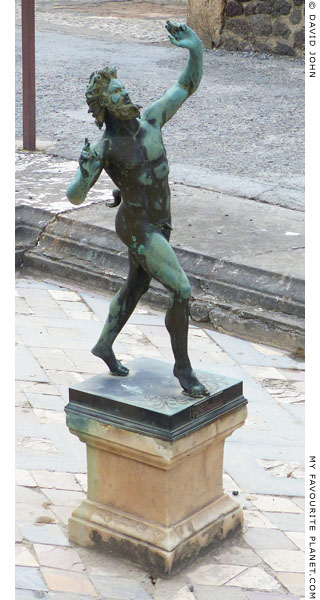
A modern replica of the bronze statuette
of the Dancing Faun after which the
House of the Faun was named.
Tuscan Atrium, House of the Faun (VI, 12, 2),
Pompeii archaeological site.
The Greek original, late 2nd century BC,
is in the National Archaeological Museum,
Naples. Inv. No. 5002. Height 81 cm. |
|
23. Dimensions of the Alexander Mosaic
Dimensions taken from Bernard Andreae, Das Alexandermosaik aus Pompeji, page 9. Verlag Aurel Bongers, Recklinghausen, 1977.
The same figures appear in:
Katherine M. D. Dunbabin, Mosaics of the Greek and Roman World, pages 40-41. Cambridge University Press, 1999. At googlebooks.
John R. Clarke, Domestic decoration: Mosaics and stucco. In: John J. Dobbins and Pedar W. Foss (editors), The world of Pompeii, chapter 21, page 325. Routledge, London and New York, 2007.
I disagree with Professor Clarke's statement that the mosaic is "not an emblema since its large size (5.82 m x 3.13 m with its perspectival geometric border; 5.12 m x 2.71 m without it) required manufacture in situ". Even if the work was indeed originally designed and produced for the location in which it was unearthed in 1831, it does not necessarily follow that it was made there. Large mosaics can be produced in studios and transported to their site of installation in sections just as well as smaller works and emblemata (panels). I have designed and made a larger single-image mosaic, 335 cm high and 959 cm wide, in a studio and divided it into numbered sections for transportion to the site where it now stands. There is no size limit for this simple method when the exact shape and dimensions of a relatively flat surface to be covered are known. Curved, irregularly shaped and uneven surfaces can present particular challenges.
Modern scholarly sources do not agree on the dimensions of the mosaic: 513 x 272 cm, 550 x 242 cm, 555 x 317 cm, 582 x 313 cm, 584 x 317 cm and 592 x 342 cm, etc. are stated by various authors, without citing their sources or making clear whether they are referring to the entire work or only the picture area. The Naples museum's website gives a length of 555 cm and a height of 317 cm, while the official guidebook states 582 x 313 cm.
Rosanna Capelli and Annalisa Lo Monaco, The National Archaeological Museum of Naples: Guide, page 59. Ministero per i Beni el le Attività Culturali Soprintendenza Speciale per i Beni Archeologici di Napoli e Pompei. Mondadori Electra S.p.A., Verona. Second edition, 2014. www.electaweb.it.
I am so far unable to confirm any of these measurements, since I seldom travel with a tape measure. But perhaps somebody ought to do just that.
The German archaeologist Gustav Körte (1852-1917), writing in 1907, quoted the measurements of architect and archaeologist Friedrich Adler (1827-1908): 550 x 242 cm.
G. Koerte, Das Alexandermosaik aus Pompeji, in Mitteilungen des Kaiserlich Deutschen Archaeologischen Instituts, Roemische Abteilung, Band XXII, pages 1-24. Loescher and Co., Rome, 1907. At archive.org.
Friedrich Adler, Die Alexanderschlacht in der Casa del Fauno zu Pompeji, in Deutsche Rundschau, Band 126, Januar–März 1906, pages 189-204 (dimensions and estimated total area of 13.4 square metres on page 199). At the Internet Archive.
The art historian Professor Carlo Bertelli, a mosaic specialist, states 592 x 342 cm. Mosaics, pages 23-25. Arnoldo Mondadori Editore S.p.A., Milan, 1988.
Paulo Stirpe, in the catalogue Imagini del mito: Iconografia di Alessandro Magna in Italia [see note 11], page 151, states 555 x 317 cm, and also gives the invoice number as 9991.
Kevin A. Wohlgemuth, A survey and history of the conservation of the opus vermiculatum mosaics of Pompeii, Catalog Entry 24, page 139. MA thesis, Florida State University College of Arts and Sciences, 2008. States 548 x 317 cm, and dates the mosaic 100-80 BC.
Estimates of the number of tesserae also vary from half a million to 4 million (!) - according to the official guidebook "about a million" - "with 15 to 30 tesserae per square centimetre". While the tightly-set tesserae are much smaller than those of most surviving ancient mosaics, allowing an astonishing amount of fine detail in the image, and have dimensions of 1 - 4 mm, this figure seems too high.
Dr Werner Kruck, member of a team which recently made a reduced-size copy of the mosaic, writes that the original is 582 x 313 cm and has 5-6 tesserae per square cm. See: alexandermosaik.de
24. Repositioning of the Alexander Mosaic in the Naples Museum
See: Pier Giovanni Guzzo, Per la replica del Mosaico di Alessandro, in La Battaglia di Alessandro torno alla Casa del Fauno, pages 2-4. Soprintendenza archeologica di Pompei. Mondadori Electa S.p.A., Milano, 2005. www.electaweb.it.
25. 4th century BC painters of Alexander's battles
The various theories about the identity of the painter whose work may have provided the model for the Alexander Mosaic are based on thin evidence and much speculation. Modern scholars have examined details of the mosaic for evidence concerning which battle is depicted, which individuals (apart from Alexander and Darius) are portrayed, and whether certain traits of style and technique point to the work of a particular artist.
The first two contenders, Philoxenos of Eretria and Aristeides of Thebes are mentioned briefly by Pliny the Elder:
"Philoxenus of Eretria, who painted for King Cassander a picture representing one of the battles between Alexander and Darius, a work which may bear comparison with any."
"Aristides also painted a Battle with the Persians, a picture which contained one hundred figures, for each of which he was paid at the rate of ten minae by Mnason, the tyrant of Elatea."
Pliny the Elder, Natural History, Book 35, chapter 110. At Perseus Digital Library.
Ptolemy Hephaistion (also known as Ptolemaios Chennos) wrote that Helena of Egypt painted the Battle of Issos, and that the picture was exhibited in the Temple of Peace in Rome during the reign of Vespasian (69-79 AD). See the Helena of Egypt page for further details. |
|

Drawing of a Persian soldier in the Alexander
Mosaic, made soon after its discovery.
Source:
Cav. Antonio Niccolini, Quadro in musaico
scoperto in Pompei, a di 24 Ottobre 1831,
Tavalo VI. Dalla Stamperia Reale, Napoli, 1831. |
|
|
26. Aelius Aristides on Alexander's dream in Smyrna
The quotation is from a paper by Carlo Franco on Roman Imperial Smyrna. There are a number of modern editions and compilations of Aristides' works, and although the paper includes a bibliography, the source of the citation (20:7) is not clear. So far I have not found this quote in another publication, or an online edition of the Sacred Tales either in Greek or English, although quotes or fragments may be included in compilations.
See: Carlo Franco, Past and present: Notes on the identity of Roman Imperial Smyrna, page 377. In: The proceedings of the 8th International Colloquium on Problems on Roman provincial art, Zagreb, 5-8 May 2003, pages 373-379. Zagreb, 2005.
In Sacred Tales (Ἱεροὶ λόγοι, Hieroi Logoi), written in six books around 130-171 AD, Aristides wrote of his illness and dreams sent to him by the healing god Asklepios, but also mentioned buildings and aspects of life in Smyrna. For example, he mentioned the temple of Asklepios near the gymnasium and the thermae (public baths), near the Ephesian Gate. The hilltop site was near the sea at the southwest of the city, near the modern Izmir Archaeology Museum and Bahribaba Park (see Pergamon Gallery 2, page 15).
This is probably the sanctuary of Asklepios mentioned by Pausanias, who said that it was established in his time (around 165 AD), based on the Asklepieion at Pergamon (see Pergamon Gallery 1, page 35).
"From the one at Pergamus has been built in our own day the sanctuary of Asclepius by the sea at Smyrna."
Pausanias, Description of Greece, Book 2, chapter 26, section 9. At Perseus Digital Library.
Although early 20th century maps of Izmir mark the site of the Asklepios temple and the neighbouring temple of Vesta on the hill named Deiremtepe (as well as the sites of the stadium and theatre to the east, at the foot of Mount Pagos), the city was devastated by the great fire of 1922 and many ancient sites and ruins still visible before were destroyed or have since been built over.
27. Alexander heads in Izmir
Two small Roman period marble heads, probably from statuettes, found separately in Izmir, have been speculatively identified as "İskender Başı" ("head of Alexander"). Both are in the Izmir Museum of History and Art:
"Erkek Başı (İskender)" ("head of a mann [Alexander]" sic). Inv. No. 002.651. Found in the Smyrna Agora. Height 22cm, width 14cm, depth 12 cm.
"İskender Başı" ("head of Alexander"). Inv. No. 004.380. Found in "Smyrna" in 1961. Height 17 cm, width 12 cm, depth 10 cm. This second is a more convincing candidate as a portrait of Alexander than the first.
See: Serdar Aybek, Izmir Tarih ve Sanat Müzesi, Heykel Kataloğu (Izmir Museum of History and Art, Sculpture catalogue), Nos. 89 and 90, page 96. T.C. Kültür ve Turizm Bakanliği, Kültür Varlıkları ve Müzeler Genel Müdürlüğü, Ankara, 2009. At academia.edu.
28. Alexander ascension imagery
For further discussion about the sources and iconography of the "ascension of Alexander", including photos of several examples, a bibliography and links, see:
Julianna Lees, Representations of the fantastical adventures of Alexander the Great in Romanesque and pre-Romanesque art. A series of papers from different sources with added notes and illustrations, 2012. PDF document at green-man-of-cercles.org.
See also:
A study of the iconography, origins, scholarship and literary sources of ascension images, including an extensive, illustrated catalogue of known Western examples.
Victor M. Schmidt, A legend and its image: The aerial flight of Alexander the Great in Medieval art. Translated by Xandra Bardet. (Mediaevalia Groningana, 17) Egbert Forsten, Groningen, 1995.
Based on his dissertation in Dutch: De luchtvaart van Alexander de Grote in de verbeelding der middeleeuwen. Groningen, 1988.
An illustrated article about the depiction of the "ascension of Alexander" on a 12th century floor mosaic designed by Pantaleone, in Otranto Cathedral, southern Italy.
Alexander in the Middle Ages, in Images of a legend: Iconography of Alexander the Great in Italy, pages 192-198 [see note 12].
29. The so-called "oath of Alexander the Great"
The text of this so-called oath can be found on several websites, most of which do not name the source of what is claimed to be from a speech given by Alexander the Great at Opis (Ὦπις) in Babylon in 324 BC. The text first appeared online in the English translation of an article titled Alexander the Great - Sui Generis, written in Greek in 1983 by Nikolaos K. Martis (Νικόλαος Κ. Μάρτης, 1915-2013), a Macedonian Greek lawyer and right-wing politician from the village of Moustheni (Μουσθένη), near Kavala. He held a number of senior political posts in Greece, including that of Minister of Northern Greece (Macedonia and Thrace) 1974-1981.
The English version of the article:
Nicholas Martis, Alexander the Great - Sui Generis, translated by Professor Nina Gatzoulis. At the website of the Hellenic Communication Service (HCS).
The article consists mostly of excerpts from his book The falsification of Macedonian history (translated by John Philip Smith, Alexander S. Onassis Public Benefit Foundation, Athens, 1984; other editions since). In the article the "oath" is in the form of a list of what Martis claimed to be "the main points which he [Alexander] made in this speech". However, he does not provide citations for these points, although in his book he ascribes the oath to Zolakostas "in his book Alexander the Great, Precursor of Christ (p. 235, in Greek text), who quoted the 3rd book of Pseudo-Callisthenes and the philosopher Eratosthenes" (page 69).
For critical discussion of Martis' article, See:
Jason C. Mavrovitis, Alexander the Great - Sui Generis by Nicholas Martis - Revisited. Also at the HCS website.
Martis' defence of his article, "In response to those who question the historical validity of Alexander’s Oath at Opis, I submit the following document, which proves the essence of its contents":
Nicholas Martis, Historical sources regarding the contents of Alexander the Great's speech at Opis. At the HCS website.
The pages containing each of the three articles include a link to the other two.
30. The rock-face at Asprovalta
From the west side of Asprovalta a dirt track winds and climbs steeply up to the rock, tucked behind which is the late 16th century church of Agios Georgios (Εκκλησία Άγιος Γεώργιος, usually closed). The untypically-designed stone basilica was built by monks from Mount Athos, perhaps of the Simonopetra Monastery (Μονή Σίμωνος Πέτρας). It was part of the Monastery of Agios Georgios that formed the original settlement at Asprovalta, in the area said to have previously been infested by pirates or robbers. The modern municipality Agios Georgios (now part of the Volvi municipality), which also includes Vrasna and Nea Vrasna, was named after the monastery.
Remains of a Roman period villa discovered at Asprovalta indicate that the area was inhabited earlier, though evidently later abandoned. A model of the villa is exhibited in the Thessaloniki Archaeological Museum.
From the church it is possible to walk on to the top of this rock and enjoy the panoramic view over the Strymonic Gulf as far as Mount Athos. The best time to visit in the summer is early morning before it gets too hot and the heat haze over gulf hides the view. |
|
|
| |
Photos on this page were taken during visits to the following museums:
Germany
Berlin, Altes Museum
Berlin, Bode Museum
Berlin, Pergamon Museum
Dresden, Albertinum, Skulpturensammlung
Dresden, Semperbau, Antikenhalle (Hall of Antiquities)
Hamburg, Museum für Kunst und Gewerbe
Leipzig, University of Leipzig Museum of Antiquities
Greece
Athens, Acropolis Museum
Athens, Agora Museum
Athens, Museum of Cycladic Art
Athens, National Archaeological Museum
Athens, Numismatic Museum
Chalkis, New Archaeological Museum "Arethousa"
Chalkis, Karababa Fortress, Exhibition of Architectural Sculptures
Corfu, Museum of Mon Repos
Delos Archaeological Museum
Delphi Archaeological Site
Komotini Archaeological Museum
Kos Archaeological Museum
Olympia Archaeological Museum and site
Olympia, Museum of the History of the Olympic Games of Antiquity
Pella Archaeological Museum, Macedonia
Piraeus Archaeological Museum
Rhodes Archaeological Museum, Dodecanese
Rhodes, Palace of the Grand Master
Thasos Archaeological Museum, Macedonia
Thebes Archaeological Museum
Thessaloniki Archaeological Museum, Macedonia
Veria Archaeological Museum, Macedonia
Italy
Milan, Civic Archaeological Museum
Naples, National Archaeological Museum
Pompeii archaeological site
Rome, archaeological site of the Theatre of Marcellus and Portico of Octavia
Rome, Barracco Museum
Rome, Capitoline Museums, Palazzo dei Conservatori
Rome, Capitoline Museums, Palazzo Nuovo
Rome, National Museum of Rome, Palazzo Massimo alle Terme
Italy - Sicily
Catania, Museo Civico, Castello Ursino
Netherlands
Amsterdam, Allard Pierson Museum
Amsterdam, Rijksmuseum
Turkey
Istanbul Archaeological Museums
Izmir, Agora archaeological site
Izmir Museum of History and Art
Izmir, Old Smyrna archaeological site, Bayraklı
Priene archaeological site
United Kingdom
London, British Museum
Oxford, Ashmolean Museum
Many thanks to the staff of these museums. |
More photos and information
about mosaics
on My Favourite Planet
Hellenistic mosaics in Pella, Macedonia, Greece
A mosaic of Dionysos and "Sleeping Ariadne"
from Ephesus, now in the
Izmir Archaeological Museum, Turkey:
Selcuk photo gallery 2
A Hellenistic mosaic, signed by Hephaistion,
from Pergamon, Turkey, now in
the Pergamon Museum, Berlin:
Pergamon photo gallery 2
Ancient mosaics depicting the Gorgon Medusa
Mosaics from Pompeii
signed by Dioskourides of Samos
Mosaics at Dion Archaeological Site,
Macedonia, Greece:
Dion: garden of the Gods
at the Cheshire Cat Blog
"Choklakia" mosaics in Kastellorizo, Greece:
Kastellorizo photo gallery
Mosaics of Saint John the Theologian,
on Patmos, Greece:
Patmos photo gallery
Modern mosaic commemorating Saint Paul
the Apostle's visit to Veria, Macedonia, Greece:
Veria photo gallery
See also a mosaic mural made
by the author of this guide:
davidjohnberlin.de
|
|
| Photos and articles © David John, except where otherwise specified. |
 |
Visit the My Favourite Planet Group on Facebook.
Join the group, write a message or comment,
post photos and videos, start a discussion... |
|
|
| |
| Copyright © 2003-2025 My Favourite Planet | contents | contributors | impressum | sitemap |
| |




